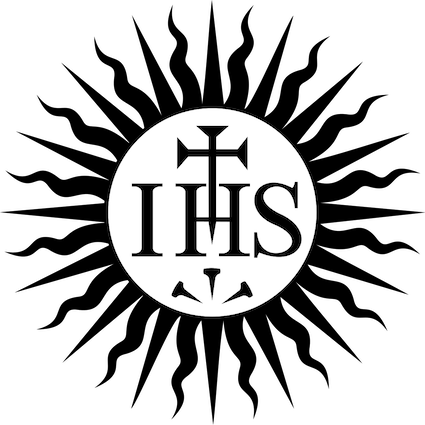
イエズス会
Jesuits

☆イエズス会(ラ
テン語: Societas Iesu、略称: SJ)は、イエズス会修道会またはイエズス会士(/ˈdʒɛʒuɪts, ˈdʒɛzju-/
JEZH-oo-its, JEZ-ew-;[2] ラテン語:
Iesuitae)とも呼ばれ、[3]ローマに本部を置くカトリック教会の男子修道会である。1540年にパウロ3世の承認のもと、イグナティウス・デ・
ロヨラと6人の仲間によって創設された。今日、イエズス会は112カ国で伝道と使徒職に従事している。イエズス会士は教育、研究、文化活動に従事してい
る。また、イエズス会士は黙想会を主催し、病院や教区で奉仕活動を行い、直接的な社会事業や人道支援を後援し、エキュメニカルな対話を推進している。
イエズス会は、聖母マリアの称号である「マドンナ・デラ・ストラーダ」の庇護の下に設立され、総長によって統率されている。[4][5]
本部である一般参事会はローマにある。[6]
歴史的なイグナチオの参事会は、イエズス会の母教会であるジェズ教会に併設されたコレジオ・デル・ジェズの一部となっている。
イエズス会の会員は「永遠の貧困、貞潔、服従」を誓い、「宣教活動に関して、教皇に特別な服従を誓う」ことになっている。イエズス会員は、完全に利用可能
であり、上級者に服従することが期待されており、極端な環境での生活を要求された場合でも、世界のどこへでも行くことを命じられる。創設者のイグナティウ
スは、軍歴を持つ貴族であった。イエズス会の設立文書の冒頭には、イエズス会は「神の兵士として奉仕することを望む者[a]、特に信仰の擁護と布教、キリ
スト教の生活と教義における魂の向上のために努力する者」のために設立されたと宣言されている。[7]
そのためイエズス会士は俗に「神の兵士」[8]、「神の海兵隊員」[9]、「会社」[10]と呼ばれることもある。イエズス会は対抗宗教改革に参加し、そ
の後、第2バチカン公会議の実施にも関与した。
イエズス会の宣教師たちは16世紀から18世紀にかけて世界中に布教所を設立し、現地住民のキリスト教化に成功と失敗の両方を経験した。イエズス会はカト
リック教会内で常に論争の的となっており、世俗の政府や機関とたびたび衝突してきた。1759年以降、カトリック教会はヨーロッパのほとんどの国々および
ヨーロッパの植民地からイエズス会を追放した。1773年、教皇クレメンス14世は正式にイエズス会を解散した。1814年、教会は解散を解除した。
| The Society of Jesus
(Latin: Societas Iesu; abbreviation: SJ), also known as the Jesuit
Order or the Jesuits (/ˈdʒɛʒuɪts, ˈdʒɛzju-/ JEZH-oo-its, JEZ-ew-;[2]
Latin: Iesuitae),[3] is a religious order of clerics regular of
pontifical right for men in the Catholic Church headquartered in Rome.
It was founded in 1540 by Ignatius of Loyola and six companions, with
the approval of Pope Paul III. Today, the Society of Jesus is engaged
in evangelization and apostolic ministry in 112 countries. Jesuits work
in education, research, and cultural pursuits. Jesuits also conduct
retreats, minister in hospitals and parishes, sponsor direct social and
humanitarian works, and promote ecumenical dialogue. The Society of Jesus is consecrated under the patronage of Madonna della Strada, a title of the Blessed Virgin Mary, and it is led by a superior general.[4][5] The headquarters of the society, its general curia, is in Rome.[6] The historic curia of Ignatius is now part of the Collegio del Gesù attached to the Church of the Gesù, the Jesuit mother church. Members of the Society of Jesus make profession of "perpetual poverty, chastity, and obedience" and "promise a special obedience to the sovereign pontiff in regard to the missions." A Jesuit is expected to be totally available and obedient to his superiors, accepting orders to go anywhere in the world, even if required to live in extreme conditions. Ignatius, its leading founder, was a nobleman who had a military background. The opening lines of the founding document of the Society of Jesus accordingly declare that it was founded for "whoever desires to serve as a soldier of God,[a] to strive especially for the defense and propagation of the faith, and for the progress of souls in Christian life and doctrine".[7] Jesuits are thus sometimes referred to colloquially as "God's soldiers",[8] "God's marines",[9] or "the Company".[10] The Society of Jesus participated in the Counter-Reformation and, later, in the implementation of the Second Vatican Council. Jesuit missionaries established missions around the world from the 16th to the 18th century and had both successes and failures in Christianizing the native peoples. The Jesuits have always been controversial within the Catholic Church and have frequently clashed with secular governments and institutions. Beginning in 1759, the Catholic Church expelled Jesuits from most countries in Europe and from European colonies. Pope Clement XIV officially suppressed the order in 1773. In 1814, the Church lifted the suppression. |
イエズス会(ラテン語: Societas Iesu、略称:
SJ)は、イエズス会修道会またはイエズス会士(/ˈdʒɛʒuɪts, ˈdʒɛzju-/ JEZH-oo-its, JEZ-ew-;[2]
ラテン語:
Iesuitae)とも呼ばれ、[3]ローマに本部を置くカトリック教会の男子修道会である。1540年にパウロ3世の承認のもと、イグナティウス・デ・
ロヨラと6人の仲間によって創設された。今日、イエズス会は112カ国で伝道と使徒職に従事している。イエズス会士は教育、研究、文化活動に従事してい
る。また、イエズス会士は黙想会を主催し、病院や教区で奉仕活動を行い、直接的な社会事業や人道支援を後援し、エキュメニカルな対話を推進している。 イエズス会は、聖母マリアの称号である「マドンナ・デラ・ストラーダ」の庇護の下に設立され、総長によって統率されている。[4][5] 本部である一般参事会はローマにある。[6] 歴史的なイグナチオの参事会は、イエズス会の母教会であるジェズ教会に併設されたコレジオ・デル・ジェズの一部となっている。 イエズス会の会員は「永遠の貧困、貞潔、服従」を誓い、「宣教活動に関して、教皇に特別な服従を誓う」ことになっている。イエズス会員は、完全に利用可能 であり、上級者に服従することが期待されており、極端な環境での生活を要求された場合でも、世界のどこへでも行くことを命じられる。創設者のイグナティウ スは、軍歴を持つ貴族であった。イエズス会の設立文書の冒頭には、イエズス会は「神の兵士として奉仕することを望む者[a]、特に信仰の擁護と布教、キリ スト教の生活と教義における魂の向上のために努力する者」のために設立されたと宣言されている。[7] そのためイエズス会士は俗に「神の兵士」[8]、「神の海兵隊員」[9]、「会社」[10]と呼ばれることもある。イエズス会は対抗宗教改革に参加し、そ の後、第2バチカン公会議の実施にも関与した。 イエズス会の宣教師たちは16世紀から18世紀にかけて世界中に布教所を設立し、現地住民のキリスト教化に成功と失敗の両方を経験した。イエズス会はカト リック教会内で常に論争の的となっており、世俗の政府や機関とたびたび衝突してきた。1759年以降、カトリック教会はヨーロッパのほとんどの国々および ヨーロッパの植民地からイエズス会を追放した。1773年、教皇クレメンス14世は正式にイエズス会を解散した。1814年、教会は解散を解除した。 |
| History Foundation 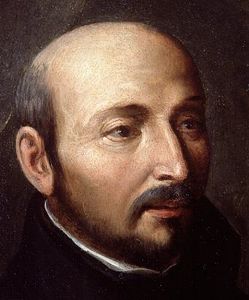 Ignatius of Loyola Ignatius of Loyola, a Basque nobleman from the Pyrenees area of northern Spain, founded the society after discerning his spiritual vocation while recovering from a wound sustained in the Battle of Pamplona. He composed the Spiritual Exercises to help others follow the teachings of Jesus Christ. On 15 August 1534, Ignatius of Loyola (born Íñigo López de Loyola), a Spaniard from the Basque city of Loyola, and six others mostly of Castilian origin, all students at the University of Paris,[11] met in Montmartre outside Paris, in a crypt beneath the church of Saint Denis, now Saint Pierre de Montmartre, to pronounce promises of poverty, chastity, and obedience.[12] Ignatius' six companions were: Francisco Xavier from Navarre (modern Spain), Alfonso Salmeron, Diego Laínez, Nicolás Bobadilla from Castile (modern Spain), Peter Faber from Savoy, and Simão Rodrigues from Portugal.[13] The meeting has been commemorated in the Martyrium of Saint Denis, Montmartre. They called themselves the Compañía de Jesús, and also Amigos en El Señor or "Friends in the Lord", because they felt "they were placed together by Christ." The name "company" had echoes of the military (reflecting perhaps Ignatius' background as Captain in the Spanish army) as well as of discipleship (the "companions" of Jesus). The Spanish "company" would be translated into Latin as societas like in socius, a partner or comrade. From this came "Society of Jesus" (SJ) by which they would be known more widely.[14] Religious orders established in the medieval era were named after particular men: Francis of Assisi (Franciscans); Domingo de Guzmán, later canonized as Saint Dominic (Dominicans); and Augustine of Hippo (Augustinians). Ignatius of Loyola and his followers appropriated the name of Jesus for their new order, provoking resentment by other orders who considered it presumptuous. The resentment was recorded by Jesuit José de Acosta of a conversation with the Archbishop of Santo Domingo.[15] In the words of one historian: "The use of the name Jesus gave great offense. Both on the Continent and in England, it was denounced as blasphemous; petitions were sent to kings and to civil and ecclesiastical tribunals to have it changed; and even Pope Sixtus V had signed a Brief to do away with it." But nothing came of all the opposition; there were already congregations named after the Trinity and as "God's daughters".[16] In 1537, the seven travelled to Italy to seek papal approval for their order. Pope Paul III gave them a commendation, and permitted them to be ordained priests. These initial steps led to the official founding in 1540. They were ordained in Venice by the bishop of Arbe (24 June). They devoted themselves to preaching and charitable work in Italy. The Italian War of 1536–1538 renewed between Charles V, Holy Roman Emperor, Venice, the Pope, and the Ottoman Empire, had rendered any journey to Jerusalem impossible. Again in 1540, they presented the project to Paul III. After months of dispute, a congregation of cardinals reported favourably upon the Constitution presented, and Paul III confirmed the order through the bull Regimini militantis ecclesiae ("To the Government of the Church Militant"), on 27 September 1540. This is the founding document of the Society of Jesus as an official Catholic religious order. Ignatius was chosen as the first Superior General. Paul III's bull had limited the number of its members to sixty. This limitation was removed through the bull Exposcit debitum of Julius III in 1550.[17] In 1543, Peter Canisius entered the Company. Ignatius sent him to Messina, where he founded the first Jesuit college in Sicily. Ignatius laid out his original vision for the new order in the "Formula of the Institute of the Society of Jesus",[18] which is "the fundamental charter of the order, of which all subsequent official documents were elaborations and to which they had to conform".[19] He ensured that his formula was contained in two papal bulls signed by Pope Paul III in 1540 and by Pope Julius III in 1550.[18] The formula expressed the nature, spirituality, community life, and apostolate of the new religious order. Its famous opening statement echoed Ignatius' military background: 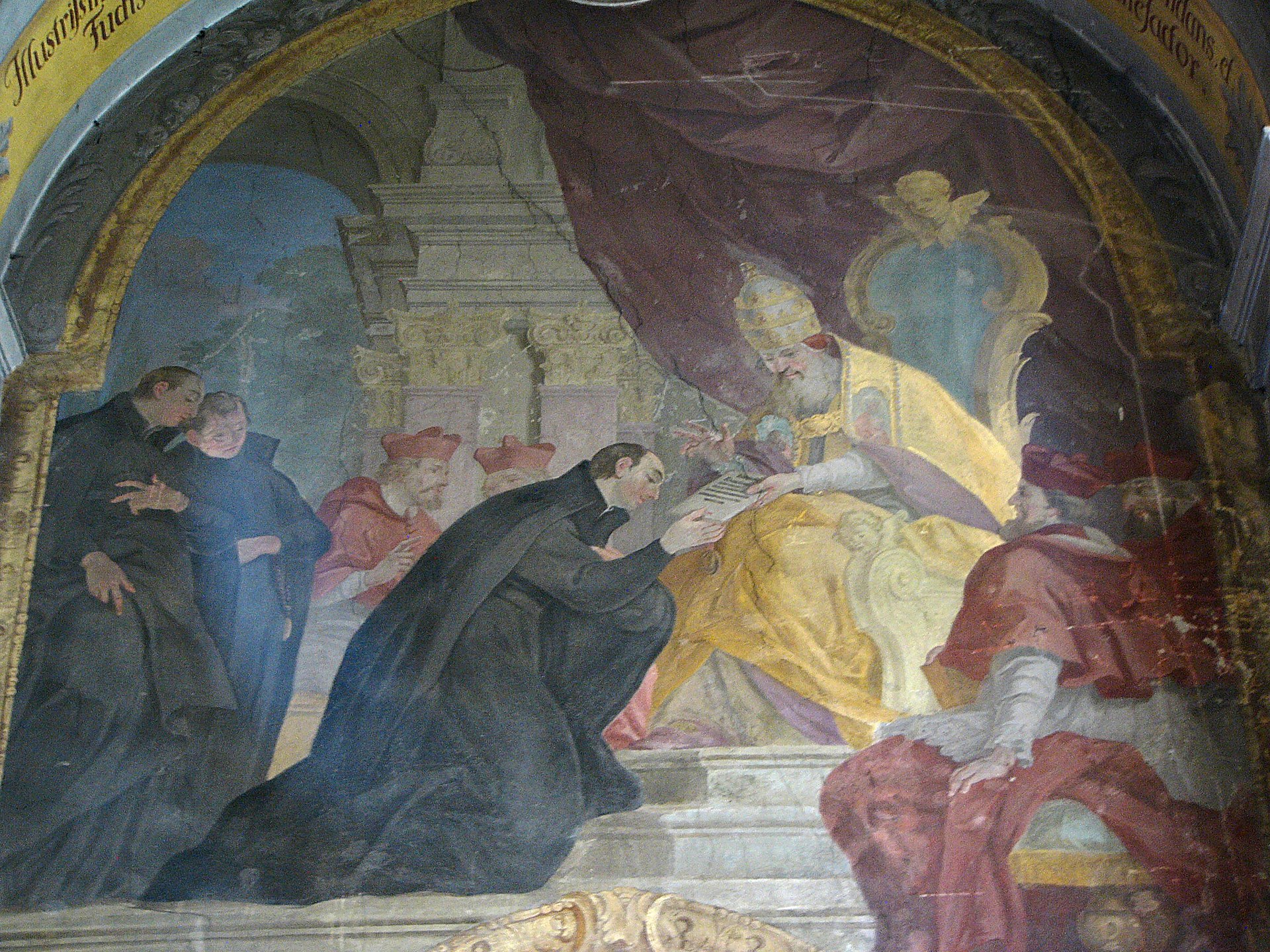 A fresco depicting Ignatius receiving the papal bull from Pope Paul III was created after 1743 by Johann Christoph Handke in the Church of Our Lady Of the Snow in Olomouc. Whoever desires to serve as a soldier of God beneath the banner of the Cross in our Society, which we desire to be designated by the Name of Jesus, and to serve the Lord alone and the Church, his spouse, under the Roman Pontiff, the Vicar of Christ on earth, should, after a solemn vow of perpetual chastity, poverty and obedience, keep what follows in mind. He is a member of a Society founded chiefly for this purpose: to strive especially for the defence and propagation of the faith and for the progress of souls in Christian life and doctrine, by means of public preaching, lectures and any other ministration whatsoever of the Word of God, and further by means of retreats, the education of children and unlettered persons in Christianity, and the spiritual consolation of Christ's faithful through hearing confessions and administering the other sacraments. Moreover, he should show himself ready to reconcile the estranged, compassionately assist and serve those who are in prisons or hospitals, and indeed, to perform any other works of charity, according to what will seem expedient for the glory of God and the common good.[20] |
歴史 設立  イグナチオ・デ・ロヨラ スペイン北部ピレネー山脈地方出身のバスク貴族イグナチオ・デ・ロヨラは、パンプローナの戦いで負った傷の療養中に自らの霊的使命を悟り、この会を設立した。彼は、人々がイエス・キリストの教えに従うことができるよう、『霊操』を著した。 1534年8月15日、バスク地方のロヨラ出身のスペイン人イグナチオ・デ・ロヨラ(本名イニゴ・ロペス・デ・ロヨラ)と、主にカスティーリャ出身の6人 の仲間(全員がパリの大学で学んでいた)は、パリ郊外のモンマルトルにあるサン・ドニ教会(現サン・ピエール・ド・モンマルトル)の地下聖堂で貧困、貞 操、服従の誓いを立てるために集まった。イグナチオの6人の仲間は、 ナバラ(現スペイン)出身のフランシスコ・ザビエル、アルフォンソ・サレモン、ディエゴ・ライネス、カスティーリャ(現スペイン)出身のニコラス・ボバ ディージョ、サヴォイア出身のペドロ・フェイバー、ポルトガル出身のシマオ・ロドリゲスであった。[13] この会合は、モンマルトルのサン・ドニの殉教を記念して祝われている。彼らは自らを「イエズス会」と呼び、また「主の友」または「主における友」とも呼ん だ。なぜなら、「キリストによって共に置かれた」と感じていたからである。「カンパニー」という名称には、軍隊を連想させる響き(おそらくイグナティウス がスペイン軍の大尉であったことが反映されている)と、弟子であること(イエスの「仲間」)の両方の意味合いがあった。スペイン語の「カンパニー」はラテ ン語ではsocietasと訳され、socius(パートナー、仲間)と同様である。これが転じて「イエズス会」(Society of Jesus、SJ)と呼ばれるようになり、彼らは広く知られるようになった。 中世に設立された修道会は特定の人物の名にちなんで名付けられた。アッシジのフランチェスコ(フランシスコ会)、ドミンゴ・デ・グスマン(後に聖ドミニク として列聖された)(ドミニコ会)、ヒッポのアウグスティヌス(アウグスティノ会)などである。イグナティウス・ロヨラとその信奉者たちは、自分たちの新 しい修道会にイエスの名を付けたが、それは他の修道会から思い上がっているとみなされ、反感を買った。この反感は、イエズス会のホセ・デ・アコスタがサン ト・ドミンゴ大司教との会話から記録している。[15] ある歴史家の言葉を借りれば、「イエズス会の名称の使用は大きな反感を買った。大陸でもイングランドでも、それは冒涜的であるとして非難され、名称の変更 を求める嘆願書が王や民事・宗教裁判所に送られた。シクストゥス5世法王でさえ、それを廃止する旨の簡潔な文書に署名した」 しかし、こうした反対運動はすべて無駄に終わり、すでに三位一体の名を冠した集会が存在し、「神の娘たち」と呼ばれていた。[16] 1537年、7人は自分たちの修道会の教皇の承認を求めてイタリアを訪れた。教皇パウルス3世は彼らを称賛し、司祭に叙階することを許可した。こうした初期の動きが、1540年の正式な設立につながった。 彼らは6月24日にアルベの司教によりヴェネツィアで叙階された。彼らはイタリアで布教と慈善活動に専念した。1536年から1538年にかけてのイタリ ア戦争は、神聖ローマ皇帝カール5世、ヴェネツィア共和国、教皇、オスマン帝国の間で再燃し、エルサレムへの旅は不可能となった。 1540年に再び、彼らはその計画をパウルス3世に提出した。数か月にわたる論争の後、枢機卿団は提出された憲章を好意的に報告し、パウルス3世は 1540年9月27日、雄牛レギミニ・ミリタンティス・エクレジア(「闘う教会の統治」)により、その計画を承認した。これは、カトリックの正式な修道会 としてのイエズス会の設立文書である。イグナティウスは初代総長に選ばれた。パウルス3世の勅書では会員数は60人に制限されていた。この制限は、 1550年にユリウス3世が発布した勅書「Exposit debitum」によって撤廃された。 1543年、ペトロ・カニシウスがイエズス会に入会した。イグナティウスは彼をメッシーナに派遣し、そこで彼はシチリアで最初のイエズス会カレッジを創設した。 イグナティウスは「イエズス会設立の定式」において、新しい秩序に対する自身の当初の構想を明らかにした。これは「その後のすべての公式文書がその詳細を 記し、それに従うべきものとなる、その秩序の基本憲章」である。[19] 彼は、1540年にパウルス3世が、1550年にユリウス3世が署名した2つの教皇勅書に、この定式が確実に含まれるようにした。[18] 定式は、新しい宗教団体の性質、精神性、共同生活、使徒職を表現した。その有名な冒頭の文言は、イグナティウスの軍隊での経歴を反映したものである。  イグナティウスが教皇パウルス3世から教皇綬章を受け取る様子を描いたフレスコ画は、1743年以降にオロモウツの雪の聖母教会でヨハン・クリストフ・ハンドケによって描かれた。 イエスの名で呼ばれることを望む私たちの社会において、十字架の旗印のもとで神の兵士として仕え、ローマ教皇のもとで主と教会(すなわち、キリストの代理 人である教会)にのみ仕えたいと望む者は、永遠の貞操、清貧、服従を厳粛に誓った後、以下のことを心に留めておくべきである。彼は、主にこの目的のために 設立された協会の会員である。すなわち、公の説教、講義、その他神の言葉のあらゆる伝達手段によって、またさらに、隠遁生活、キリスト教における子供や文 盲の人々の教育、告白の聴聞やその他の秘跡の執行を通じてキリストの忠実な者たちの霊的な慰めを与えることによって、信仰の擁護と普及、キリスト教的生活 と教義における魂の進歩のために特に努力することである。さらに、彼は、疎遠になっている人々を和解させる用意があることを示し、慈悲深く、刑務所や病院 にいる人々を助け、奉仕し、そして、神の栄光と公共の利益のために有益であると思われる他の慈善活動を行うべきである。[20] |
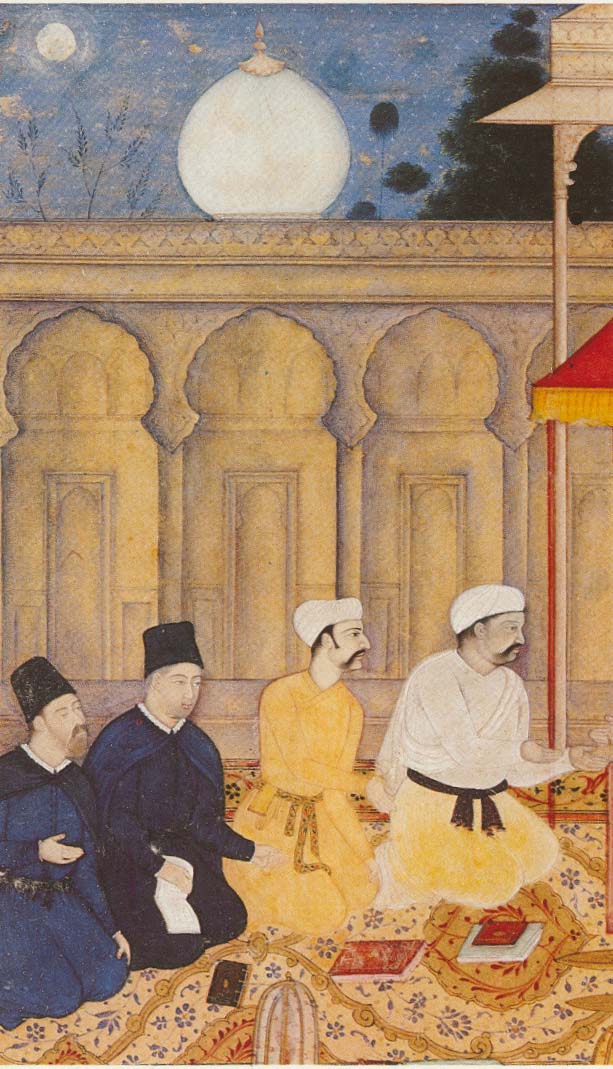 Jesuits at Akbar's court in India, c. 1605 In fulfilling the mission of the "Formula of the Institute of the Society", the first Jesuits concentrated on a few key activities. First, they founded schools throughout Europe. Jesuit teachers were trained in both classical studies and theology, and their schools reflected this. These schools taught with a balance of Aristotelian methods with mathematics.[21] Second, they sent out missionaries across the globe to evangelize those peoples who had not yet heard the Gospel, founding missions in widely diverse regions such as modern-day Paraguay, Japan, Ontario, and Ethiopia. One of the original seven arrived in India already in 1541.[22] Finally, though not initially formed for the purpose, they aimed to stop Protestantism from spreading and to preserve communion with Rome and the pope. The zeal of the Jesuits overcame the movement toward Protestantism in the Polish–Lithuanian Commonwealth and southern Germany. Ignatius wrote the Jesuit Constitutions, adopted in 1553, which created a centralised organization and stressed acceptance of any mission to which the pope might call them.[23][24][25] His main principle became the unofficial Jesuit motto: Ad Maiorem Dei Gloriam ("For the greater glory of God"). This phrase is designed to reflect the idea that any work that is not evil can be meritorious for the spiritual life if it is performed with this intention, even things normally considered of little importance.[17] The Society of Jesus is classified among institutes as an order of clerks regular, that is, a body of priests organized for apostolic work, and following a religious rule. The term Jesuit (of 15th-century origin, meaning "one who used too frequently or appropriated the name of Jesus") was first applied to the society in reproach (1544–1552).[26] The term was never used by Ignatius of Loyola, but over time, members and friends of the society adopted the name with a positive meaning.[16] While the order is limited to men, Joanna of Austria, Princess of Portugal, favored the order and she is reputed to have been admitted surreptitiously under a male pseudonym.[27] |
 インドのアクバル王宮のイエズス会士、1605年頃 「ソシエダス・イェズス会定式」の使命を果たすため、最初のイエズス会士たちはいくつかの主要な活動に集中した。まず、彼らはヨーロッパ各地に学校を設立 した。イエズス会の教師たちは古典学と神学の両方で訓練を受け、彼らの学校にもそれが反映された。これらの学校では、アリストテレスの方法と数学をバラン スよく教えた。[21] 第二に、彼らは福音をまだ聞いていない人々を改宗させるために、世界中に宣教師を派遣し、現代のパラグアイ、日本、オンタリオ、エチオピアなど、広範囲に わたる地域に布教所を設立した。1541年には、最初の7人のうちの1人がすでにインドに到着していた。[22] 当初は目的としていなかったが、最終的にはプロテスタントの拡大を阻止し、ローマおよび教皇との交わりを維持することを目指した。イエズス会の熱心な活動 により、ポーランド・リトアニア共和国および南ドイツにおけるプロテスタントへの動きは阻止された。 イグナティウスは1553年に採択されたイエズス会憲章を書き、中央集権的な組織を作り、教皇が命じる任務はすべて受け入れることを強調した。[23] [24][25] 彼の主な原則は非公式のイエズス会のモットーとなった。「Ad Maiorem Dei Gloriam(神のより大きな栄光のために)」である。このフレーズは、たとえ通常は些細なものと見なされるものであっても、この意図をもって行われる のであれば、悪ではないあらゆる仕事は精神生活にとって有益となり得るという考え方を反映したものである。 イエズス会は、聖職者会として、すなわち使徒的活動のために組織された聖職者の団体として、修道会の規則に従うものとして分類されている。 イエズス会という名称(15世紀に由来し、「イエスの名を頻繁に用いたり、その名を勝手に用いたりする者」を意味する)は、1544年から1552年にか けての非難の期間に初めてこの団体に適用された。[26] この名称はイグナティウス・デ・ロヨラによって用いられたことは一度もなかったが、時が経つにつれ、この団体の会員や友人たちが肯定的な意味でこの名称を 採用するようになった。[16] この修道会は男性のみに限定されているが、ポルトガルの王女であるオーストリアのヨアンナは、この修道会を好み、男性名を偽名としてひそかに入会したとされている。[27] |
Early works Ratio Studiorum, 1598 This section needs additional citations for verification. Please help improve this article by adding citations to reliable sources in this section. Unsourced material may be challenged and removed. (August 2020) (Learn how and when to remove this message) The Jesuits were founded just before the Council of Trent (1545–1563) and ensuing Counter-Reformation that would introduce reforms within the Catholic Church, and so counter the Protestant Reformation throughout Catholic Europe. Ignatius and the early Jesuits did recognize, though, that the hierarchical church was in dire need of reform. Some of their greatest struggles were against corruption, venality, and spiritual lassitude within the Catholic Church. Ignatius insisted on a high level of academic preparation for the clergy in contrast to the relatively poor education of much of the clergy of his time. The Jesuit vow against "ambitioning prelacies" can be seen as an effort to counteract another problem evidenced in the preceding century. Ignatius and the Jesuits who followed him believed that the reform of the church had to begin with the conversion of an individual's heart. One of the main tools the Jesuits have used to bring about this conversion is the Ignatian retreat, called the Spiritual Exercises. During a four-week period of silence, individuals undergo a series of directed meditations on the purpose of life and contemplations on the life of Christ. They meet regularly with a spiritual director who guides their choice of exercises and helps them to develop a more discerning love for Christ. The retreat follows a "Purgative-Illuminative-Unitive" pattern in the tradition of the spirituality of John Cassian and the Desert Fathers. Ignatius' innovation was to make this style of contemplative mysticism available to all people in active life. Further, he used it as a means of rebuilding the spiritual life of the church. The Exercises became both the basis for the training of Jesuits and one of the essential ministries of the order: giving the exercises to others in what became known as "retreats". The Jesuits' contributions to the late Renaissance were significant in their roles both as a missionary order and as the first religious order to operate colleges and universities as a principal and distinct ministry.[21] By the time of Ignatius' death in 1556, the Jesuits were already operating a network of 74 colleges on three continents. A precursor to liberal education, the Jesuit plan of studies incorporated the Classical teachings of Renaissance humanism into the Scholastic structure of Catholic thought.[21] This method of teaching was important in the context of the Scientific Revolution, as these universities were open to teaching new scientific and mathematical methodology. Further, many important thinkers of the Scientific Revolution were educated by Jesuit universities.[21] In addition to the teachings of faith, the Jesuit Ratio Studiorum (1599) would standardize the study of Latin, Greek, classical literature, poetry, and philosophy as well as non-European languages, sciences, and the arts. Furthermore, Jesuit schools encouraged the study of vernacular literature and rhetoric, and thereby became important centres for the training of lawyers and public officials. The Jesuit schools played an important part in winning back to Catholicism a number of European countries which had for a time been predominantly Protestant, notably Poland and Lithuania. Today, Jesuit colleges and universities are located in over one hundred nations around the world. Under the notion that God can be encountered through created things and especially art, they encouraged the use of ceremony and decoration in Catholic ritual and devotion. Perhaps as a result of this appreciation for art, coupled with their spiritual practice of "finding God in all things", many early Jesuits distinguished themselves in the visual and performing arts as well as in music. The theater was a form of expression especially prominent in Jesuit schools.[28] Jesuit priests often acted as confessors to kings during the early modern period. They were an important force in the Counter-Reformation and in the Catholic missions, in part because their relatively loose structure (without the requirements of living and celebration of the Liturgy of Hours in common) allowed them to be flexible and meet diverse needs arising at the time.[29] |
初期の作品 『学問の比』(Ratio Studiorum)1598年 この節には検証可能な参考文献や出典が全く示されていないか、不十分です。出典を追加して記事の信頼性向上にご協力ください。 出典の無い内容は疑問視されたり、削除されることがあります。 (2020年8月) (Learn how and when to remove this message) イエズス会は、カトリック教会内部の改革を導入し、カトリックのヨーロッパ全域でプロテスタントの改革に対抗する、トレント公会議(1545年-1563年)とその後の対抗宗教改革の直前に設立された。 しかし、イグナティウスと初期のイエズス会は、ヒエラルキー化された教会が改革を必要としていることを認識していた。彼らの最大の闘争のいくつかは、カト リック教会内の腐敗、堕落、精神的な倦怠感に対するものであった。イグナティウスは、当時の聖職者の多くが比較的貧しい教育しか受けていなかったのに対 し、聖職者には高度な学問的準備が必要であると主張した。イエズス会の「高位聖職者への野心」を禁ずる誓いは、前世紀に明らかになったもうひとつの問題に 対抗する努力と見なすことができる。 イグナティウスと彼に従うイエズス会士たちは、教会の改革は個人の心の改心から始めなければならないと信じていた。イエズス会がこの改心をもたらすために 用いた主な手段のひとつが、霊操と呼ばれるイグナチオ黙想会である。4週間の沈黙の期間中、参加者は人生の目的についての一連の指示瞑想とキリストの生涯 についての黙想を行う。彼らは定期的に霊的指導者と面会し、その指導者がエクササイズの選択を指導し、キリストへのより深い愛を育む手助けをする。 この黙想は、ヨハネス・カッシアヌスや砂漠の父祖たちの霊性に関する伝統に則った「浄化-啓示-一致」のパターンに従っている。イグナチオの革新は、この 瞑想的な神秘主義のスタイルを、活動的な生活を送るすべての人々に利用できるようにしたことである。さらに、彼はこれを教会の精神生活を再建する手段とし て用いた。この「鍛錬」は、イエズス会の修練の基礎となり、また、その修道会の必須の任務のひとつとなった。すなわち、この「鍛錬」を他の人々に与えるこ とであり、これは「黙想会」として知られるようになった。 イエズス会の後期ルネサンスへの貢献は、布教活動を行う修道会として、また、大学やカレッジを運営する最初の宗教団体として、重要な役割を果たした。 1556年にイグナティウスが死去した時点で、イエズス会はすでに3つの大陸に74のカレッジのネットワークを運営していた。リベラル教育の先駆けとなる イエズス会の教育計画は、ルネサンス期の人文主義の古典的教えをカトリックの学問体系に組み込んだものであった。[21] これらの大学は新しい科学や数学の方法論の教育にも門戸を開いていたため、この教育方法は科学革命の文脈において重要であった。さらに、科学革命の多くの 重要な思想家たちはイエズス会の大学で教育を受けていた。[21] イエズス会の教育方針(1599年)では、信仰の教えに加えて、ラテン語、ギリシャ語、古典文学、詩、哲学、および非ヨーロッパ言語、科学、芸術の学習を 標準化していた。さらに、イエズス会の学校では、自国文学や修辞学の研究を奨励し、それによって弁護士や公務員の養成の重要な拠点となった。 イエズス会の学校は、一時的にプロテスタントが優勢であったヨーロッパの多くの国々、特にポーランドやリトアニアをカトリックに復帰させる上で重要な役割 を果たした。今日、イエズス会の大学は世界100カ国以上に存在する。神は被造物、特に芸術を通して出会うことができるという考えに基づき、彼らはカト リックの儀式や信心における儀式や装飾の使用を奨励した。おそらく、この芸術に対する評価と「あらゆるものの中に神を見出す」という精神的な実践が結びつ いた結果、初期のイエズス会の多くのメンバーが音楽だけでなく視覚芸術や舞台芸術の分野でも頭角を現した。演劇はイエズス会の学校において特に顕著な表現 形式であった。 イエズス会の司祭は、近世初期にはしばしば王の告解司祭を務めた。彼らは対抗宗教改革やカトリック布教において重要な役割を果たしたが、その理由の一つと して、比較的緩やかな組織構造(共同生活や共同の「時祷の祭儀」の義務がなかった)により、柔軟性を持ち、当時生じていた多様なニーズに対応することがで きたことが挙げられる。[29] |
| Expansion of the order This section may be confusing or unclear to readers. Please help clarify the section. There might be a discussion about this on the talk page. (December 2019) (Learn how and when to remove this message) 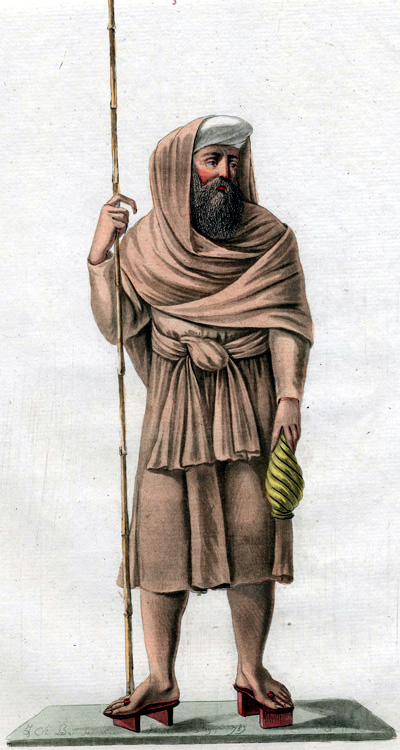 Jesuit missionary, painting from 1779 After much training and experience in theology, Jesuits went across the globe in search of converts to Christianity. Despite their dedication, they had little success in Asia, except in the Philippines. For instance, early missions in Japan resulted in the government granting the Jesuits the feudal fiefdom of Nagasaki in 1580. This was removed in 1587 due to fears over their growing influence.[30] Jesuits did, however, have much success in Latin America. Their ascendancy in societies in the Americas accelerated during the seventeenth century, wherein Jesuits created new missions in Peru, Colombia, and Bolivia; as early as 1603, there were 345 Jesuit priests in Mexico alone.[31] 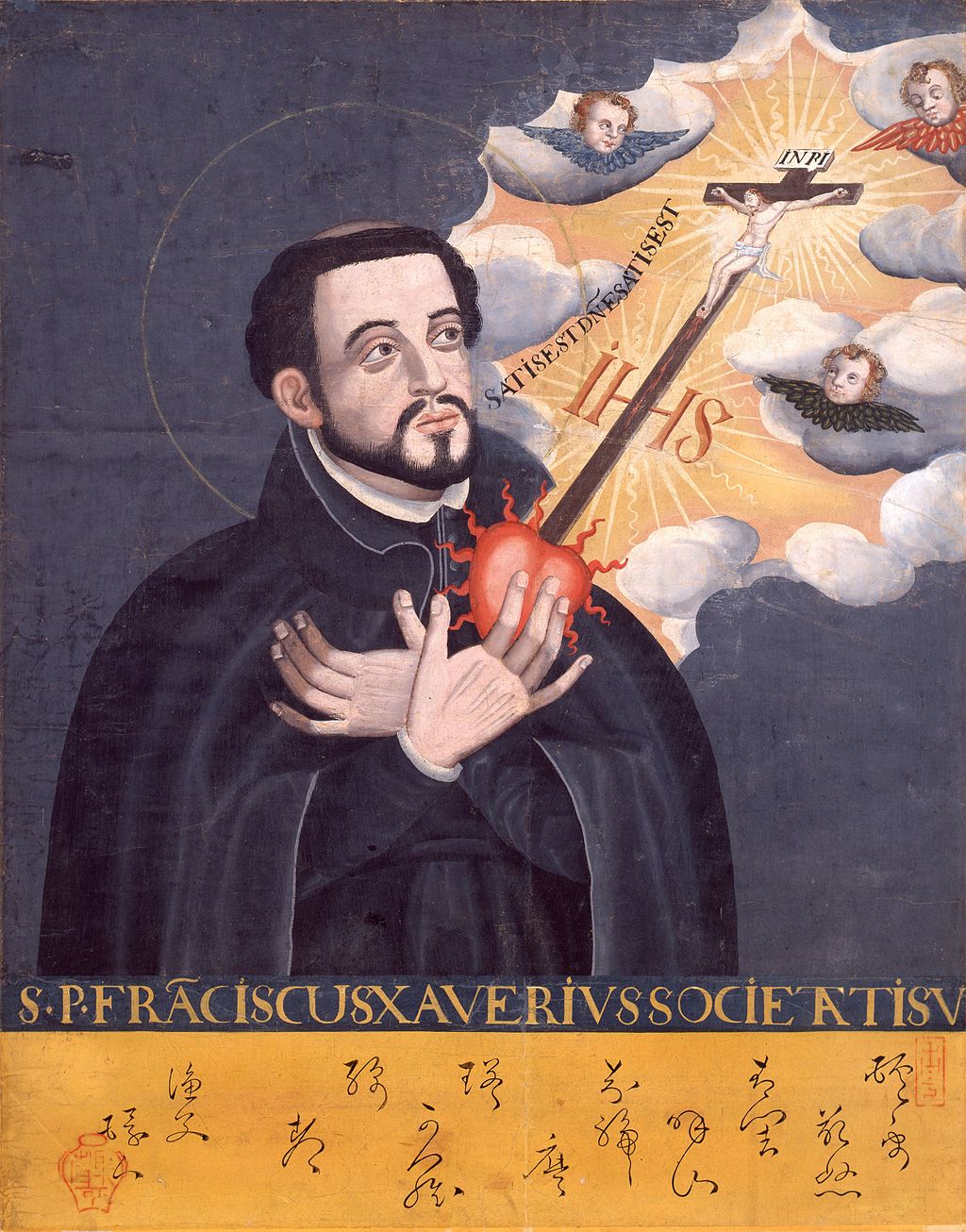 Francis Xavier Francis Xavier, one of the original companions of Loyola, arrived in Goa (Portuguese India) in 1541 to carry out evangelical service in the Indies. In a 1545 letter to John III of Portugal, he requested an Inquisition to be installed in Goa to combat heresies like crypto-Judaism and crypto-Islam. Under Portuguese royal patronage, Jesuits thrived in Goa and until 1759 successfully expanded their activities to education and healthcare. In 1594 they founded the first Roman-style academic institution in the East, St. Paul Jesuit College in Macau, China. Founded by Alessandro Valignano, it had a great influence on the learning of Eastern languages (Chinese and Japanese) and culture by missionary Jesuits, becoming home to the first western sinologists such as Matteo Ricci. Jesuit efforts in Goa were interrupted by the expulsion of the Jesuits from Portuguese territories in 1759 by the powerful Marquis of Pombal, Secretary of State in Portugal.[32] The Portuguese Jesuit António de Andrade founded a mission in Western Tibet in 1624 (see also "Catholic Church in Tibet"). Two Jesuit missionaries, Johann Grueber and Albert Dorville, reached Lhasa, in Tibet, in 1661. The Italian Jesuit Ippolito Desideri established a new Jesuit mission in Lhasa and Central Tibet (1716–21) and gained an exceptional mastery of Tibetan language and culture, writing a long and very detailed account of the country and its religion as well as treatises in Tibetan that attempted to refute key Buddhist ideas and establish the truth of Catholic Christianity. |
受注の拡大 この節は、読者にとってわかりづらいかもしれません。 節の内容を明確にするため、ご協力をお願いします。 節について議論するページがあるかもしれません。 (December 2019) (Learn how and when to remove this message)  イエズス会の宣教師、1779年からの絵画 神学に関する多くの訓練と経験を経て、イエズス会はキリスト教への改宗者を求めて世界中に広がった。彼らの献身にもかかわらず、アジアではフィリピンを除 いてほとんど成功しなかった。例えば、初期の日本での宣教は、1580年にイエズス会に長崎の封建的な封土を与えるという結果となった。これは、彼らの影 響力が拡大していることへの懸念から、1587年に撤回された。[30] しかし、イエズス会はラテンアメリカで大きな成功を収めた。 17世紀には、アメリカ大陸における彼らの影響力は加速し、イエズス会はペルー、コロンビア、ボリビアに新たな布教地を開拓した。1603年には早くも、 メキシコだけで345人のイエズス会の司祭がいた。[31]  フランシスコ・ザビエル フランシスコ・ザビエルは、ロヨラの最初の仲間であり、1541年にインドで布教活動を行うためにゴア(ポルトガル領インド)に到着した。1545年にポ ルトガルのジョアン3世に宛てた手紙の中で、彼はゴアに異端審問所を設置し、隠れユダヤ教や隠れイスラム教などの異端と戦うことを要請した。ポルトガル王 室の庇護の下、イエズス会はゴアで繁栄し、1759年までには教育や医療の分野にもその活動を拡大することに成功した。1594年には、東洋初のローマ式 学術機関であるマカオの聖ポール・イエズス会大学を設立した。アレッサンドロ・ヴァリニャーノによって設立されたこの大学は、宣教師であるイエズス会士に よる東洋の言語(中国語と日本語)や文化の学習に大きな影響を与え、マテオ・リッチのような最初の西洋の中国学者を輩出した。 1759年にポルトガル領からイエズス会が追放されたことで、イエズス会のゴアでの活動は中断された。ポルトガル国務長官で強力な権力者であったポンバル 侯爵による追放であった。 ポルトガル人イエズス会士のアントニオ・デ・アンドラーデは、1624年に西チベットに布教所を設立した(「チベットにおけるカトリック教会」も参照)。 イエズス会の宣教師であるヨハン・グルーバーとアルバート・ドルヴィルは、1661年にチベットのラサに到着した。イタリア人イエズス会員イッポリト・デ シデリはラサとチベット中央部に新たなイエズス会伝道所を設立し(1716年~1721年)、チベット語とチベット文化に卓越した知識を得た。彼はチベッ ト語で、その国と宗教に関する非常に詳細な記録を書き、また、仏教の主要な考え方を否定し、カトリック・キリスト教の真実を確立しようとする論文も執筆し た。 |
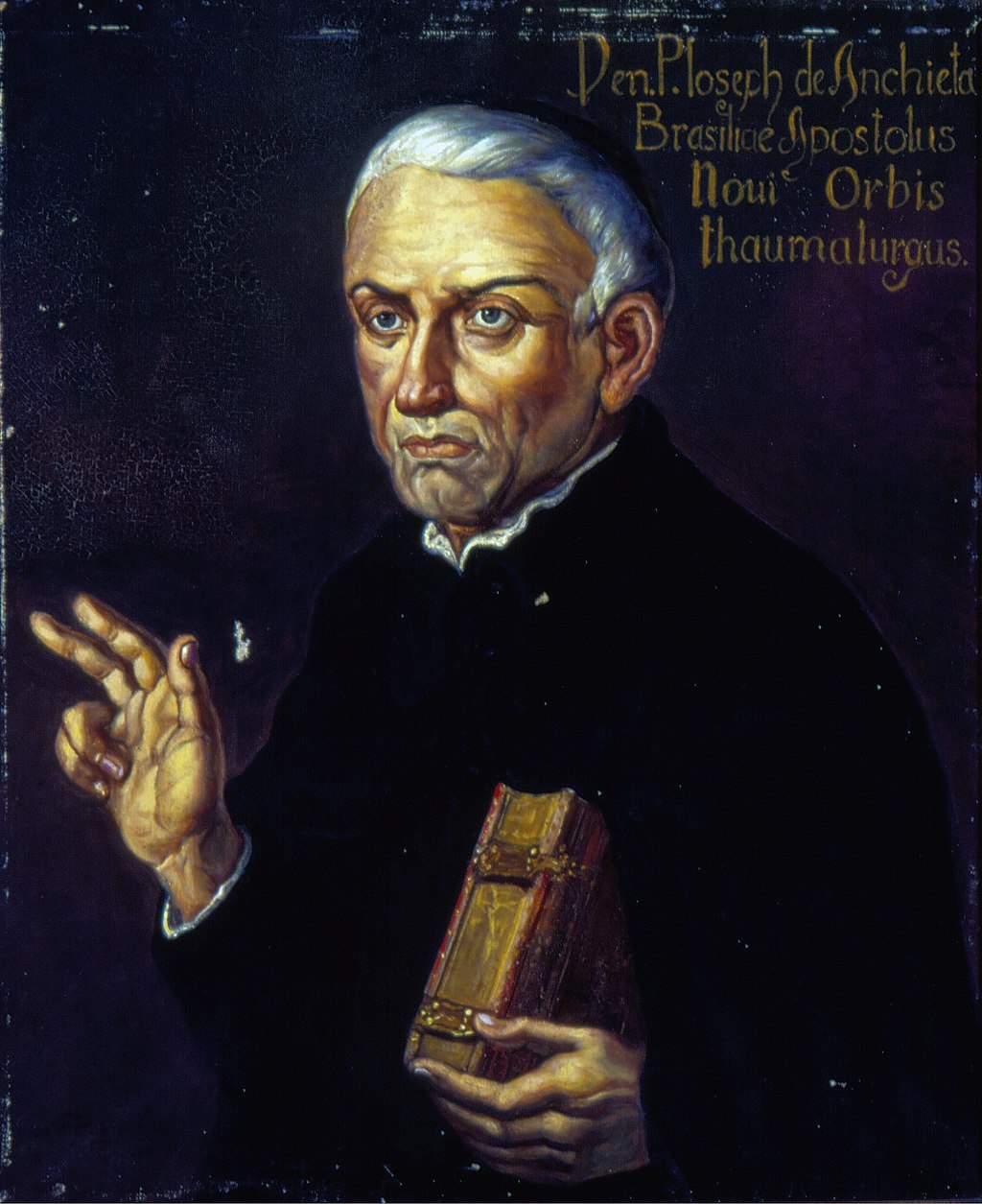 The Spanish missionary José de Anchieta was, together with Manuel da Nóbrega, the first Jesuit that Ignacio de Loyola sent to America. Jesuit missions in the Americas became controversial in Europe, especially in Spain and Portugal where they were seen as interfering with the proper colonial enterprises of the royal governments. The Jesuits were often the only force standing between the Indigenous and slavery. Together throughout South America but especially in present-day Brazil and Paraguay, they formed Indigenous Christian city-states, called "reductions". These were societies set up according to an idealized theocratic model. The efforts of Jesuits like Antonio Ruiz de Montoya to protect the natives from enslavement by Spanish and Portuguese colonizers would contribute to the call for the society's suppression. Jesuit priests such as Manuel da Nóbrega and José de Anchieta founded several towns in Brazil in the 16th century, including São Paulo and Rio de Janeiro, and were very influential in the pacification, religious conversion, and education of indigenous nations. They also built schools, organized people into villages, and created a writing system for the local languages of Brazil.[31] José de Anchieta and Manuel da Nóbrega were the first Jesuits that Ignacio de Loyola sent to the Americas.[33] 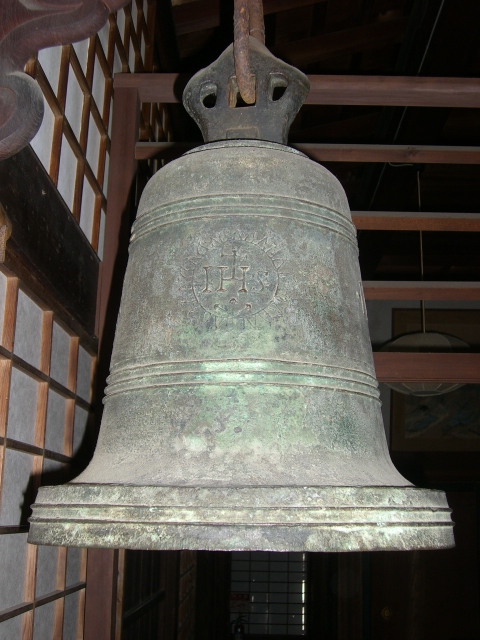 Bell made in Portugal for Nanbanji Church run by Jesuits in Japan, 1576–1587 Jesuit scholars working in foreign missions were very dedicated in studying the local languages and strove to produce Latinized grammars and dictionaries. This included: Japanese (see Nippo jisho, also known as Vocabvlario da Lingoa de Iapam, "Vocabulary of the Japanese Language", a Japanese–Portuguese dictionary written 1603); Vietnamese (Portuguese missionaries created the Vietnamese alphabet,[34][35] which was later formalized by Avignon missionary Alexandre de Rhodes with his 1651 trilingual dictionary); Tupi (the main language of Brazil); and the pioneering study of Sanskrit in the West by Jean François Pons in the 1740s. Jesuit missionaries were active among indigenous peoples in New France in North America, many of them compiling dictionaries or glossaries of the First Nations and Native American languages they had learned. For instance, before his death in 1708, Jacques Gravier, vicar general of the Illinois Mission in the Mississippi River valley, compiled a Miami–Illinois–French dictionary, considered the most extensive among works of the missionaries.[36] Extensive documentation was left in the form of The Jesuit Relations, published annually from 1632 until 1673. |
 スペイン人宣教師ホセ・デ・アンシエタは、マヌエル・ダ・ノブレガとともに、イグナチオ・デ・ロヨラがアメリカ大陸に派遣した最初のイエズス会士であった。 アメリカ大陸におけるイエズス会の布教活動はヨーロッパ、特にスペインとポルトガルで論争の的となった。 イエズス会は、先住民と奴隷制の間に立つ唯一の勢力となることが多かった。 彼らは南米全域で、特に現在のブラジルとパラグアイで協力し合い、先住民キリスト教徒の都市国家を形成した。 これらは「還俗」と呼ばれる理想的な神政モデルに従って設立された社会であった。スペインやポルトガルの植民者による先住民の奴隷化から守ろうとしたアン トニオ・ルイス・デ・モンタニャなどのイエズス会の宣教師たちの努力は、社会の弾圧を求める声に拍車をかけた。マヌエル・ダ・ノブレガやホセ・デ・アン シェッタなどのイエズス会の宣教師たちは、16世紀にブラジルにサンパウロやリオデジャネイロなどのいくつかの町を建設し、先住民の平和化、宗教改宗、教 育に多大な影響を与えた。彼らはまた学校を建設し、人々を村に組織化し、ブラジルの現地語の書き方を考案した。[31] ホセ・デ・アンシエタとマヌエル・ダ・ノブレガは、イグナチオ・デ・ロヨラがアメリカ大陸に派遣した最初のイエズス会士であった。[33]  1576年から1587年にかけて、イエズス会が日本で運営する南蛮寺のためにポルトガルで製造された鐘 海外宣教に従事するイエズス会の学者たちは、現地の言語の研究に非常に熱心に取り組み、ラテン語化された文法や辞書の作成に努めた。これには以下が含まれ る。日本語(『日葡辞書』(『Vocabvlario da Lingoa de Iapam』、『日本語の語彙』とも呼ばれる。1603年に書かれた日本語-ポルトガル語辞書)ベトナム語(ポルトガル人宣教師がベトナム文字を作成し [34][35]、その後アヴィニョン宣教師のアレクサンドル・ド・ロードが1651年に出版した3か国語辞書で正式なものとなった)トゥピ語(ブラジル の主要言語)および ジャン・フランソワ・ポンによる1740年代の西洋におけるサンスクリット語研究の先駆的な研究。 イエズス会の宣教師たちは、北米のヌーベルフランスにおける先住民の間で活動しており、その多くは、彼らが学んだファーストネーションやネイティブアメリ カンの言語の辞書や用語集を編纂していた。例えば、1708年に亡くなる前に、ミシシッピ川流域のイリノイ伝道所の代牧者であったジャック・グラヴィエ は、ミアミ族、イリノイ族、フランス語の辞書を編纂した。これは宣教師の著作の中でも最も広範なものとされている。[36] 膨大な量の文書は、『イエズス会関係』という形で残され、1632年から1673年まで毎年出版された。 |
| Britain Whereas Jesuits were active in Britain in the 16th century, due to the persecution of Catholics in the Elizabethan times, an English province was only established in 1623.[37] The first pressing issue for early Jesuits in what today is the United Kingdom was to establish places for training priests. After an English College was opened in Rome (1579), a Jesuit seminary was opened at Valladolid (1589), then one in Seville (1592), which culminated in a place of study in Louvain (1614). This was the earliest foundation of what would later be called Heythrop College. Campion Hall, founded in 1896, has been a presence within Oxford University since then. 16th and 17th-century Jesuit institutions intended to train priests were hotbeds for the persecution of Catholics in Britain, where men suspected of being Catholic priests were routinely imprisoned, tortured, and executed. Jesuits were among those killed, including the namesake of Campion Hall, as well as Brian Cansfield, Ralph Corbington, and many others. A number of them were canonized among the Forty Martyrs of England and Wales. Four Jesuit churches remain today in London alone, with three other places of worship remaining extant in England and two in Scotland.[38] |
イギリス 16世紀にはイギリスでイエズス会が活動していたが、エリザベス朝時代のカトリック迫害により、イギリス管区が設立されたのは1623年になってからだっ た。[37] 今日イギリスと呼ばれる地域における初期のイエズス会の喫緊の課題は、司祭を養成する場所を確立することであった。ローマに英語カレッジが開校(1579 年)した後、イエズス会の神学校がバリャドリッド(1589年)、セビリア(1592年)に開校し、最終的にルーヴァン(1614年)に研究施設が設立さ れた。これが後にヘイトロップ・カレッジと呼ばれることになる最も初期の設立であった。1896年に設立されたカンピオン・ホールは、それ以来オックス フォード大学内に存在している。 16世紀から17世紀にかけてのイエズス会の教育機関は、司祭の養成を目的としていたが、英国ではカトリック信者に対する迫害の温床となり、カトリックの 司祭であると疑われた男性は日常的に投獄され、拷問を受け、処刑された。イエズス会の信者の中には、キャンピオン・ホールの名前の由来となった人物をはじ め、ブライアン・カンズフィールド、ラルフ・コービントン、その他多数が殺害された。そのうちの何人かは、イングランドとウェールズの40人の殉教者の列 聖者となった。 現在でもロンドンには4つのイエズス会の教会が残っており、イングランドには3つ、スコットランドには2つの礼拝所が現存している。[38] |
| China Main article: Jesuit missions in China 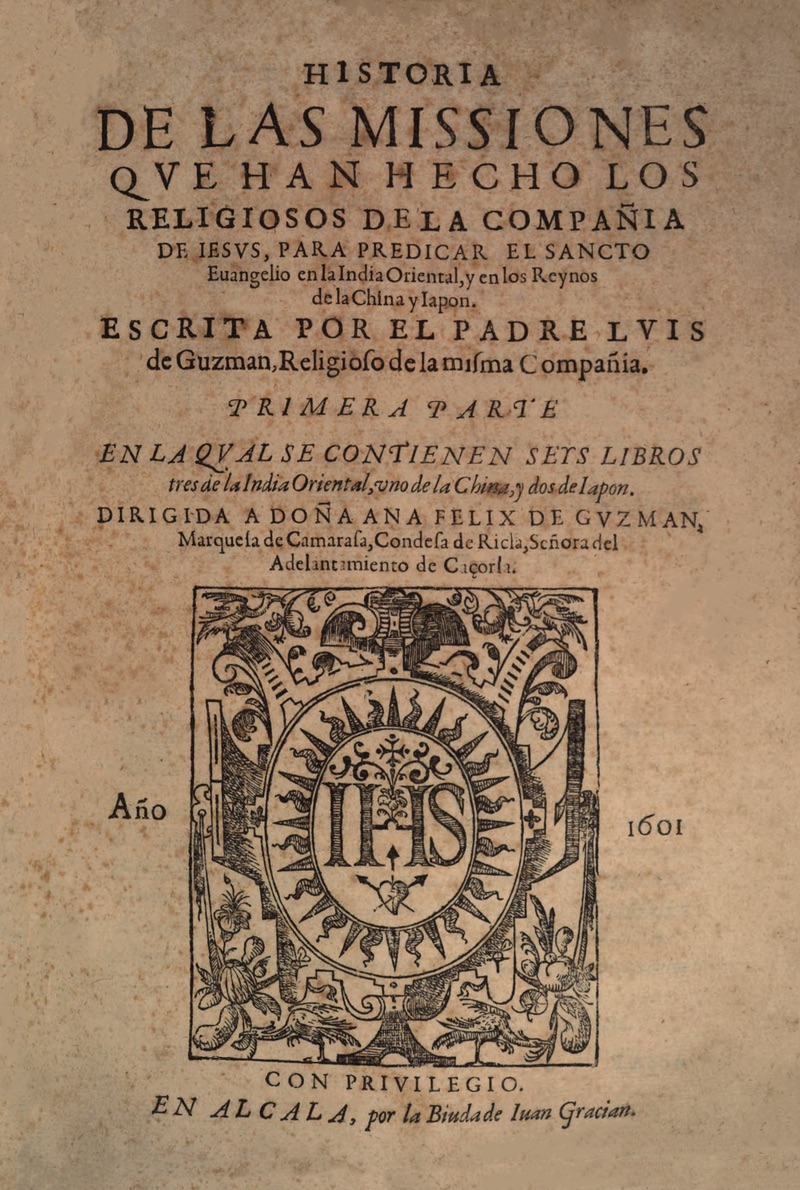 Historia de las misiones jesuitas en India, China y Japón (Luis Guzmán, 1601) 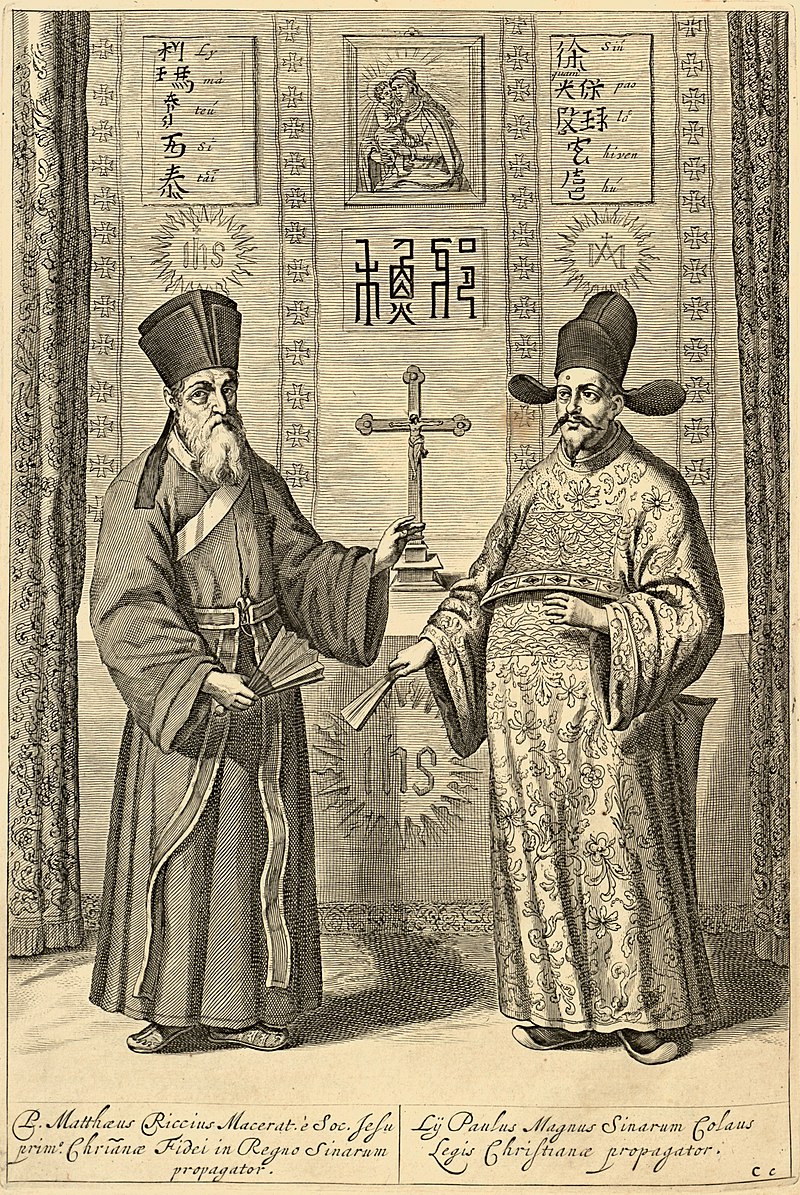 Matteo Ricci (left) and Xu Guangqi in the 1607 Chinese publication of Euclid's Elements 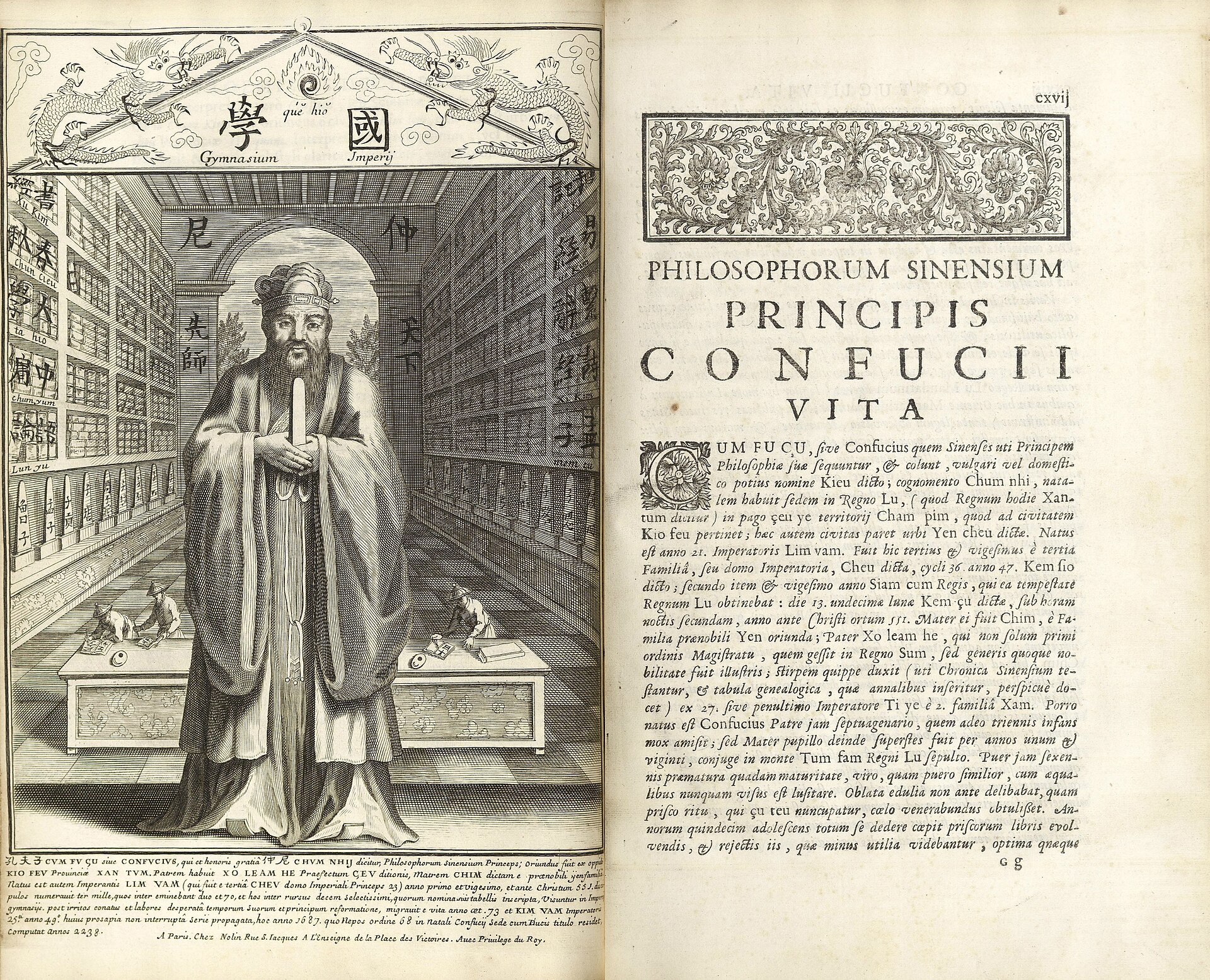 Confucius, Philosopher of the Chinese, or, Chinese Knowledge Explained in Latin, published by Philippe Couplet, Prospero Intorcetta, Christian Herdtrich, and François de Rougemont at Paris in 1687 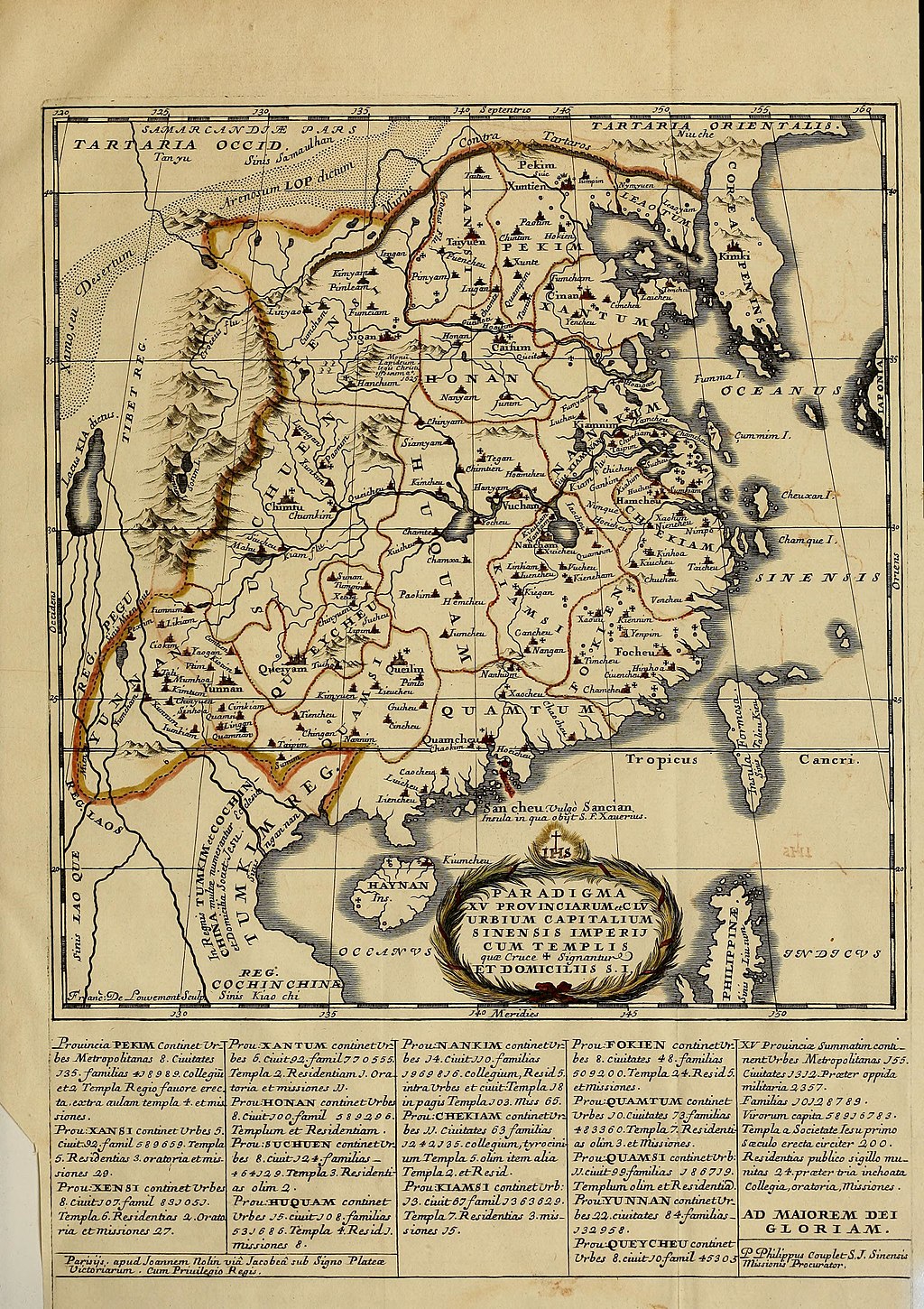 A map of the 200-odd Jesuit churches and missions established across China c. 1687 The Jesuits first entered China through the Portuguese settlement on Macau, where they settled on Green Island and founded St. Paul's College. The Jesuit China missions of the 16th and 17th centuries introduced Western science and astronomy,[39] then undergoing its own revolution, to China. The scientific revolution brought by the Jesuits coincided with a time when scientific innovation had declined in China: [The Jesuits] made efforts to translate western mathematical and astronomical works into Chinese and aroused the interest of Chinese scholars in these sciences. They made very extensive astronomical observation and carried out the first modern cartographic work in China. They also learned to appreciate the scientific achievements of this ancient culture and made them known in Europe. Through their correspondence, European scientists first learned about the Chinese science and culture.[40] For over a century, Jesuits such as Michele Ruggieri, Matteo Ricci,[41] Diego de Pantoja, Philippe Couplet, Michal Boym, and François Noël refined translations and disseminated Chinese knowledge, culture, history, and philosophy to Europe. Their Latin works popularized the name "Confucius" and had considerable influence on the Deists and other Enlightenment thinkers, some of whom were intrigued by the Jesuits' attempts to reconcile Confucian morality with Catholicism.[42] Upon the arrival of the Franciscans and other monastic orders, Jesuit accommodation of Chinese culture and rituals led to the long-running Chinese Rites controversy. Despite the personal testimony of the Kangxi Emperor and many Jesuit converts that Chinese veneration of ancestors and Confucius was a nonreligious token of respect, Pope Clement XI's papal decree Cum Deus Optimus ruled that such behavior constituted impermissible forms of idolatry and superstition in 1704;[43] his legate Tournon and Bishop Charles Maigrot of Fujian, tasked with presenting this finding to the Kangxi Emperor, displayed such extreme ignorance that the emperor mandated the expulsion of Christian missionaries unable to abide by the terms of Ricci's Chinese catechism.[44][45][46][47] Tournon's summary and automatic excommunication for any violators of Clement's decree[48] – upheld by the 1715 bull Ex Illa Die – led to the swift collapse of all the missions in China;[45] the last Jesuits were finally expelled after 1721.[49] |
中国 詳細は:中国におけるイエズス会の伝道活動  インド、中国、日本におけるイエズス会宣教の歴史(ルイス・グスマン、1601年)  1607年に中国で出版された『ユークリッドの原論』のマテオ・リッチ(左)と徐光啓  1687年にパリでフィリップ・クープラン、プロスペロ・イントルチェッタ、クリスチャン・ヘルトリッヒ、フランソワ・ド・ルーモンによって出版された『中国哲学者、孔子、またはラテン語で説明された中国知識』  1687年頃に中国全土に設立されたイエズス会の教会および伝道所の地図 イエズス会は、マカオのポルトガル人居住地から中国に初めて進出し、そこで彼らは緑島に定住し、聖ポール大学を設立した。 16世紀から17世紀にかけてのイエズス会の中国布教活動は、当時革命のさなかにあった西洋の科学や天文学を中国にもたらした。イエズス会がもたらした科学革命は、中国で科学的な革新が衰退していた時期と重なっていた。 イエズス会は、西洋の数学や天文学の著作を中国語に翻訳する努力を惜しまず、中国の学者たちの関心をこれらの科学分野に引き起こした。彼らは非常に広範囲 にわたる天体観測を行い、中国で最初の近代的な地図作成作業を行った。また、彼らはこの古代文化の科学的成果を評価することを学び、それをヨーロッパに広 めた。彼らの交流を通じて、ヨーロッパの科学者たちは初めて中国の科学と文化について知ることとなった。 ミケーレ・ルジェーリ、マテオ・リッチ、ディエゴ・デ・パントーハ、フィリップ・クープリエ、ミハル・ボイム、フランソワ・ノエルといったイエズス会の宣 教師たちは、1世紀以上にわたって翻訳を推敲し、中国に関する知識、文化、歴史、哲学をヨーロッパに広めた。彼らのラテン語の著作は「孔子」の名を広め、 自然神論者や啓蒙思想家たちに大きな影響を与えた。その中には、イエズス会が儒教の道徳とカトリックを調和させようとした試みに興味を抱いた者もいた。 フランシスコ会やその他の修道会の到来により、イエズス会が中国文化や儀式に順応したことで、長期にわたる「中国礼儀」論争が引き起こされた。康熙帝や多 くのイエズス会の改宗者の証言によると、中国人による先祖崇拝や孔子崇拝は宗教とは関係のない敬意の表れであるとされたが、1704年、教皇クレメンス 11世の教皇令「Cum Deus Optimus」は、そのような行為は偶像崇拝や迷信の許されない形態であると裁定した。教皇使節のトゥルノンと福建省の司教シャルル・メグロは、この裁 定を康熙帝に伝える任務を負っていたが、彼らは極度の 無知を示したため、康熙帝はリッチの中国カテキズムの条件に従うことができないキリスト教宣教師の追放を命じた。[44][45][46][47] トゥルノンがまとめた、クレメンスの命令に違反した者に対する自動的な破門[48](1715年の雄牛Ex Illa Dieによって支持された)により、中国におけるすべての宣教は急速に崩壊した。[45] 最後のイエズス会士は、 1721年以降、最終的に追放された。[49] |
| Ireland See also: List of Jesuit schools in Ireland The first Jesuit school in Ireland was established at Limerick by the apostolic visitor of the Holy See, David Wolfe. Wolfe had been sent to Ireland by Pope Pius IV with the concurrence of the third Jesuit superior general, Diego Laynez.[50] He was charged with setting up grammar schools "as a remedy against the profound ignorance of the people".[51] Wolfe's mission in Ireland initially concentrated on setting the sclerotic Irish Church on a sound footing, introducing the Tridentine Reforms and finding suitable men to fill vacant sees. He established a house of religious women in Limerick known as the Menabochta ("poor women" ) and in 1565 preparations began for establishing a school at Limerick.[52] At his instigation, Richard Creagh, a priest of the Diocese of Limerick, was persuaded to accept the vacant Archdiocese of Armagh, and was consecrated at Rome in 1564. This early Limerick school, Crescent College, operated in difficult circumstances. In April 1566, William Good sent a detailed report to Rome of his activities via the Portuguese Jesuits. He informed the Jesuit superior general that he and Edmund Daniel had arrived at Limerick city two years beforehand and their situation there had been perilous. Both had arrived in the city in very bad health, but had recovered due to the kindness of the people. They established contact with Wolfe, but were only able to meet with him at night, as the English authorities were attempting to arrest the legate. Wolfe charged them initially with teaching to the boys of Limerick, with an emphasis on religious instruction, and Good translated the catechism from Latin into English for this purpose. They remained in the city for eight months, before moving to Kilmallock in December 1565 under the protection of the Earl of Desmond, where they lived in more comfort than the primitive conditions they experienced in the city. However they were unable to support themselves at Kilmallock and three months later they returned to the city in Easter 1566, and strangely set up their house in accommodation owned by the Lord Deputy of Ireland, which was conveyed to them by certain influential friends.[53] They recommenced teaching at Castle Lane, and imparting the sacraments, though their activities were restricted by the arrival of Royal Commissioners. Good reported that as he was an Englishman, English officials in the city cultivated him and he was invited to dine with them on a number of occasions, though he was warned to exercise prudence and avoid promoting the Petrine primacy and the priority of the Mass amongst the sacraments with his students and congregation, and that his sermons should emphasize obedience to secular princes if he wished to avoid arrest.[53] The number of scholars in their care was very small. An early example of a school play in Ireland is sent in one of Good's reports, which was performed on the Feast of St. John in 1566. The school was conducted in one large aula, but the students were divided into distinct classes. Good gives a highly detailed report of the curriculum taught and the top class studied the first and second parts of Johannes Despauterius's Commentarli grammatici, and read a few letters of Cicero or the dialogues of Frusius (André des Freux, SJ). The second class committed Donatus' texts in Latin to memory and read dialogues as well as works by Ēvaldus Gallus. Students in the third class learned Donatus by heart, though translated into English rather than through Latin. Young boys in the fourth class were taught to read. Progress was slow because there were too few teachers to conduct classes simultaneously.[53] In the spirit of Ignatius' Roman College founded 14 years before, no fee was requested from pupils, though as a result the two Jesuits lived in very poor conditions and were very overworked with teaching and administering the sacraments to the public. In late 1568 the Castle Lane School, in the presence of Daniel and Good, was attacked and looted by government agents sent by Sir Thomas Cusack during the pacification of Munster.[54] The political and religious climate had become more uncertain in the lead up to Pope Pius V's formal excommunication of Queen Elizabeth I, which resulted in a new wave of repression of Catholicism in England and Ireland. At the end of 1568 the Anglican Bishop of Meath, Hugh Brady, was sent to Limerick charged with a Royal Commission to seek out and expel the Jesuits. Daniel was immediately ordered to quit the city and went to Lisbon, where he resumed his studies with the Portuguese Jesuits.[54] Good moved on to Clonmel, before establishing himself at Youghal until 1577.[55] In 1571, after Wolfe had been captured and imprisoned at Dublin Castle, Daniel persuaded the Portuguese Province to agree a surety for the ransom of Wolfe, who was quickly banished on release. Daniel returned to Ireland the following year, but was immediately captured and incriminating documents were found on his person, which were taken as proof of his involvement with the rebellious cousin of the Earl of Desmond, James Fitzmaurice and a Spanish plot.[56] He was removed from Limerick, taken to Cork "just as if he were a thief or noted evildoer". After being court-martialled by the Lord President of Munster, Sir John Perrot, he was sentenced to be hanged, drawn, and quartered for treason and refused pardon in return for swearing the Act of Supremacy. His execution was carried out on 25 October 1572 and a report of it was sent by Fitzmaurice to the Jesuit Superior General in 1576, where he said that Daniel was "cruelly killed because of me".[57] With Daniel dead and Wolfe dismissed, the Irish Jesuit foundation suffered a severe setback. Good is recorded as resident at Rome by 1577 and in 1586 the seizure of Earl of Desmond's estates resulted in a new permanent Protestant plantation in Munster, making the continuation of the Limerick school impossible for a time. It was not until the early 1600s that the Jesuit mission could again re-establish itself in the city, though the Jesuits kept a low profile existence in lodgings here and there. For instance a mission led by Fr. Nicholas Leinagh re-established itself at Limerick in 1601,[58] though the Jesuit presence in the city numbered no more than 1 or 2 at a time in the years immediately following. In 1604, the Lord President of Munster, Sir Henry Brouncker - at Limerick, ordered all Jesuits from the city and Province, and offered £7 to anyone willing to betray a Jesuit priest to the authorities, and £5 for a seminarian.[59] Jesuit houses and schools throughout the province, in the years thereafter, were subject to periodic crackdown and the occasional destruction of schools, imprisonment of teachers and the levying of heavy money penalties on parents are recorded in publications of the time. In 1615-17 the Royal Visitation Books, written up by Thomas Jones, the Anglican Archbishop of Dublin, records the suppression of Jesuit schools at Waterford, Limerick and Galway.[60] Nevertheless, in spite of this occasional persecution, the Jesuits were able to exert a degree of discreet influence within the province and in Limerick. For instance in 1606, largely through their efforts, a Catholic named Christopher Holywood was elected Mayor of the city.[61] Four years earlier the resident Jesuit had raised a sum of "200 cruzados" for the purpose of founding a hospital in the city, though the project was disrupted by a severe outbreak of plague and repression by the Lord President[62] The principal activities of the order within the city at this time were devoted to preaching, administration of the sacraments and teaching. The school opened and closed intermittently in or around the area of Castle Lane, near Lahiffy's lane. During demolition work stones marked I.H.S., 1642 and 1609 were, in the 19th century, found inserted in a wall behind a tan yard near St Mary's Chapel which, according to Lenihan, were thought to mark the site of an early Jesuit school and oratory. This building, at other times, had also functioned as a dance house and candle factory.[63] For much of the 17th century, the Limerick Jesuit foundation established a more permanent and stable presence and the Jesuit Annals record a 'flourishing' school at Limerick in the 1640s.[64] During the Confederacy the Jesuits had been able to go about their business unhindered and were invited to preach publicly from the pulpit of St. Mary's Cathedral on 4 occasions. Cardinal Giovanni Rinuccini wrote to the Jesuit general in Rome praising the work of the Rector of the Limerick College, Fr. William O'Hurley, who was aided by Fr. Thomas Burke.[65] However just a few years later, during the Protectorate era, only 18 of the Jesuits resident in Ireland managed to avoid capture by the authorities. Lenihan records that the Limerick Crescent College in 1656 moved to a hut in the middle of a bog which was difficult for the authorities to find. This foundation was headed up by Fr. Nicholas Punch who was aided by Frs. Maurice Patrick, Piers Creagh and James Forde and the school attracted a large number of students from around the locality.[66] At the Restoration of Charles II, the school moved back to Castle Lane, and remained largely undisturbed for the next 40 years, until the surrender of the city to Williamite forces in 1692. In 1671, Dr. James Douley was appointed Vicar Apostolic of Limerick and during his visitation to the diocese reported to the Holy See that the Jesuits had a house and "taught schools with great fruit, instructing the youth in the articles of faith and good morals."[67] Douley also noted that this and other Catholic schools operating in the Diocese were also attended by local Protestants.[68] The Jesuit presence in Ireland, in the so-called Penal era after the Battle of the Boyne, ebbed and flowed. By 1700 they were only 6 or 7, recovering to 25 by 1750. Small Jesuit houses and schools existed at Athlone, Carrick-on-Suir, Cashel, Clonmel, Kilkenny, Waterford, New Ross, Wexford, and Drogheda, as well as Dublin and Galway. At Limerick there appears to have been a long hiatus following the defeat of the Jacobite forces and Begley states that Fr. Thomas O'Gorman was the first Jesuit to return to Limerick after the siege, arriving in 1728 and he took up residence in Jail Lane, near the Castle in the Englishtown. There he opened a school to "impart the rudiments of the classics to the better class youth of the city."[69] O'Gorman left in 1737 and was succeeded by Fr. John McGrath.[70] Next came Fr. James McMahon, who was a nephew of the Primate of Armagh, Hugh MacMahon. McMahon lived at Limerick for thirteen years until his death in 1751. In 1746 Fr Joseph Morony was sent from Bordeaux to join McMahon and the others.[71] Morony remained at the Jail Lane site teaching at what Begley states was a "high class school" until 1773 when he was ordered to close the school and oratory following the papal suppression of the Society of Jesus,[72] 208 years after its foundation by Wolfe. Morony then went to live in Dublin and worked as a secular priest. Despite the efforts of the Castle authorities and English government the Limerick school managed to survive the Protestant Reformation, the Cromwellian invasion and Williamite Wars, and subsequent Penal Laws. It was finally forced to close, not for religious or confessional reasons, but due to the political difficulties of the Jesuit Order elsewhere. Following the restoration of the Society of Jesus in 1814, the Jesuits gradually re-established a number of their schools throughout the country, starting with foundations at Kildare and Dublin. They returned to Limerick at the invitation of the Bishop of Limerick, John Ryan, in 1859 and also re-established a school at Galway in the same year. |
アイルランド 関連項目:アイルランドのイエズス会系学校一覧 アイルランド初のイエズス会系学校は、教皇庁使節のデイヴィッド・ウルフによってリムリックに設立された。ウルフは、第3代イエズス会総長ディエゴ・ライ ネス(Diego Laynez)の同意を得た上で、教皇ピウス4世によってアイルランドに派遣された。ウルフは、「国民の深刻な無知を改善する」ための文法学校の設立を命 じられた。 ウルフの当初の使命は、硬直化したアイルランド教会を健全な基盤に立て直すことに集中していた。トリエント改革を導入し、空席となっている地位にふさわし い人材を見つけることだった。彼はリムリックに「貧しい女性たち」という意味の「メナボクタ」という名の女子修道院を設立し、1565年にはリムリックに 学校を設立するための準備が始まった。 彼の勧めにより、リムリック教区の司祭リチャード・クレイグは空席となっていたアーマー大司教区の職を引き受けるよう説得され、1564年にローマで叙階された。 この初期のリムリック派、クレセント・カレッジは困難な状況下で運営されていた。1566年4月、ウィリアム・グッドはポルトガル人のイエズス会士を通じ て、ローマに自身の活動の詳細な報告を送った。彼はイエズス会の総長に、彼とエドマンド・ダニエルは2年前にリムリック市に到着したが、その時の状況は危 険なものであったと伝えた。2人とも非常に悪い保健状態で市に到着したが、市民の親切により回復した。 彼らはウルフと接触したが、英国当局が使節を逮捕しようとしていたため、彼と会うことができたのは夜だけだった。ウルフは彼らをリムリックの少年たちに宗 教教育を教えるために派遣した。グッドはその目的のために、ラテン語のカテキズムを英語に翻訳した。彼らは8か月間その都市に滞在し、1565年12月に デズモンド伯の保護のもとキルマロックに移った。そこでは、都市での原始的な環境よりも快適な生活を送ることができた。しかし、キルマーロックでは生活を 維持することができず、3か月後、1566年の復活祭にダブリンに戻った。そして、不思議なことに、アイルランド総督の所有する宿泊施設に家を構えた。こ れは、有力な友人たちによって彼らに提供されたものだった。 彼らはキャッスル・レーンで再び教え始め、秘跡を授けた。しかし、王立委員会の到着により、彼らの活動は制限されていた。グッドは、自分が英国人であるた め、市の英国人役人たちから厚遇を受け、何度も彼らとの食事に招待されたが、生徒や信者たちに対して、秘跡の中でも特に、ペトロの首位権やミサの優先性を 宣伝しないよう慎重を期すよう警告された。また、逮捕を避けたいのであれば、説教では世俗の君主への服従を強調すべきだと忠告された。 彼らが面倒を見ていた生徒の数は非常に少なかった。アイルランドにおける学校劇の初期の例は、グッドの報告書の一つに記載されており、1566年の聖ヨハ ネ祭で上演された。学校は1つの大きな講堂で行われていたが、生徒たちは明確にクラス分けされていた。グッドは、教えられていたカリキュラムについて非常 に詳細な報告をしているが、トップクラスの生徒たちはヨハネス・デスパウテリウスの『文法解説』の第1部と第2部を学び、キケロのいくつかの手紙やフルー シウスの対話を読んでいた(アンドレ・デ・フルー、イエズス会)。2番目のクラスでは、ラテン語で書かれたドナトゥス著のテキストを暗記し、対話やエヴァ ルドゥス・ガルス著の作品を読んだ。3番目のクラスの生徒は、ドナトゥスをラテン語ではなく英語に訳して暗記した。4番目のクラスの少年たちは、読み方を 教わった。同時に授業を行うには教師が少なすぎたため、進歩は遅かった。 14年前に設立されたイグナティウス・ローマ・カレッジの精神に則り、生徒からは授業料を徴収しなかったが、その結果、2人のイエズス会士は劣悪な環境で 生活し、教育や聖礼典の管理に非常に忙殺されることとなった。1568年の終わり頃、ダニエルとグッドの目の前で、ミュンスター平定中にサー・トーマス・ クーザックが派遣した政府のエージェントたちによってキャッスル・レーン・スクールが襲撃され、略奪された。[54] 教皇ピウス5世がエリザベス1世を正式に破門する前、政治と宗教の情勢はさらに不確かなものになっていた。その結果、イングランドとアイルランドではカト リックに対する弾圧の新たな波が起こった。1568年の終わりに、メースの英国国教会司教ヒュー・ブレイディがリムリックに送られ、イエズス会の追放を命 じられた。ダニエルはすぐにリムリックを去るよう命じられ、リスボンに向かい、そこでポルトガル人イエズス会士たちと共に学問を再開した。[54] グッドはクロンメルに移り、1577年までヨールに落ち着くまで過ごした。[55] 1571年、ウルフが捕らえられダブリン城に投獄された後、ダニエルはポルトガル管区にウルフの身代金を支払う保証人となるよう説得した。ウルフはすぐに 追放された。ダニエルは翌年アイルランドに戻ったが、すぐに捕らえられ、彼の人格に不利な書類が見つかった。それは、デズモンド伯爵の反逆的な従兄弟であ るジェームズ・フィッツモーリスとスペインの陰謀に関与している証拠とみなされた。彼はリムリックからコークに移送されたが、それは「まるで泥棒か悪名高 い犯罪者のように」であった。その後、ジョン・ペロット卿(Sir John Perrot)率いる軍法会議にかけられ、反逆罪により絞首刑、引きずり回し刑、四つ裂きの刑に処せられる判決が下され、大権法を誓うことによる恩赦も拒 否された。彼の処刑は1572年10月25日に行われ、フィッツモーリスが1576年にイエズス会の総長に送った報告書には、ダニエルが「私のせいで残酷 に殺された」と書かれていた。 ダニエルが死に、ウルフが解任されたことで、アイルランドのイエズス会は深刻な後退を余儀なくされた。1577年までにグッドはローマに居住していたと記 録されており、1586年にはデズモンド伯爵の領地の接収により、プロテスタントの入植地が新たに永久的に設立されたことで、リムリック派の継続は一時不 可能となった。イエズス会の宣教活動が再びこの都市で再開されるのは、1600年代初頭になってからであった。イエズス会は目立たない存在ではあったが、 あちこちに宿舎を構えていた。例えば、ニコラス・レナフ神父が率いる宣教団は1601年にリムリックに再進出したが[58]、その直後の数年間は、一度に 1人か2人しかイエズス会の宣教師がリムリックに滞在することはなかった。 1604年、マンスター総督サー・ヘンリー・ブラウンカー卿はリムリックで、市と州のイエズス会士全員に退去を命じ、イエズス会の司祭を当局に密告する者 には7ポンド、神学生には5ポンドを支払うと申し出た。[59] それ以降、州内のイエズス会の家屋や学校は定期的に弾圧の対象となり、学校の破壊や教師の投獄、また 当時の出版物には、1615年から1617年にかけて、ダブリンの英国国教会大司教トーマス・ジョーンズが記した「王立訪問記録」に、ウォーターフォー ド、リムリック、ゴールウェイのイエズス会学校の閉鎖が記録されている。[60] しかし、このような時折の迫害にもかかわらず、イエズス会はリムリック州およびリムリック市において、ある程度の影響力を及ぼすことができた。例えば 1606年には、主に彼らの努力により、クリストファー・ホーリーウッドという名のカトリック教徒が市長に選出された。[61] 4年前には、市内に病院を設立するために、居住していたイエズス会士が「200クルザード」という資金を集めたが、そのプロジェクトはペストの深刻な流行 と総督による弾圧により中断された。[62] この時期、市内の修道会の主な活動は説教、秘跡の執行、教育に専念していた。学校は、ラフィの小道近くのキャッスル・レーン周辺で断続的に開校と閉校を繰 り返した。解体作業中に、1642年と1609年と刻まれた石が、19世紀に聖マリア礼拝堂近くのタンニング工場の裏の壁から発見された。レニハンによる と、これらの石は初期のイエズス会の学校と礼拝堂の跡地を示すものと考えられていた。この建物は、それ以外の時期にはダンスホールやろうそく工場としても 機能していた。 17世紀の大半の間、リムリックのイエズス会はより恒久的で安定した存在となり、イエズス会の年代記には1640年代のリムリックの学校が「繁栄」してい たと記録されている。[64] 連合王国時代、イエズス会は妨害を受けることなく事業を展開することができ、4度にわたって聖マリア大聖堂の説教壇で公に説教を行うよう招待された。枢機 卿ジョヴァンニ・リヌッチーニは、リムリック・カレッジの学長ウィリアム・オヘア神父の働きを称賛する手紙をローマのイエズス会総長に送った。オヘア神父 はトーマス・バーク神父の支援を受けていた。[65] しかし、わずか数年後の護民官統治時代には、アイルランド在住のイエズス会士のうち当局に捕らわれずに済んだのはわずか18人であった。レニハンは、 1656年にリムリック・クレセント・カレッジが当局に見つけにくい沼地の真ん中の小屋に移転したことを記録している。この学校はニコラス・パンチ神父が 主宰し、モーリス・パトリック、ピアス・クレイグ、ジェームズ・フォーデの神父たちが支援した。この学校には地元一帯から多数の生徒が集まった。 チャールズ2世の王政復古により、学校はキャッスル・レーンに戻り、1692年にウィリアム派軍が市を占領するまで、その後40年間はほぼ平穏に過ごし た。1671年、ジェームズ・ドゥーリー博士がリムリックの使徒使徒として任命され、教区を訪問した際、イエズス会が家屋を所有し、「大きな成果を伴う学 校教育を行い、信仰の条項と良き道徳について若者たちに指導している」ことを教皇庁に報告した。[67] ドゥーリーはまた、教区で運営されているこの学校やその他のカトリック系学校には、地元のプロテスタント信者も通っていることも指摘した。[68] アイルランドにおけるイエズス会の存在は、ボインの戦い以降のいわゆる「重罪時代」には増減を繰り返していた。1700年には6つか7つにまで減少した が、1750年には25にまで回復した。アスローン、キャリック・オン・スィアー、キャッシェル、クロンメル、キルケニー、ウォーターフォード、ニュー・ ロス、ウェックスフォード、ドロヘダ、そしてダブリンやゴールウェイにも、小規模なイエズス会の家屋や学校が存在していた。リムリックでは、ジャコバイト 軍の敗北後、長い空白期間があったようである。ベグリーによると、トーマス・オゴーマン神父が、包囲戦後のリムリックに最初に帰ってきたイエズス会士であ り、1728年に到着し、イングリッシュタウンの城の近くにあるジェイル・レーンに居住した。そこで彼は「市の良家の子女に古典の初歩を教える」学校を開 いた。[69] オゴーマン神父は1737年に去り、ジョン・マクグラス神父が後任となった。[70] 次にやってきたのはジェームズ・マクマホン神父で、彼はアルマー大司教ヒュー・マクマホンの甥であった。マクマホンは1751年に亡くなるまで13年間リ ムリックに住んだ。1746年には、ジョセフ・モロニー神父がボルドーからマクマホン神父らのもとに派遣された。[71] モロニーは、ベグリーが「高級学校」と表現した学校で教鞭をとり、ウルフが設立してから208年後、イエズス会がローマ教皇庁によって解散させられたこと を受け、1773年に学校と礼拝堂の閉鎖を命じられるまで、ジェイルレーンに留まった。その後モロニーはダブリンに移り、世俗の司祭として働いた。 リムリックの学校は、キャッスル当局と英国政府の努力にもかかわらず、プロテスタント改革、クロムウェルによる侵略、ウィリアム朝戦争、その後の刑罰法を生き延びた。最終的に閉鎖に追い込まれたのは、宗教や信仰上の理由ではなく、イエズス会の政治的な困難が原因であった。 1814年にイエズス会が復活すると、キルデアとダブリンに設立した学校を皮切りに、徐々に国内各地に学校を再開設していった。1859年にはリムリック司教ジョン・ライアンの招きに応じてリムリックに戻り、同年にゴールウェイにも学校を再開設した。 |
| Canada See also: Jesuit missions in North America 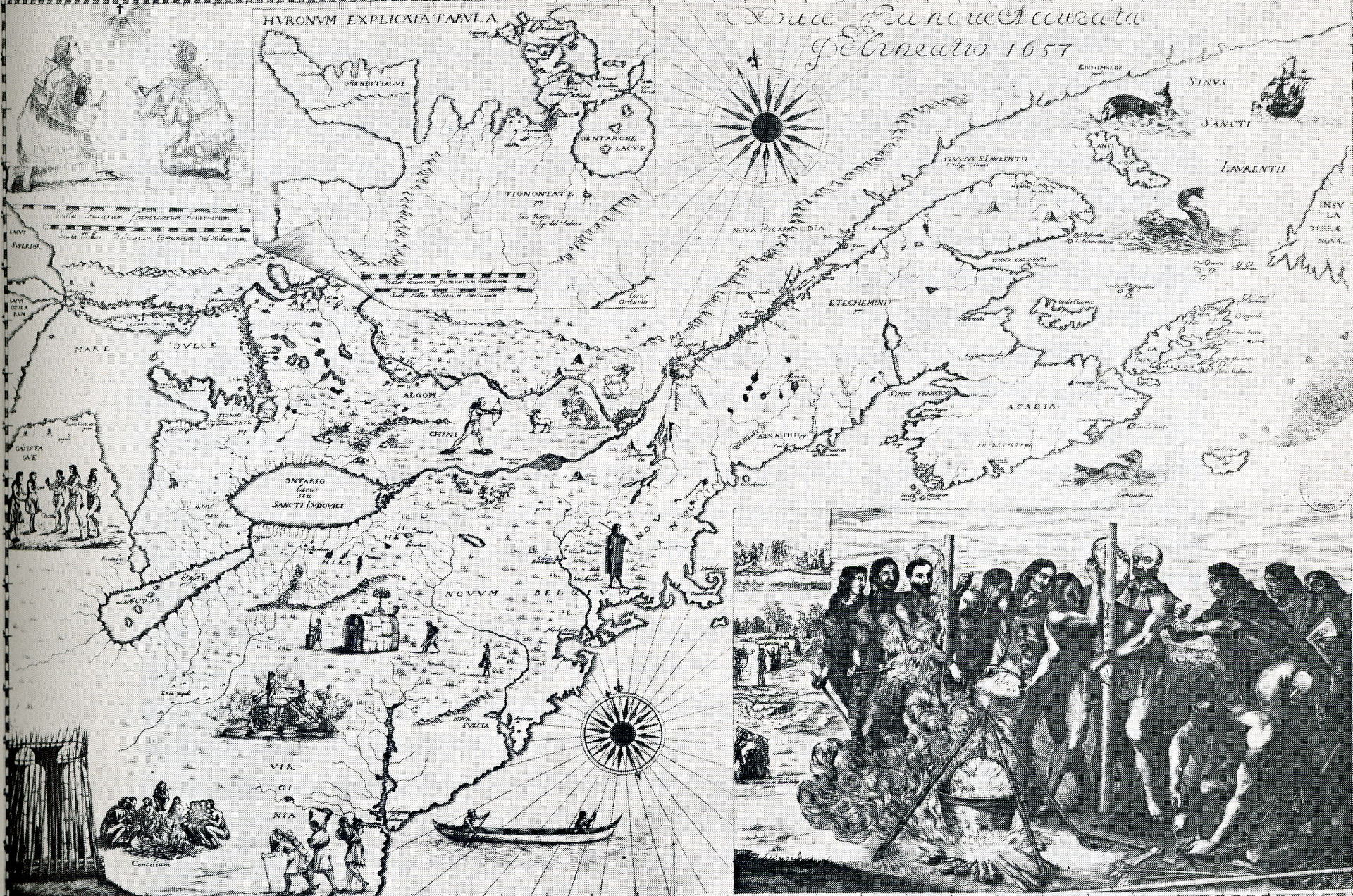 Bressani map of 1657 depicting the martyrdom of Jean de Brébeuf During the French colonisation of New France in the 17th century, Jesuits played an active role in North America. Samuel de Champlain established the foundations of the French colony at Québec in 1608. The native tribes that inhabited modern day Ontario, Québec, and the areas around Lake Simcoe and Georgian Bay were the Montagnais, the Algonquins, and the Huron.[73] Champlain believed that these had souls to be saved, so in 1614 he obtained the Recollects, a reform branch of the Franciscans in France, to convert the native inhabitants.[74] In 1624 the French Recollects realized the magnitude of their task[75] and sent a delegate to France to invite the Society of Jesus to help with this mission. The invitation was accepted, and Jesuits Jean de Brébeuf, Énemond Massé, and Charles Lalemant arrived in Quebec in 1625.[76] Lalemant is considered to have been the first author of one of the Jesuit Relations of New France, which chronicled their evangelization during the 17th century. The Jesuits became involved in the Huron mission in 1626 and lived among the Huron peoples. Brébeuf learned the native language and created the first Huron language dictionary. Outside conflict forced the Jesuits to leave New France in 1629 when Quebec was surrendered to the English. In 1632, Quebec was returned to the French under the Treaty of Saint Germain-en-Laye and the Jesuits returned to the Huron territory.[77] After a series of epidemics of European-introduced diseases beginning in 1634, some Huron began to mistrust the Jesuits and accused them of being sorcerers casting spells from their books.[78] In 1639, Jesuit Jerome Lalemant decided that the missionaries among the Hurons needed a local residence and established Sainte-Marie near present-day Midland, Ontario, which was meant to be a replica of European society.[79] It became the Jesuit headquarters and an important part of Canadian history. Throughout most of the 1640s the Jesuits had modest success, establishing five chapels in Huronia and baptising more than one thousand Huron out of a population which may have exceeded 20,000 before the epidemics of the 1630s.[80] However, the Iroquois of New York, rivals of the Hurons, grew jealous of the Hurons' wealth and control of the fur trade system and attacked Huron villages in 1648. They killed missionaries and burned villages, and the Hurons scattered. Both de Brébeuf and Gabriel Lalemant were tortured and killed in the Iroquois raids; for this, they have been canonized as martyrs in the Catholic Church.[81] The Jesuit Paul Ragueneau burned down Sainte-Marie instead of allowing the Iroquois the satisfaction of destroying it. By late June 1649, the French and some Christian Hurons built Sainte-Marie II on Christian Island (Isle de Saint-Joseph). However, facing starvation, lack of supplies, and constant threats of Iroquois attack, the small Sainte-Marie II was abandoned in June 1650; the remaining Christian Hurons and Jesuits departed for Quebec and Ottawa.[81] As a result of the Iroquois raids and outbreak of disease, many missionaries, traders, and soldiers died.[82] Today, the Huron tribe, also known as the Wyandot, have a First Nations reserve in Quebec, Canada, and three major settlements in the United States.[83] After the collapse of the Huron nation, the Jesuits undertook the task of converting the Iroquois, something they had attempted in 1642 with little success. In 1653 the Iroquois nation had a fallout with the Dutch. They then signed a peace treaty with the French and a mission was established. The Iroquois soon turned on the French again. In 1658, the Jesuits were having little success and were under constant threat of being tortured or killed,[82] but continued their effort until 1687 when they abandoned their permanent posts in the Iroquois homeland.[84] By 1700, Jesuits turned to maintaining Quebec, Montreal, and Ottawa without establishing new posts.[85] During the Seven Years' War, Quebec was captured by the British in 1759 and New France came under British control. The British barred the immigration of more Jesuits to New France, and by 1763, only 21 Jesuits were stationed in New France. By 1773 only 11 Jesuits remained. During the same year the British crown declared that the Society of Jesus in New France was dissolved.[86] The dissolution of the order left in place substantial estates and investments, amounting to an income of approximately £5,000 a year, and the Council for the Affairs of the Province of Quebec, later succeeded by the Legislative Assembly of Quebec, assumed the task of allocating the funds to suitable recipients, chiefly schools.[87] The Jesuit mission in Quebec was re-established in 1842. There were a number of Jesuit colleges founded in the decades following; one of these colleges evolved into present-day Laval University.[88] |
カナダ 関連項目:北米におけるイエズス会の宣教活動  1657年のブレッサーニの地図には、ジャン・ド・ブレブーフの殉教が描かれている 17世紀にフランスがヌーベルフランスを植民地化していた時代、イエズス会は北米で積極的な役割を果たした。サミュエル・ド・シャンプランは1608年に ケベックのフランス植民地の基礎を築いた。現代のオンタリオ州、ケベック州、およびシムコー湖とジョージアン湾周辺の地域に居住していた先住民族は、モン タニー族、アルゴンキン族、ヒューロン族であった。[73] シャンプランは、これらの人々には救われるべき魂があると信じていたため、1614年に先住民の改宗を目的として、フランスのフランシスコ会の改革派であ るレコレクト会を獲得した。[74] 1624年、フランスのレコレクト会は 彼らの任務の重大さに気づき[75]、この任務を手助けしてもらうためにイエズス会にフランスから代表を送った。この招待は受け入れられ、イエズス会の ジャン・ド・ブレブーフ、エノモン・マッセ、シャルル・ラレマンの3名が1625年にケベックに到着した。[76] ラレマンは、17世紀における彼らの布教活動を記録した『ヌーベルフランス・イエズス会年報』の著者であると考えられている。 イエズス会は1626年にヒューロン族の布教活動に関わり、ヒューロン族の間に住み始めた。ブレブーフは先住民の言葉を学び、ヒューロン族の最初の言語辞 書を作成した。1629年、ケベックがイギリスに降伏したことにより、外部の紛争が原因でイエズス会はヌーベルフランスを去らざるを得なくなった。 1632年、サン・ジェルマン・アン・レー条約によりケベックはフランスに返還され、イエズス会はヒューロン族の領地に戻った。[77] 1634年から始まったヨーロッパから持ち込まれた病気の流行の連続の後、一部のヒューロン族はイエズス会を疑うようになり、彼らが魔術師であり、書物か ら呪文を唱えていると非難した。[78] 1639年、イエズス会のジェローム・ラレマントは、ヒューロン族の宣教師たちに現地の住居が必要だと判断し、ヨーロッパ社会の模倣となるよう、現在のオ ンタリオ州ミッドランド近郊にサント=マリーを設立した。1640年代の大半を通じて、イエズス会はささやかな成功を収め、ヒューロニアに5つの礼拝堂を 設立し、1630年代の疫病流行以前には2万人を超えていたであろう人口のうち、1000人以上のヒューロン族を洗礼した。[80] しかし、ニューヨークのイロコイ族は、ヒューロン族の富と毛皮貿易の支配に嫉妬し、1648年にヒューロン族の村を襲撃した 。宣教師を殺害し、村々を焼き払い、ヒューロン族は散り散りになった。ド・ブレブフとガブリエル・ラレマンの両名は、イロコイ族の襲撃で拷問を受け、殺害 された。このため、2人はカトリック教会で殉教者として列聖されている。 イエズス会のポール・ラゲノーは、イロコイ族に満足感を与えるためにではなく、サント=マリーを焼き払った。1649年6月下旬、フランス人と一部のキリ スト教徒のヒューロン族は、クリスチャン島(セント・ジョセフ島)にサント=マリーIIを建設した。しかし、飢餓、物資不足、そして絶え間ないイロコイ族 の攻撃の脅威に直面し、小さなサント・マリーIIは1650年6月に放棄され、残ったクリスチャン・ヒューロン族とイエズス会の宣教師たちはケベックとオ タワへと去っていった。[81] イロコイ族の襲撃と伝染病の流行により、多くの宣教師、商人、兵士が命を落とした。[82] 今日、ヒューロン族はワイアンドット族とも呼ばれ、カナダのケベック州に先住民保留地を 、カナダ、および米国に3つの主要な入植地がある。 ヒューロン族が崩壊した後、イエズス会は1642年にほとんど成功を収めることなく試みたイロコイ族の改宗を任務とした。1653年、イロコイ族はオラン ダと対立した。その後、フランスと和平条約を締結し、宣教所が設立された。イロコイ族はすぐにフランスに背を向けた。1658年には、イエズス会はほとん ど成功を収めることができず、拷問や殺害の脅威に常にさらされていたが、[82] 1687年まで活動を継続し、その年にイロコイ族の故郷における恒久的な拠点を放棄した。[84] 1700年までに、イエズス会は新たな拠点を開設することなく、ケベック、モントリオール、オタワの維持に専念するようになった。[85] 七年戦争中、1759年にケベックはイギリス軍に占領され、ヌーベルフランスはイギリスの支配下に入った。イギリスはヌーベルフランスへのイエズス会の移 住を禁止し、1763年にはヌーベルフランスに駐在するイエズス会士は21人となった。1773年にはイエズス会士は11人しか残っていなかった。同年、 英国王は、ヌーベルフランスにおけるイエズス会は解散したと宣言した。[86] 解散後も、相当な不動産や投資が残され、年間およそ5,000ポンドの収入があった。ケベック地方管区評議会(後にケベック立法議会が後を継いだ)は、主に学校への資金配分を適任者に割り当てるという任務を引き受けた。 ケベックのイエズス会伝道所は1842年に再建された。その後数十年の間に、イエズス会系の大学がいくつか設立され、そのうちの1校が現在のラヴァル大学へと発展した。[88] |
| United States Main article: Jesuits in the United States In the United States, the order is best known for its missions to the Native Americans in the early 17th century, its network of colleges and universities, and (in Europe before 1773) its politically conservative role in the Catholic Counter Reformation. The Society of Jesus, in the United States, is organized into geographic provinces, each of which being headed by a provincial superior. Today, there are four Jesuit provinces operating in the United States: the USA East, USA Central and Southern, USA Midwest, and USA West Provinces. At their height, there were ten provinces. Though there had been mergers in the past, a major reorganization of the provinces began in early 21st century, with the aim of consolidating into four provinces by 2020.[89] |
アメリカ合衆国 詳細は「アメリカ合衆国のイエズス会」を参照 アメリカ合衆国では、17世紀初頭のネイティブアメリカンへの布教活動、大学ネットワーク、および(1773年以前のヨーロッパにおける)カトリックの対抗宗教改革における政治的に保守的な役割で最もよく知られている。 アメリカ合衆国のイエズス会は、地理的な管区に組織化されており、それぞれが管区長によって統括されている。現在、米国では4つのイエズス会管区が活動し ている。すなわち、米国東部、米国中部および南部、米国中西部、米国西部の各管区である。最盛期には10の管区があった。過去にも合併はあったが、 2020年までに4つの管区に統合することを目的として、21世紀初頭に管区の大規模な再編成が開始された。[89] |
| Ecuador The Church of the Society of Jesus (Spanish: La Iglesia de la Compañía de Jesús), known colloquially as la Compañía, is a Jesuit church in Quito, Ecuador. It is among the best-known churches in Quito because of its large central nave, which is profusely decorated with gold leaf, gilded plaster and wood carvings. Inspired by two Roman Jesuit churches – the Chiesa del Gesù (1580) and the Chiesa di Sant'Ignazio di Loyola (1650) – la Compañía is one of the most significant works of Spanish Baroque architecture in South America and Quito's most ornate church. Over the 160 years of its construction, the architects of la Compañía incorporated elements of four architectural styles, although the Baroque is the most prominent. Mudéjar (Moorish) influence is seen in the geometrical figures on the pillars; the Churrigueresque characterizes much of the ornate decoration, especially in the interior walls; finally the Neoclassical style adorns the Chapel of Saint Mariana de Jesús (in early years a winery). |
エクアドル イエズス会教会(スペイン語:ラ・イグレシア・デ・ラ・コンピア・デ・ヘスス)は、俗にラ・コンピアと呼ばれ、エクアドルのキトにあるイエズス会の教会で ある。 中央の身廊が広く、金箔や金メッキの漆喰、木彫りの装飾がふんだんに施されているため、キトで最も有名な教会のひとつである。ローマのイエズス会教会であ るキエーザ・デル・ジェズ(1580年)とキエーザ・ディ・サンティグナツィオ・ディ・ロヨラ(1650年)に着想を得たラ・コンパニアは、南米における スペイン・バロック建築の最も重要な作品のひとつであり、キトで最も装飾的な教会である。 160年以上にわたる建設期間中、ラ・コンパニアの建築家たちは4つの建築様式の要素を取り入れたが、最も顕著なのはバロック様式である。ムデハル様式 (ムーア様式)の影響は柱の幾何学的な図形に見られ、シュリーゲル様式は特に内壁の装飾の多くに特徴的である。最後に、ネオクラシック様式はサンタ・マリ アナ・デ・ヘスス礼拝堂(初期はワイン醸造所)を飾っている。 |
Mexico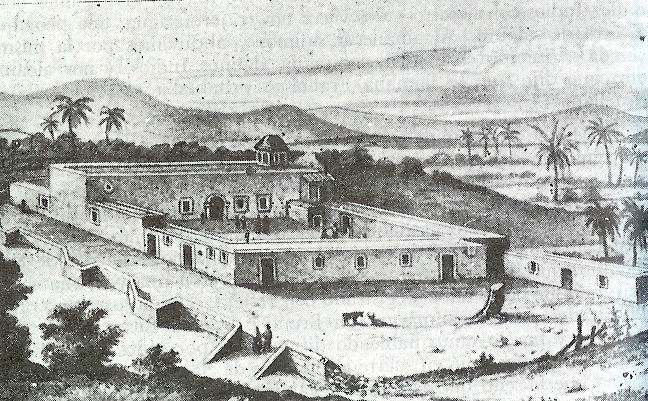 Misión de Nuestra Señora de Loreto Conchó in the 18th century, the first permanent Jesuit mission in Baja California, established by Juan María de Salvatierra in 1697 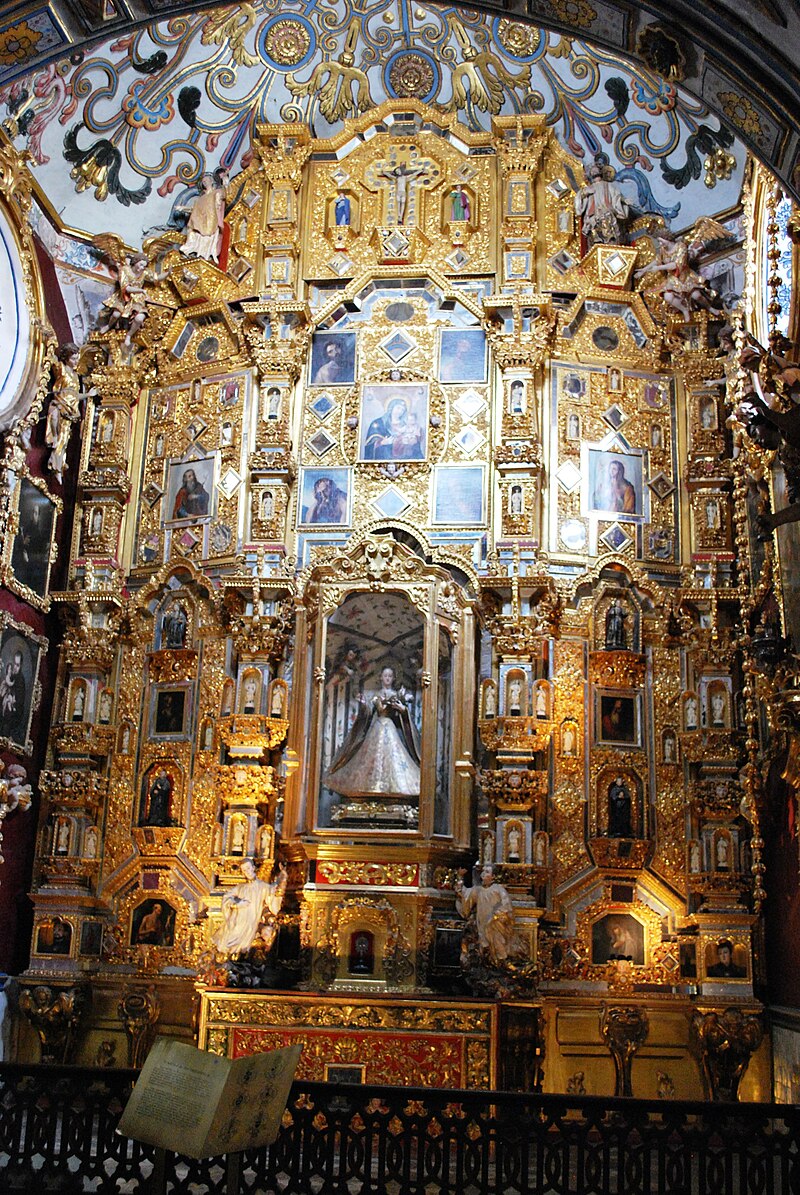 Main altar of the Jesuit colegio in Tepozotlan, now the Museo Nacional del Virreinato 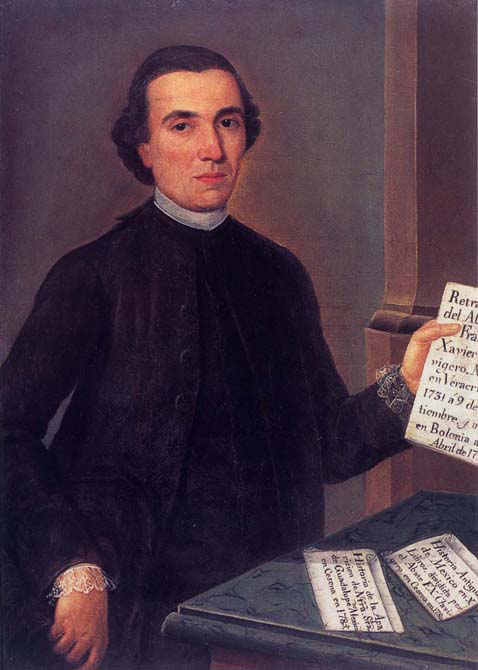 Mexican-born Jesuit Francisco Clavijero (1731–1787) wrote an important history of Mexico. The Jesuits in New Spain distinguished themselves in several ways. They had high standards for acceptance to the order and many years of training. They attracted the patronage of elite families whose sons they educated in rigorous newly founded Jesuit colegios ("colleges"), including Colegio de San Pedro y San Pablo, Colegio de San Ildefonso, and the Colegio de San Francisco Javier, Tepozotlan. Those same elite families hoped that a son with a vocation to the priesthood would be accepted as a Jesuit. Jesuits were also zealous in evangelization of the indigenous, particularly on the northern frontiers. To support their colegios and members of the Society of Jesus, the Jesuits acquired landed estates that were run with the best-practices for generating income in that era. A number of these haciendas were donated by wealthy elites. The donation of a hacienda to the Jesuits was the spark igniting a conflict between 17th-century Bishop Don Juan de Palafox of Puebla and the Jesuit colegio in that city. Since the Jesuits resisted paying the tithe on their estates, this donation effectively took revenue out of the church hierarchy's pockets by removing it from the tithe rolls.[90] Many of Jesuit haciendas were huge, with Palafox asserting that just two colleges owned 300,000 head of sheep, whose wool was transformed locally in Puebla to cloth; six sugar plantations worth a million pesos and generating an income of 100,000 pesos.[90] The immense Jesuit hacienda of Santa Lucía produced pulque, the alcoholic drink made from fermented agave sap whose main consumers were the lower classes and Indigenous peoples in Spanish cities. Although most haciendas had a free work force of permanent or seasonal labourers, the Jesuit haciendas in Mexico had a significant number of enslaved people of African descent.[91] The Jesuits operated their properties as an integrated unit with the larger Jesuit order; thus revenues from haciendas funded their colegios. Jesuits did significantly expand missions to the Indigenous in the northern frontier area and a number were martyred, but the crown supported those missions.[90] Mendicant orders that had real estate were less economically integrated, so that some individual houses were wealthy while others struggled economically. The Franciscans, who were founded as an order embracing poverty, did not accumulate real estate, unlike the Augustinians and Dominicans in Mexico. The Jesuits engaged in conflict with the episcopal hierarchy over the question of payment of tithes, the ten percent tax on agriculture levied on landed estates for support of the church hierarchy from bishops and cathedral chapters to parish priests. Since the Jesuits were the largest religious order holding real estate, surpassing the Dominicans and Augustinians who had accumulated significant property, this was no small matter.[90] They argued that they were exempt, due to special pontifical privileges.[92] Bishop De Palafox took on the Jesuits over this matter and was so soundly defeated that he was recalled to Spain, where he became the bishop of the minor Diocese of Osma. As elsewhere in the Spanish empire, the Jesuits were expelled from Mexico in 1767. Their haciendas were sold off and their colegios and missions in Baja California were taken over by other orders.[93] Exiled Mexican-born Jesuit Francisco Javier Clavijero wrote an important history of Mexico while in Italy, a basis for creole patriotism. Andrés Cavo also wrote an important text on Mexican history that Carlos María de Bustamante published in the early 19th century.[94] An earlier Jesuit who wrote about the history of Mexico was Diego Luis de Motezuma (1619–99), a descendant of the Aztec monarchs of Tenochtitlan. Motezuma's Corona mexicana, o Historia de los nueve Motezumas was completed in 1696. He "aimed to show that Mexican emperors were a legitimate dynasty in the 17th-century in the European sense".[95][96] The Jesuits were allowed to return to Mexico in 1840 when General Antonio López de Santa Anna was once more president of Mexico. Their re-introduction to Mexico was "to assist in the education of the poorer classes and much of their property was restored to them".[97] |
メキシコ 18世紀のロレト・コンチョーの聖母ミッションは、1697年にフアン・マリア・デ・サルバティエラが設立した、バハ・カリフォルニア初のイエズス会の常設ミッションである  テポソトランのイエズス会コレヒオの主祭壇。現在は国立副王領博物館となっている  メキシコ生まれのイエズス会員フランシスコ・クラヴィヘロ(1731年~1787年)は、メキシコの歴史に関する重要な著作を残した。 ヌエバ・エスパーニャのイエズス会員は、いくつかの点で際立っていた。入会には高い基準が設けられ、長年の厳しい訓練が課された。彼らは、厳格なイエズス 会が新しく設立したコレヒオ(「大学」)で息子たちを教育するエリート家庭の支援を集めた。その中には、コレヒオ・デ・サン・ペドロ・イ・サン・パブロ、 コレヒオ・デ・サン・イルデフォンソ、コレヒオ・デ・サン・フランシスコ・ハビエル、テポソトランなどが含まれる。同じエリート家庭は、聖職者になること を天職とする息子たちがイエズス会に受け入れられることを望んでいた。イエズス会は、特に北部の国境地域における先住民への布教にも熱心に取り組んだ。 イエズス会の学校と会員を支援するために、イエズス会は当時としては最高の収益を生み出す方法で運営されていた広大な土地を手に入れた。これらの土地の多 くは富裕なエリート層から寄贈されたものだった。イエズス会へのハシエンダの寄付は、17世紀のプエブラのドン・ファン・デ・パラフォックス司教とイエズ ス会のコレヒオの間の対立の火種となった。イエズス会は所有地に対する什分の一税の支払いを拒否したため、この寄付は事実上、什分の一税の対象から外すこ とで教会の収入源を断つこととなった。 イエズス会のハシエンダの多くは巨大で、パラフォックスは、わずか2つのカレッジが30万頭の羊を所有しており、その羊毛はプエブラで布に加工されていた と主張している。また、6つの砂糖プランテーションは100万ペソの価値があり、10万ペソの収入を生み出していた。[90] 広大なイエズス会のハシエンダであるサンタ・ルシアは、リュウゼツランの樹液を発酵させて作るアルコール飲料であるプルケを生産していた。プルケの主な消 費者はスペインの都市の下層階級や先住民であった 。ほとんどの農園では、常勤または季節労働者の無料労働力を確保していたが、メキシコのイエズス会の農園では、アフリカ系の人々を奴隷として多数抱えてい た。 イエズス会は、その所有地をイエズス会全体と統合された単位として運営していたため、ハシエンダからの収益がコレヒオの資金となっていた。イエズス会は北 部の辺境地域における先住民への布教を大幅に拡大し、多くの殉教者を出したが、王権はこれらの布教を支援した。托鉢修道会で不動産を所有していたものは経 済的に統合されていなかったため、裕福な個人宅もあれば、経済的に苦しいところもあった。清貧を旨とする修道会として創設されたフランシスコ会は、メキシ コのアウグスティノ会やドミニコ会とは異なり、不動産を蓄積することはなかった。 イエズス会は、教会のヒエラルキーを支えるために、土地所有者に課せられた農業税である什分の一税の支払いについて、司教階層と対立した。イエズス会は、 ドミニコ会やアウグスティノ会といった多くの財産を所有する修道会を凌ぎ、最大の不動産所有者であったため、これは些細な問題ではなかった。[90] 彼らは、教皇の特別な特権により免除されるべきだと主張した。[92] デ・パラフォックス司教は、この問題でイエズス会と対立し、完膚なきまでに敗北したためスペインに召還され、オスマ小教区の司教となった。 スペイン帝国の他の地域と同様に、イエズス会は1767年にメキシコから追放された。彼らの大農園は売却され、バハ・カリフォルニアのコレヒオと伝道所は 他の修道会に引き継がれた。[93] メキシコ生まれで追放されたイエズス会のフランシスコ・ハビエル・クラビヘロは、イタリアに滞在中にメキシコの重要な歴史を書き、それがクレオール人の愛 国心の基礎となった。アンドレス・カボもまた、19世紀初頭にカルロス・マリア・デ・ブスタマンテが出版したメキシコの歴史に関する重要な文献を著した。 [94] メキシコの歴史について著述した初期のイエズス会員には、アステカのテノチティトラン王家の末裔であるディエゴ・ルイス・デ・モテスマ(1619年- 1699年)がいる。モテズマの著書『メキシコの王冠、またはモテズマ9世の歴史』は1696年に完成した。彼は「メキシコ皇帝が17世紀のヨーロッパ的 な意味での正統な王朝であったことを示すことを目的としていた」[95][96]。 イエズス会は、1840年にアントニオ・ロペス・デ・サンタ・アナ将軍が再びメキシコの大統領に就任した際に、メキシコへの再入国が許可された。彼らのメキシコへの再導入は、「貧困層の教育を支援するためであり、彼らの財産の多くは彼らに返還された」[97]。 |
| Northern Spanish America This section needs additional citations for verification. Please help improve this article by adding citations to reliable sources in this section. Unsourced material may be challenged and removed. (August 2020) (Learn how and when to remove this message) 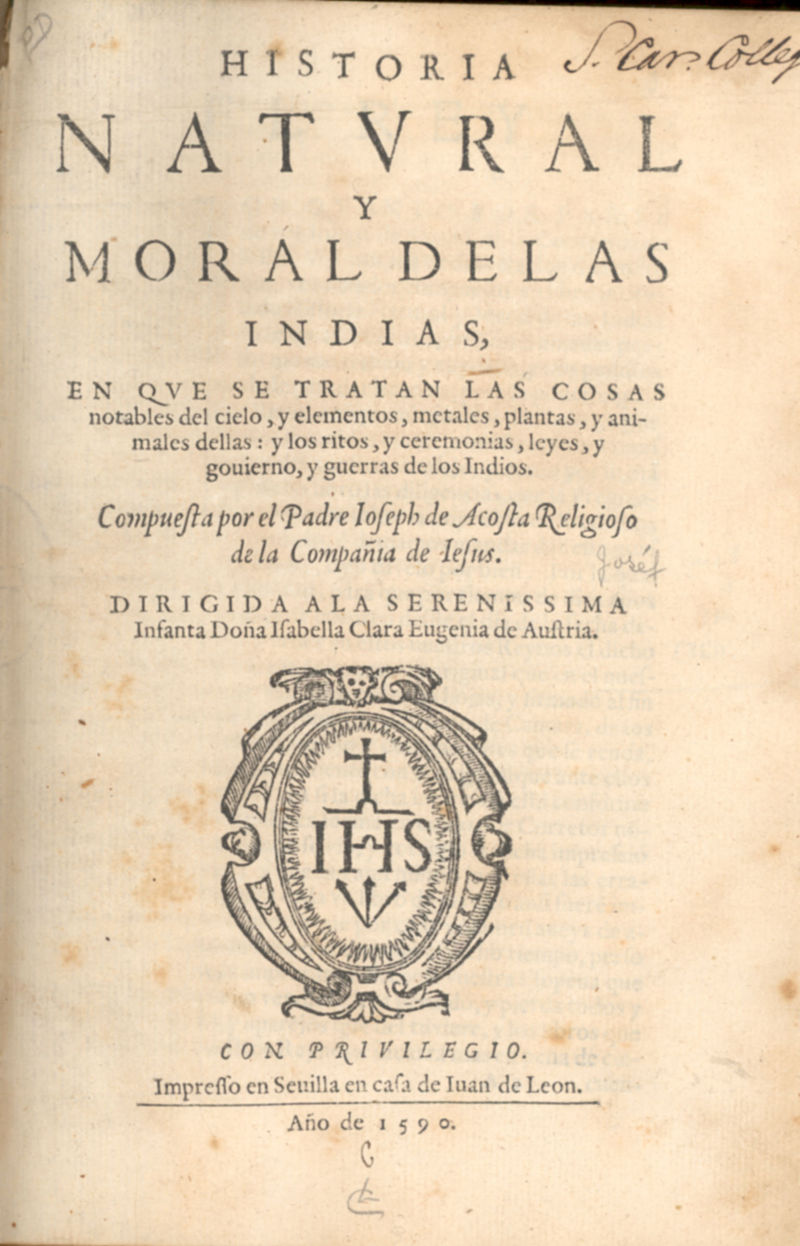 Acosta's Historia natural y moral de las Indias (1590) text on the Americas The Jesuits arrived in the Viceroyalty of Peru by 1571; it was a key area of the Spanish Empire, with not only dense indigenous populations but also huge deposits of silver at Potosí. A major figure in the first wave of Jesuits was José de Acosta (1540–1600), whose book Historia natural y moral de las Indias (1590) introduced Europeans to Spain's American empire via fluid prose and keen observation and explanation, based on 15 years in Peru and some time in New Spain (Mexico). Viceroy of Peru Don Francisco de Toledo urged the Jesuits to evangelize the Indigenous peoples of Peru, wanting to put them in charge of parishes, but Acosta adhered to the Jesuit position that they were not subject to the jurisdiction of bishops and to catechize in Indigenous parishes would bring them into conflict with the bishops. For that reason, the Jesuits in Peru focused on education of elite men rather than the indigenous populations.[98] 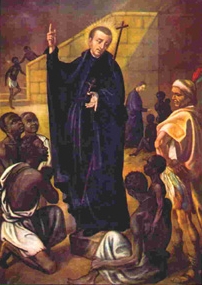 Peter Claver ministering to African slaves at Cartagena To minister to newly arrived African slaves, Alonso de Sandoval (1576–1651) worked at the port of Cartagena de Indias. Sandoval wrote about this ministry in De instauranda Aethiopum salute (1627),[99] describing how he and his assistant Peter Claver, later canonized, met slave transport ships in the harbour, went below decks where 300–600 slaves were chained, and gave physical aid with water, while introducing the Africans to Christianity. In his treatise, he did not condemn slavery or the ill-treatment of slaves, but sought to instruct fellow Jesuits to this ministry and describe how he catechized the slaves.[100] Rafael Ferrer was the first Jesuit of Quito to explore and found missions in the upper Amazon regions of South America from 1602 to 1610, which belonged to the Audiencia (high court) of Quito that was a part of the Viceroyalty of Peru until it was transferred to the newly created Viceroyalty of New Granada in 1717. In 1602, Ferrer began to explore the Aguarico, Napo, and Marañon rivers (Sucumbios region, in what is today Ecuador and Peru), and between 1604 and 1605 set up missions among the Cofane natives. He was martyred by an apostate native in 1610. In 1639, the Audiencia of Quito organized an expedition to renew its exploration of the Amazon river and the Quito Jesuit (Jesuita Quiteño) Cristóbal de Acuña was a part of this expedition. The expedition disembarked from the Napo river 16 February 1639 and arrived in what is today Pará, Brazil, on the banks of the Amazon river on 12 December 1639. In 1641, Acuña published in Madrid a memoir of his expedition to the Amazon river entitled Nuevo Descubrimiento del gran rio de las Amazonas, which for academics became a fundamental reference on the Amazon region. In 1637, the Jesuits Gaspar Cugia and Lucas de la Cueva from Quito began establishing the Mainas missions in territories on the banks of the Marañón River, around the Pongo de Manseriche region, close to the Spanish settlement of Borja. Between 1637 and 1652 there were 14 missions established along the Marañón River and its southern tributaries, the Huallaga and the Ucayali rivers. Jesuit de la Cueva and Raimundo de Santacruz opened up two new routes of communication with Quito, through the Pastaza and Napo rivers. 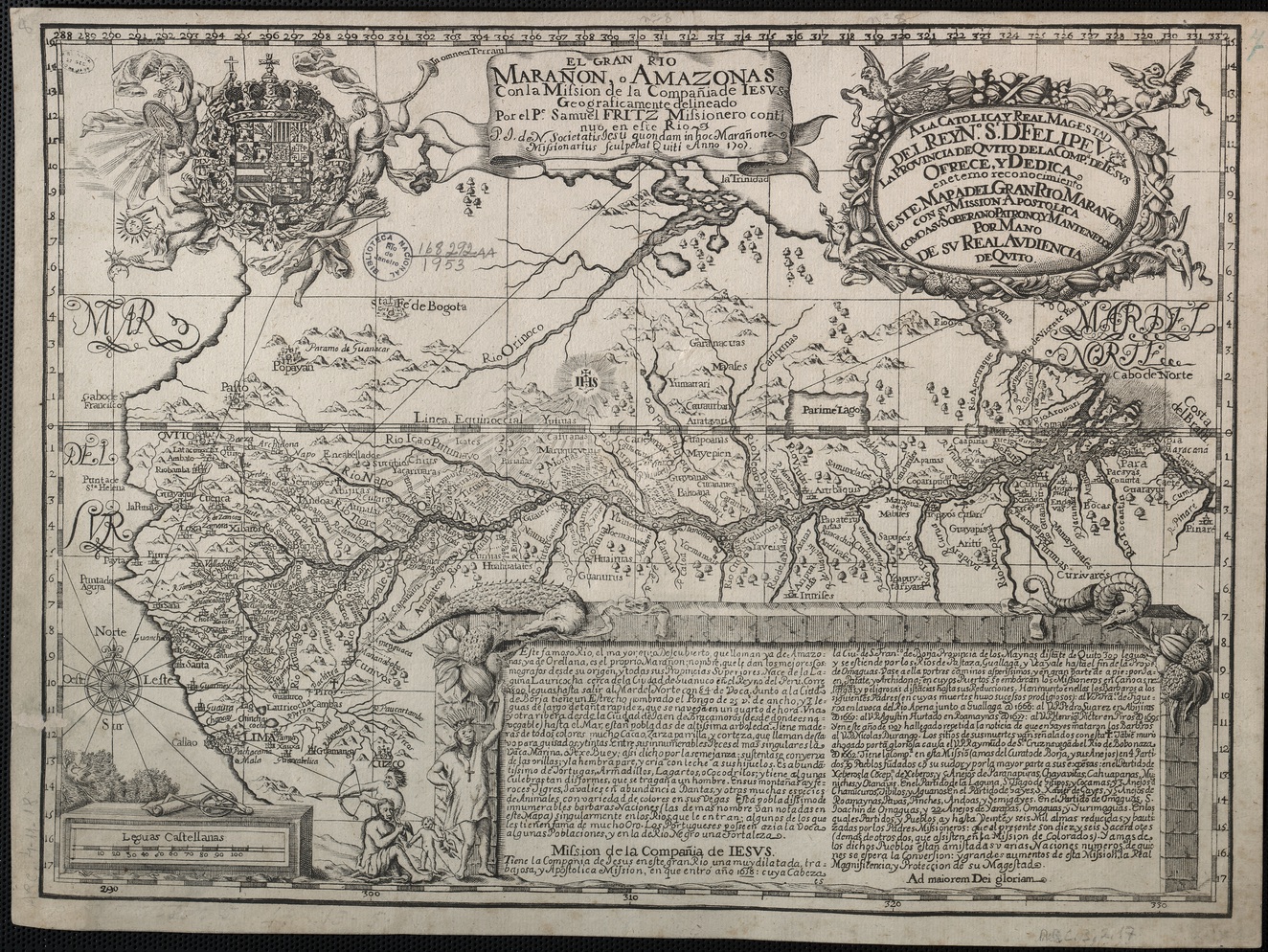 Samuel Fritz's 1707 map showing the Amazon and the Orinoco Between 1637 and 1715, Samuel Fritz founded 38 missions along the length of the Amazon river, between the Napo and Negro rivers, that were called the Omagua Missions. These missions were continually attacked by the Brazilian Bandeirantes beginning in the year 1705. In 1768, the only Omagua mission that was left was San Joaquin de Omaguas, since it had been moved to a new location on the Napo river away from the Bandeirantes. In the immense territory of Maynas, the Jesuits of Quito made contact with a number of indigenous tribes which spoke 40 different languages, and founded a total of 173 Jesuit missions encompassing 150,000 inhabitants. Because of the constant epidemics (smallpox and measles) and warfare with other tribes and the Bandeirantes, the total number of Jesuit Missions were reduced to 40 by 1744. The Jesuit missions offered the Indigenous people Christianity, iron tools, and a small degree of protection from the slavers and the colonists. In exchange, the Indigenous had to submit to Jesuit discipline and adopt, at least superficially, a lifestyle foreign to their experience. The population of the missions was only sustained by frequent expeditions into the jungle by Jesuits, soldiers, and Christian Indians to capture Indigenous people and force them to return or to settle in the missions.[101] At the time when the Jesuits were expelled from Spanish America in 1767, the Jesuits registered 36 missions run by 25 Jesuits in the Audiencia of Quito – 6 in the Napo and Aguarico Missions and 19 in the Pastaza and Iquitos Missions, with a population at 20,000 inhabitants.[102] |
スペイン領北アメリカ この節は検証可能な参考文献や出典が全く示されていないか、不十分です。この記事を改善するために、この節の信頼できる情報源を追加してください。出典の 明記されていない内容は、異議を申し立てられ、削除される場合があります。 (2020年8月) (Learn how and when to remove this message)  アコスタ著『アメリカ大陸の自然と道徳史』(1590年)のテキスト イエズス会は1571年までにペルー副王領に到着した。そこはスペイン帝国の重要な地域であり、先住民の人口が密集していただけでなく、ポトシには膨大な 量の銀が埋蔵されていた。イエズス会の第一派の主要人物はホセ・デ・アコスタ(1540年-1600年)で、著書『Historia natural y moral de las Indias』(1590年)では、流麗な散文と鋭い観察と説明により、ペルーでの15年間の滞在とヌエバ・エスパーニャ(メキシコ)での滞在を基に、 ヨーロッパの人々にスペインのアメリカ帝国を紹介した。ペルー総督フランシスコ・デ・トレドは、イエズス会にペルーの先住民への布教を促し、彼らを教区の 責任者にしようとしたが、アコスタはイエズス会の立場を固守し、先住民は司教の管轄下にはなく、先住民の教区でカテキズムを行うことは司教との対立を招く ことになると考えた。そのため、ペルーのイエズス会は先住民よりもエリート男性の教育に重点を置いた。  カルタヘナでアフリカ人奴隷に奉仕するペドロ・クラヴェル 新たに到着したアフリカ人奴隷に奉仕するために、アルフォンソ・デ・サンドバル(1576年-1651年)はカルタヘナ・デ・インディアス港で働いた。サ ンドバルは、この奉仕活動について『De instauranda Aethiopum salute』(1627年)に記し、後に列聖されることになる彼の助手ペドロ・クラヴェルとともに港で奴隷輸送船に遭遇し、甲板の下に降りて 300~600人の奴隷が鎖につながれているのを見つけ、彼らに水を与えて身体的援助を行い、アフリカ人にキリスト教を紹介したことを述べている。彼の論 文では、奴隷制度や奴隷への虐待を非難することはなかったが、イエズス会の仲間たちにこの奉仕活動について教えることを求め、また、奴隷たちにどのように して信仰を教えたかを説明しようとした。 ラファエル・フェレールは、1602年から1610年にかけて、キトのイエズス会士として初めて南米アマゾン上流地域を探検し、宣教地を設立した。この地 域は、1717年に新しく設立された新グラナダ副王領に移管されるまで、ペルー副王領の一部であったキトの高等裁判所(オーディエンシア)に属していた。 1602年、フェレールはアグアリコ川、ナポ川、マラニョン川(現在のエクアドルとペルーのスクンビオス地域)の探検を開始し、1604年から1605年 にかけてはコファネ族の原住民の間で布教活動を行った。1610年、彼は背教した原住民の手で殉教した。 1639年、キトのオーディエンシアはアマゾン川の探検を再開する遠征隊を組織し、キトのイエズス会士(Jesuita Quiteño)クリストバル・デ・アキュナは、この遠征隊の一員であった。この探検隊は1639年2月16日にナポ川に上陸し、1639年12月12日 にアマゾン川のほとりにある現在のブラジル、パラー州に到着した。1641年、アクーニャはマドリードで、アマゾン川探検の回顧録『アマゾン川大発見』を 出版した。この回顧録は学術界においてアマゾン地域に関する基本文献となった。 1637年、キト出身のイエズス会士ガスパル・クギアとルーカス・デ・ラ・クエバは、スペインの入植地ボルハに近いポンゴ・デ・マンセリチェ周辺、マラ ニョン川の河岸の地域にマイナス伝道所を設立し始めた。1637年から1652年の間に、マラニョン川とその南の支流であるワラジャ川とウカヤリ川沿いに 14の伝道所が設立された。イエズス会のデ・ラ・クエバとライムンド・デ・サンタクルスは、パスタサ川とナポ川を通るキトとの新たな2つの交通ルートを開 拓した。  サミュエル・フリッツが1707年に作成したアマゾン川とオリノコ川を示す地図 1637年から1715年の間、サミュエル・フリッツはアマゾン川のナポ川とニグロ川の間の流域に38の伝道所を設立した。これらの伝道所はオマグア伝道 所と呼ばれた。これらのミッションは、1705年からブラジルのバンデイランテスに絶え間なく攻撃されていた。1768年、バンデイランテスから離れたナ ポ川の新しい場所に移転したため、残ったオマグア・ミッションはサン・ホアキン・デ・オマグアスのみとなった。 広大なマニナス領土において、キトのイエズス会は40の異なる言語を話す多数の先住民部族と接触し、15万人の住民を擁する合計173のイエズス会伝道所 を設立した。 絶え間なく発生する疫病(天然痘や麻疹)や他の部族やバンデイランテスとの戦闘により、1744年までにイエズス会伝道所の総数は40にまで減少した。イ エズス会の伝道所は先住民にキリスト教、鉄製の道具、奴隷商人や入植者からのわずかな保護を提供した。その見返りとして、先住民はイエズス会の規律に従 い、少なくとも表面的には、それまでの生活様式とは異なる生活様式を受け入れなければならなかった。宣教地の人口は、先住民を捕らえて帰還させるか、宣教 地への移住を強制するために、イエズス会士、兵士、キリスト教徒インディアンが頻繁にジャングルへ遠征することで維持されていたに過ぎなかった。 [101] 1767年にイエズス会がスペイン領アメリカから追放された当時、キトの聴罪院にはイエズス会士25名が36の宣教地を運営しており、その内訳はナポとア ガリコの宣教地が6つ、 パスタサとイキトス伝道地に19あり、人口は2万人であった。[102] |
| Paraguay Main article: Jesuit missions among the Guaraní The Guaraní people of eastern Paraguay and neighboring Brazil and Argentina were in crisis in the early 17th century. Recurrent epidemics of European diseases had reduced their population by up 50 percent and the forced labor of the encomiendas by the Spanish and mestizo colonists had made virtual slaves of many. Franciscan missionaries began establishing missions called reductions in the 1580s.[103] The first Jesuits arrived in Asunción in 1588 and founded their first mission (or reduction) of San Ignacio Guazú in 1609. The objectives of the Jesuits were to make Christians of the Guaraní, impose European values and customs (which were regarded as essential to a Christian life), and isolate and protect the Guaraní from European colonists and slavers.[103][104] Ruins of La Santisima Trinidad de Parana mission in Paraguay, founded by Jesuits in 1706 In addition to recurrent epidemics, the Guaraní were threatened by the slave-raiding Bandeirantes from Brazil, who captured natives and sold them as slaves to work in sugar plantations or as concubines and household servants. Having depleted native populations near São Paulo, they discovered the richly populated Jesuit missions. Initially, the missions had few defenses against the slavers and thousands of Guaraní were captured and enslaved. Beginning in 1631, the Jesuits moved their missions from the Guayrá province (present day Brazil and Paraguay), about 500 km (310 miles) southwest to the three borders region of Paraguay, Argentina, and Brazil. About 10,000 of 30,000 Guaraní in the missions chose to accompany the Jesuits. In 1641 and 1642, armed by the Jesuits, Guaraní armies defeated the Bandeirantes and ended the worst of the slave trade in their region. From this point on the Jesuit missions enjoyed growth and prosperity, punctuated by epidemics. At the peak of their importance in 1732, the Jesuits presided over 141,000 Guaraní (including a sprinkling of other peoples) who lived in about 30 missions.[105] The opinions of historians differ with regard to the Jesuit missions. The missions are much-romanticized with the Guaraní portrayed as innocent children of nature and the Jesuits as their wise and benevolent guides to an earthly utopia. "Proponents...highlight that the Jesuits protected the Indians from exploitation and preserved the Guaraní language and other aspects of indigenous culture." [106] "By means of religion," wrote the 18th century philosopher Jean d'Alembert, "the Jesuits established a monarchical authority in Paraguay, founded solely on their powers of persuasion and on their lenient methods of government. Masters of the country, they rendered happy the people under their sway." Voltaire called the Jesuit missions "a triumph of humanity".[107] Detractors say that "the Jesuits took away the Indians' freedom, forced them to radically change their lifestyle, physically abused them, and subjected them to disease." Moreover, the missions were inefficient and their economic success "depended on subsidies from the Jesuit order, special protection and privileges from the Crown, and the lack of competition"[106] The Jesuits are portrayed as "exploiters" who "sought to create a kingdom independent of the Spanish and Portuguese Crowns."[108] The Comunero Revolt (1721 to 1735) was a serious protest by Spanish and mestizo Paraguayans against the Jesuit missions. The residents of Paraguay violently protested the pro-Jesuit government of Paraguay, Jesuit control of Guaraní labor, and what they regarded as unfair competition for the market for products such as yerba mate. Although the revolt ultimately failed and the missions remained intact, the Jesuits were expelled from institutions they had created in Asunción.[109] In 1756, the Guaraní protested the relocation of seven missions, fighting (and losing) a brief war with both the Spanish and Portuguese. The Jesuits were accused of inciting the Guaraní to rebel.[110] In 1767, Charles III of Spain (1759–88) expelled the Jesuits from the Americas. The expulsion was part of an effort in the Bourbon Reforms to assert more Spanish control over its American colonies.[111] In total, 78 Jesuits departed from the missions leaving behind 89,000 Guaraní in 30 missions.[112] |
パラグアイ 詳細は「グアラニー族におけるイエズス会の伝道所」を参照 17世紀初頭、パラグアイ東部および隣接するブラジルとアルゼンチンのグアラニー族は危機的状況にあった。ヨーロッパから持ち込まれた疫病が繰り返し流行 したことにより人口は50パーセントも減少した。また、スペイン人とメスチゾ入植者によるオンデミエンダの強制労働により、多くの人々は事実上の奴隷と なっていた。1580年代には、フランシスコ会の宣教師たちが「削減」と呼ばれる伝道所を設立し始めた。[103] 最初のイエズス会士たちは1588年にアスンシオンに到着し、1609年に最初の伝道所(削減)であるサン・イグナシオ・グアスーを設立した。イエズス会 の目的は、グアラニー族をキリスト教に改宗させ、キリスト教的生活に不可欠とされたヨーロッパの価値観や習慣を押し付け、グアラニー族をヨーロッパからの 入植者や奴隷商人から孤立させ保護することであった。[103][104] 1706年にイエズス会によって設立されたパラグアイのラ・サンティシマ・トリニダ・デ・パラナ伝道所の遺跡 繰り返し発生する伝染病に加え、グアラニー族はブラジルから来た奴隷略奪者バンデイランテスに脅かされていた。バンデイランテスは先住民を捕らえ、奴隷と して砂糖プランテーションで働かせたり、妾や家事使用人として売っていた。サンパウロ近郊の先住民をほぼ絶滅させた後、バンデイランテスは人口の多いイエ ズス会の伝道所を発見した。当初、伝道所には奴隷商人に対する防衛手段がほとんどなく、何千人ものグアラニー族が捕らえられ、奴隷にされた。 1631年から、イエズス会はグァイラ地方(現在のブラジルとパラグアイ)から、パラグアイ、アルゼンチン、ブラジルの3国境地域まで約500キロメート ル(310マイル)南西にミッションを移した。ミッションにいたグァラニー族3万人のうち、約1万人がイエズス会に同行することを選んだ。1641年と 1642年には、イエズス会士の武装したグアラニー軍がバンデイランテスを打ち破り、その地域における最悪の奴隷貿易を終結させた。この時点から、イエズ ス会伝道は成長と繁栄を享受したが、伝染病の流行がそれを断続的に中断させた。1732年の最盛期には、イエズス会は約30の伝道所で暮らす 141,000人のグアラニー族(その他少数の他民族も含む)を統括していた。 イエズス会の伝道所については、歴史家の意見は異なる。伝道所はロマンチックに描かれ、グアラニー族は無垢な自然児として、イエズス会は彼らを導く賢明で 慈悲深い地上のユートピアの指導者として描かれている。「推進派は...イエズス会がインディアンを搾取から守り、グアラニー語やその他の先住民文化を保 存したことを強調している。」 [106] 「イエズス会は宗教によって、説得力と寛大な統治方法のみに基づいてパラグアイに君主制の権威を確立した」と、18世紀の哲学者ジャン・ダランベールは書 いた。「その国の支配者である彼らは、その影響下にある人々を幸せにした。」ヴォルテールはイエズス会の宣教活動を「人類の勝利」と呼んだ。[107] イエズス会を批判する人々は、「イエズス会はインディアンの自由を奪い、彼らの生活様式を根本的に変えさせ、彼らを肉体的に虐待し、病気にさらした」と主 張している。さらに、宣教活動は非効率的であり、その経済的成功は「イエズス会の助成金、王冠からの特別な保護と特権、そして競争相手の不在」に依存して いた[106]。イエズス会は「スペインとポルトガルの王冠から独立した王国の創設を狙う搾取者」として描かれている[108]。 1721年から1735年にかけて起こったコミネロの反乱は、スペイン人と混血パラグアイ人によるイエズス会伝道に対する深刻な抗議であった。パラグアイ 住民は、イエズス会寄りのパラグアイ政府、グアラニー人労働力のイエズス会による管理、マテ茶などの製品市場における不公平な競争とみなされたものに対し て激しく抗議した。最終的に反乱は失敗し、宣教はそのまま残ったが、イエズス会はアスンシオンで設立した機関から追放された。[109] 1756年、グアラニー族は7つの宣教地の移転に抗議し、スペインとポルトガルとの短期間の戦争(敗戦)を戦った。イエズス会はグアラニー族に反乱を扇動 したとして非難された。[110] 1767年、スペイン王カルロス3世(在位1759年~1788年)はイエズス会をアメリカ大陸から追放した。この追放は、アメリカ植民地に対するスペイ ンの支配を強化するブルボン朝改革の一環であった。[111] 合計で78人のイエズス会士が宣教地を去り、30の宣教地に8万9000人のグアラニー族が取り残された。[112] |
| Philippines The Jesuits were among the original five Catholic religious orders, alongside the Augustinians, Franciscans, Dominicans and Augustinian Recollects, who evangelized the Philippines in support of Spanish colonization.[113] The Jesuits worked particularly hard in converting the Muslims of Mindanao and Luzon from Islam to Christianity, in which case, they were successful among the cities of Zamboanga and Manila.[114] Zamboanga in particular was run like the Jesuit reductions in Paraguay and housed a large population of Peruvian and Latin American immigrants whereas Manila eventually became the capital of the Spanish colony.[115][116] 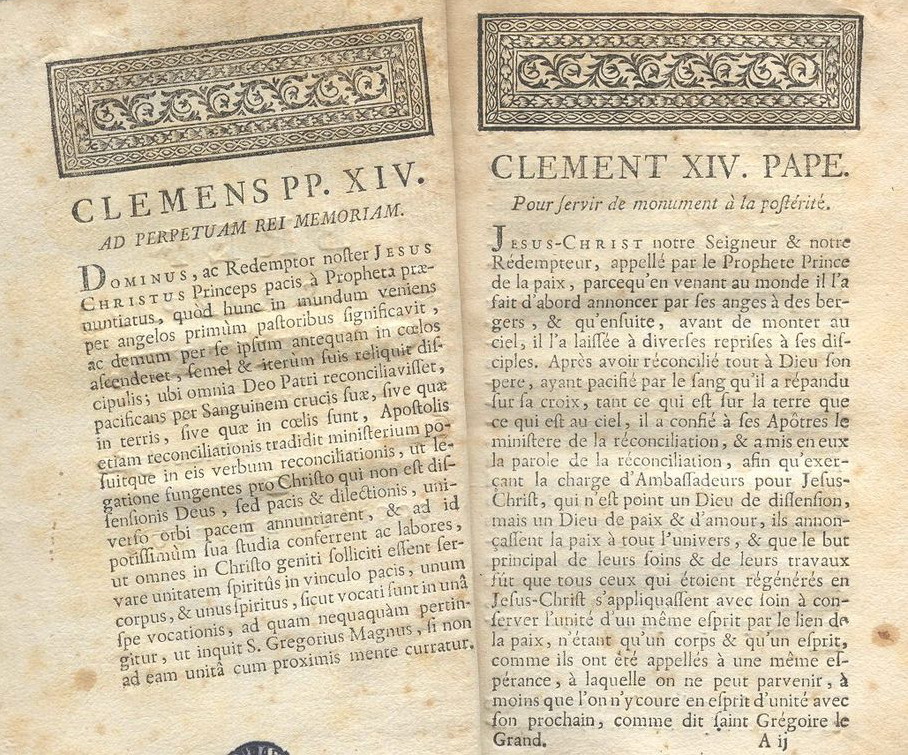 The papal brief, Dominus ac Redemptor, of Pope Clement XIV suppressing Jesuits and closing the Universidad de San Ignacio at Manila. In addition to missionary work, the Jesuits compiled artifacts and chronicled the precolonial history and culture of the Philippines. Jesuit chronicler Pedro Chirino chronicled the history of the Kedatuan of Madja-as in Panay and its war against Rajah Makatunao of Sarawak as well as the histories of other Visayan kingdoms.[117] Meanwhile, another Jesuit, Francisco Combés, chronicled the history of the Venice of the Visayas, the Kedatuan of Dapitan, its temporary conquest by the Sultanate of Ternate, its re-establishment in Mindanao and its alliance against the Sultanates of Ternate and Lanao as vassals under Christian Spain. The Jesuits also established the first missions in Hindu-dominated Butuan, to convert it to Christianity.[118] The Jesuits also founded many towns, farms, haciendas, educational institutes, libraries, and an observatory in the Philippines.[119] The Jesuits were instrumental in the sciences of medicine, botany, zoology, astronomy and seismology. They trained the Philippines' second saint, Pedro Calungsod, who was martyred in Guam alongside the Jesuit priest Diego Luis de San Vitores.[120] The eventual temporary suppression of the Jesuits due their role in anti-colonial and anti-slavery revolts among the Paraguay reductions,[104] alongside cooperation with the Recollects, allowed their vacated parishes to be put under control by the local nationalistic diocesan clergy; the martyrdom of three of them, the diocesan priests known as Gomburza,[121] inspired José Rizal (also Jesuit-educated upon the restoration of the order), who became the Philippines' national hero. He successfully started the Philippine Revolution against Spain. The Jesuits largely discredited the Freemasons, who claimed responsibility for the American and French Revolutions, by reverting Jose Rizal from Freemasonry back to Catholicism.[122] They argued that since the Philippine Revolution was inspired by the allegedly Masonic ideals behind the French and American revolutions, the French and American Freemasons themselves betrayed their own founding ideals when the American Freemasons annexed the Philippines in the Philippine-American War and the French Freemasons assented to the Treaty of Paris (1898).[123][124][125] In 1953, after being expelled from China by the Communists, the Jesuits relocated their organization's nexus in Asia from China to the Philippines and brought along a sizeable Chinese diaspora.[126] The Jesuits currently play a pivotal role in the nation-building of the Philippines with its various Ateneos and educational institutes training the country's intellectual elites.[127][128] |
フィリピン イエズス会は、スペインによる植民地化を支援するためにフィリピンで布教活動を行った、オーガスティノ会、フランシスコ会、ドミニコ会、アウグスティノ会 再覚修道会など、カトリックの5つの修道会のうちの1つであった。[113] イエズス会は特にミンダナオ島とルソン島のイスラム教徒をイスラム教からキリスト教に改宗させることに尽力し、ザンボアンガやマニラの都市部で成功を収め た。[114] 特にザンボアンガは、 パラグアイのイエズス会伝道地のように運営され、ペルーやラテンアメリカからの移民が多数居住していた。一方、マニラは最終的にスペイン植民地の首都と なった。[115][116]  教皇クレメンス14世の教皇勅書『ドミニス・アク・レデンプトル』は、イエズス会を弾圧し、マニラのサン・イグナチオ大学を閉鎖した。 宣教活動に加えて、イエズス会は出土品を収集し、フィリピンの植民地化以前の歴史と文化を記録した。イエズス会の年代記編者ペドロ・チリノは、パナイ島の マジャス王国の歴史と、サラワクのラジャ・マカタナオとの戦争、およびその他のビサヤ諸王国の歴史を年代記にまとめた。[117] 一方、別のイエズス会員フランシスコ・コンベスは、ビサヤ諸島のヴェニス、ダピタン王国の歴史を年代記にまとめた。同国は一時的にテルナテのスルタン国に 征服されたが、 ミンダナオ島への再定住、そしてキリスト教国スペインの属国としてテルナテ・スルタン国とラナオ・スルタン国に対する同盟を結んだ歴史を記録した。 イエズス会はまた、ヒンドゥー教徒が多数を占めるブトゥアンに最初の布教所を設立し、キリスト教への改宗を試みた。[118] イエズス会はフィリピンで多くの町、農場、大農園、教育機関、図書館、天文台を設立した。[119] イエズス会は医学、植物学、動物学、天文学、地震学の分野で大きな役割を果たした。彼らは、フィリピンで2番目の聖人となったペドロ・カルンソッドを訓練 した。カルンソッドは、イエズス会の司祭ディエゴ・ルイス・デ・サン・ビトレスとともにグアムで殉教した。 最終的にイエズス会が一時的に弾圧されたのは、パラグアイの還俗者たちの間で起きた反植民地・反奴隷制の反乱におけるイエズス会の役割が原因であったが [104]、レコレトス会との協力もあって、彼らが去った教区は地元の愛国的な教区聖職者たちによって統制されるようになった。3人の殉教者、ゴンブルサ として知られる教区司祭たち[121]は、ホセ・リサール(イエズス会で教育を受け、イエズス会の復活後に 。彼はフィリピンの国民的英雄となった。彼はスペインに対するフィリピン革命を成功裏に開始した。 イエズス会は、アメリカ独立革命とフランス革命の黒幕であると主張するフリーメイソンを、ホセ・リサールをフリーメイソンからカトリックに戻すことで、ほ ぼ完全に信用を失墜させた。[122] 彼らは、フィリピン革命はフリーメイソンの理想に触発されたものであると主張し、フランス革命とアメリカ独立革命の背後にあったとされるフリーメイソンの 理想に触発されたフィリピン革命であるため、アメリカ独立戦争でアメリカ合衆国のフリーメイソンがフィリピンを併合し、フランスのフリーメイソンが パリ条約(1898年)に同意した。[123][124][125] 1953年、共産党によって中国から追放されたイエズス会は、アジアにおける組織の中心を中国からフィリピンに移し、かなりの数の中国人ディアスポラを連 れて行った。[126] イエズス会は現在、フィリピンの国民形成において重要な役割を果たしており、さまざまなアテネオや教育機関で、同国の知識エリートを育成している。 [127][128] |
Colonial Brazil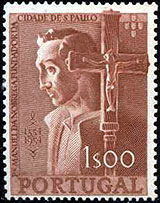 Manuel da Nóbrega on a commemorative Portuguese stamp of the 400th anniversary of the foundation of São Paulo, Brazil 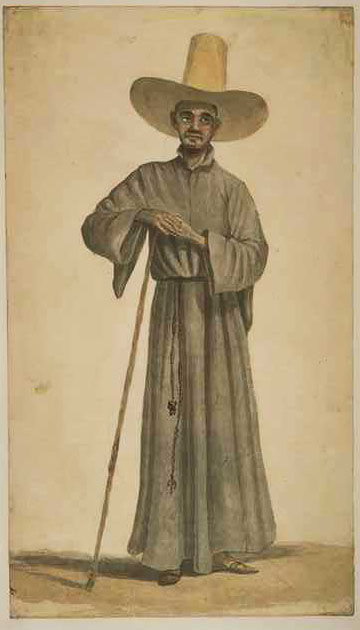 Jesuit in 18th century, Brazil Tomé de Sousa, first Governor General of Brazil, brought the first group of Jesuits to the colony. The Jesuits were officially supported by the King, who instructed Tomé de Sousa to give them all the support needed to Christianize the indigenous peoples. The first Jesuits, guided by Manuel da Nóbrega, Juan de Azpilcueta Navarro, Leonardo Nunes, and later José de Anchieta, established the first Jesuit missions in Salvador and in São Paulo dos Campos de Piratininga, the settlement that gave rise to the city of São Paulo. Nóbrega and Anchieta were instrumental in the defeat of the French colonists of France Antarctique by managing to pacify the Tamoio natives, who had previously fought the Portuguese. The Jesuits took part in the foundation of the city of Rio de Janeiro in 1565. The success of the Jesuits in converting the Indigenous peoples is linked to their efforts to understand the native cultures, especially their languages. The first grammar of the Tupi language was compiled by José de Anchieta and printed in Coimbra in 1595. The Jesuits often gathered the natives in communities (the Jesuit reductions), where the natives worked for the community and were evangelised. The Jesuits had frequent disputes with other colonists who wanted to enslave the natives. The action of the Jesuits saved many natives from being enslaved by Europeans, but also disturbed their ancestral way of life and inadvertently helped spread infectious diseases against which the natives had no natural defenses. Slave labor and trade were essential for the economy of Brazil and other American colonies, and the Jesuits usually did object to the enslavement of African peoples, criticized the conditions of slavery.[129] In cases where individual Jesuit priests criticized the institution of African slavery, they were censored and sent back to Europe.[130] |
植民地時代のブラジル ブラジルのサンパウロ市創設400周年を記念したポルトガル切手に描かれたマヌエル・ダ・ノブレガ  18世紀のブラジルにおけるイエズス会士 ブラジル総督トメ・デ・ソウザは、最初のイエズス会士の一団を植民地に連れてきた。イエズス会は国王の公認を受けており、トメ・デ・ソウザは先住民のキリスト教化に必要なあらゆる支援を彼らに与えるよう命じられていた。 マヌエル・ダ・ノブレガ、フアン・デ・アスピルクエタ・ナバーロ、レオナルド・ヌネス、そして後にホセ・デ・アンシェッタに導かれた最初のイエズス会宣教 師たちは、サルバドールとサンパウロ・ドス・カンポス・ジ・ピラティニンガ(サンパウロ市となる入植地)に最初のイエズス会伝道所を設立した。ノブレガと アンシェッタは、それまでポルトガルと戦っていたタモイオ族を平和的にまとめあげ、フランス領南極のフランス人入植者の敗北に大きく貢献した。イエズス会 は1565年のリオデジャネイロ市の創設にも参加した。 先住民の改宗におけるイエズス会の成功は、彼らが先住民の文化、特に彼らの言語を理解しようと努力したことと関連している。トゥピ語の最初の文法は、ホ セ・デ・アンシェッタによって編纂され、1595年にコインブラで印刷された。イエズス会はしばしば先住民をコミュニティ(イエズス会伝道村)に集め、そ こで先住民はコミュニティのために働き、布教を受けた。 イエズス会は、先住民を奴隷化しようとする他の入植者たちとたびたび論争を繰り広げた。イエズス会の活動により、多くの先住民がヨーロッパ人による奴隷化 を免れたが、一方で彼らの先祖伝来の生活様式を乱し、先住民が本来備えていない伝染病の蔓延をうっかり助長することにもなった。奴隷労働と貿易はブラジル や他のアメリカ植民地の経済にとって不可欠であり、イエズス会は通常、アフリカ人の奴隷化に反対し、奴隷制度の状況を批判していた。[129] イエズス会の司祭が個人としてアフリカ人奴隷制度を批判した場合は、彼らは検閲され、ヨーロッパに送還された。[130] |
| Suppression and restoration Main article: Suppression of the Society of Jesus The suppression of the Jesuits alienated the colonial empires from the natives they governed in the Americas and Asia, as the Jesuits were active protectors of native rights against the colonial empires. With the supression of the Order, the profitable Jesuit reductions which gave wealth and protection to natives were sequestered by royal authorities and the natives enslaved. Faced with this supression; the natives, mestizos, and creoles were galvinized into starting the Latin American Wars of Independence.[131] The suppression of the Jesuits in Portugal, France, the Two Sicilies, Parma, and the Spanish Empire by 1767 was deeply troubling to Pope Clement XIII, the society's defender.[132] On 21 July 1773 his successor, Pope Clement XIV, issued the papal brief Dominus ac Redemptor, decreeing: Having further considered that the said Company of Jesus can no longer produce those abundant fruits, ... in the present case, we are determining upon the fate of a society classed among the mendicant orders, both by its institute and by its privileges; after a mature deliberation, we do, out of our certain knowledge, and the fulness of our apostolical power, suppress and abolish the said company: we deprive it of all activity whatever. ...And to this end a member of the regular clergy, recommendable for his prudence and sound morals, shall be chosen to preside over and govern the said houses; so that the name of the Company shall be, and is, for ever extinguished and suppressed. — Dominus ac Redemptor[133] The suppression was carried out on political grounds in all countries except Prussia for a time, and Russia, where Catherine the Great had forbidden its promulgation. Because millions of Catholics (including many Jesuits) lived in the Polish provinces recently part-annexed by the Kingdom of Prussia, the Society was able to maintain its continuity and carry on its work all through the stormy period of suppression. Subsequently, Pope Pius VI granted formal permission for the continuation of the society in Russia and Poland, with Stanisław Czerniewicz elected superior of the province in 1782. He was followed by Gabriel Lenkiewicz, Franciszek Kareu and Gabriel Gruber until 1805, all elected locally as Temporary Vicars General. Pope Pius VII had resolved during his captivity in France to restore the Jesuits universally, and on his return to Rome he did so without much delay. On 7 August 1814, with the bull Sollicitudo omnium ecclesiarum, he reversed the suppression of the society, and therewith another Polish Jesuit, Tadeusz Brzozowski, who had been elected as superior in Russia in 1805, acquired universal jurisdiction. On his death in 1820 the Jesuits were expelled from Russia by tsar Alexander I. The period following the Restoration of the Jesuits in 1814 was marked by tremendous growth, as evidenced by the large number of Jesuit colleges and universities established during the 19th century. During this time in the United States, 22 of the society's 28 universities were founded or taken over by the Jesuits. It has been suggested that the experience of suppression had served to heighten orthodoxy among the Jesuits. While this claim is debatable, Jesuits were generally supportive of papal authority within the church, and some members became associated with the Ultramontanist movement and the declaration of papal infallibility in 1870.[134] In Switzerland, the constitution was modified and Jesuits were banished in 1848, following the defeat of the Sonderbund Catholic defence alliance. The ban was lifted on 20 May 1973, when 54.9 per cent of voters accepted a referendum modifying the constitution.[135] |
弾圧と回復 詳細は「イエズス会弾圧」を参照 イエズス会弾圧は、アメリカ大陸やアジアでイエズス会が植民地帝国に対して先住民の権利を擁護していたことから、植民地帝国と先住民の間に亀裂を生じさせ た。イエズス会弾圧により、先住民に富と保護をもたらしていたイエズス会の有益な活動は王権当局によって差し押さえられ、先住民は奴隷化された。この弾圧 に直面した先住民、混血、およびクリオールは、ラテンアメリカ独立戦争を開始するよう駆り立てられた。[131] 1767年までにポルトガル、フランス、両シチリア、パルマ、およびスペイン帝国でイエズス会が弾圧されたことは、社会の擁護者であった教皇クレメンス 13世にとって大きな悩みの種であった。[132] 1773年7月21日、彼の後継者である教皇クレメンス14世は、 教皇勅書『ドミヌス・アク・レデンプトル』を発行し、次のように宣言した。 さらに検討した結果、イエズス会はもはやそれらの豊かな果実を生み出すことはできない。... 現行の事例では、托鉢修道会に分類される団体の運命を、その制度と特権の両面から決定する。熟慮の末、我々は確かな知識と使徒的権限のすべてをもって、イ エズス会を解散し、廃止する。我々は、そのあらゆる活動を奪う。...そして、この目的のために、慎重かつ健全な道徳的判断力を持つ正規聖職者が選ばれ、 当該施設を統括し、管理することになる。これにより、同社の名称は永遠に消滅し、廃止されることになる。 — 救い主にして支配者[133] この弾圧は、一時的にプロイセンを除くすべての国々で政治的理由により実施され、また、偉大なる女帝エカテリーナ2世が布教を禁止したロシアでも実施され た。プロイセン王国が最近併合したポーランドの地方には、何百万人ものカトリック教徒(多くのイエズス会士を含む)が住んでいたため、協会は弾圧の嵐が吹 き荒れる時代を通じてその継続性を維持し、活動を続けることができた。その後、教皇ピウス6世はロシアとポーランドにおけるイエズス会の継続を正式に許可 し、1782年にスタニスワフ・チェルニェヴィチが管区長に選出された。その後、ガブリエル・レンケヴィッチ、フランシシェク・カレウ、ガブリエル・グ ルーバーが1805年まで続いたが、彼らはすべて臨時代牧師として現地で選出された。教皇ピウス7世はフランスでの捕虜生活中に、イエズス会を全世界的に 復活させることを決意し、ローマに戻るとすぐに実行に移した。1814年8月7日、教皇は「全教会の熱望」という勅書でイエズス会弾圧を撤回し、これによ り、1805年にロシアで総長に選出されていたポーランド人イエズス会員タデウシュ・ブロゾフスキが全世界的な管轄権を獲得した。1820年に彼が亡くな ると、アレクサンドル1世によってイエズス会はロシアから追放された。 1814年のイエズス会復興後の時代は、19世紀に設立された多数のイエズス会系大学によって証明されるように、著しい成長を遂げた。この時期、米国では イエズス会系の28校の大学のうち22校が設立または買収された。弾圧の経験がイエズス会内の正統性を高めることになったという指摘もある。この主張につ いては議論の余地があるが、イエズス会は一般的に教会内の教皇の権威を支持しており、一部の会員はウルトラモンタニスト運動や1870年の教皇不可謬宣言 に関与した。 スイスでは、1848年にカトリック防衛同盟の敗北を受けて憲法が修正され、イエズス会は追放された。1973年5月20日、有権者の54.9%が憲法改正の国民投票を承認したことにより、追放は解除された。[135] |
| Early 20th century In the Constitution of Norway from 1814, a relic from the earlier anti-Catholic laws of Denmark–Norway, Paragraph 2, known as the Jesuit clause, originally read: "The Evangelical-Lutheran religion remains the public religion of the State. Those inhabitants, who confess thereto, are bound to raise their children to the same. Jesuits and monastic orders are not permitted. Jews are still prohibited from entry to the Realm." Jews were first allowed into the realm in 1851 after the famous Norwegian poet Henrik Wergeland had campaigned for this permission. Monastic orders were permitted in 1897, but the ban on Jesuits was only lifted in 1956.[136] Republican Spain in the 1930s passed laws banning the Jesuits on grounds that they were obedient to a power different from the state. Pope Pius XI wrote about this: "It was an expression of a soul deeply hostile to God and the Catholic religion, to have disbanded the Religious Orders that had taken a vow of obedience to an authority different from the legitimate authority of the State. In this way it was sought to do away with the Society of Jesus – which can well glory in being one of the soundest auxiliaries of the Chair of Saint Peter – with the hope, perhaps, of then being able with less difficulty to overthrow in the near future, the Christian faith and morale in the heart of the Spanish nation, which gave to the Church of God the grand and glorious figure of Ignatius Loyola."[137] |
20世紀初頭 1814年のノルウェー憲法には、デンマーク・ノルウェーの反カトリック法の名残である第2項(イエズス会条項として知られる)が当初は次のように記され ていた。「福音ルーテル派は国家の公的宗教であり続ける。この宗教を信仰する住民は、子供たちを同じように育てることが義務付けられている。イエズス会お よび修道会は許可されていない。ユダヤ人の王国への入国は依然として禁止されている」ユダヤ人の入国が初めて許可されたのは1851年で、これはノル ウェーの著名な詩人ヘンリク・ヴェルゲランがこの許可を求めて運動した結果であった。修道会の入国は1897年に許可されたが、イエズス会への禁止は 1956年になってようやく解除された。 1930年代の共和制スペインは、イエズス会が国家とは異なる権力に従順であることを理由に、イエズス会を禁止する法律を可決した。 ピウス11世はこれについて次のように述べている。「国家の合法的な権力とは異なる権力に従順であることを誓った修道会を解散させることは、神とカトリッ クの宗教に対して深い敵意を持つ魂の表れであった。このようにして、イエズス会は廃止されることとなった。イエズス会は、サンピエトロの椅子の最も健全な 補佐役のひとつであることを誇りに思ってよいが、おそらくは、近い将来、スペイン国民の中心にあるキリスト教の信仰と道徳を、より容易に転覆させることが できるだろうという希望のもとに廃止されたのである。スペイン国民は、神の教会に壮大で輝かしいイグナティウス・ロヨラの姿を与えた国民である。」 [137] |
| Post-Vatican II The 20th century witnessed both growth and decline of the order. Following a trend within the Catholic priesthood at large, Jesuit numbers peaked in the 1950s and have declined steadily since. Meanwhile, the number of Jesuit institutions has grown considerably, due in large part to a post–Vatican II focus on the establishment of Jesuit secondary schools in inner-city areas and an increase in voluntary lay groups inspired in part by the Spiritual Exercises. Among the notable Jesuits of the 20th century, John Courtney Murray was called one of the "architects of the Second Vatican Council" and drafted what eventually became the council's endorsement of religious freedom, Dignitatis humanae. In Latin America, the Jesuits had significant influence in the development of liberation theology, a movement that was controversial in the Catholic community after the negative assessment of it by Pope John Paul II in 1984.[138] Under Superior General Pedro Arrupe, social justice and the preferential option for the poor emerged as dominant themes of the work of the Jesuits. When Arrupe was paralyzed by a stroke in 1981, Pope John Paul II, not entirely pleased with the progressive turn of the Jesuits, took the unusual step of appointing the venerable and aged Paolo Dezza for an interim to oversee "the authentic renewal of the Church",[139] instead of the progressive American priest Vincent O'Keefe whom Arrupe had preferred.[140] In 1983 John Paul gave leave for the Jesuits to appoint a successor to Arrupe. On 16 November 1989, six Jesuit priests (Ignacio Ellacuría, Segundo Montes, Ignacio Martín-Baró, Joaquin López y López, Juan Ramon Moreno, and Amado López), Elba Ramos their housekeeper, and Celia Marisela Ramos her daughter, were murdered by the Salvadoran military on the campus of the University of Central America in San Salvador, El Salvador, because they had been labeled as subversives by the government.[141] The assassinations galvanized the society's peace and justice movements, including annual protests at the Western Hemisphere Institute for Security Cooperation at Fort Benning, Georgia, United States, where several of the assassins had been trained under US government sponsorship.[142] On 21 February 2001, the Jesuit priest Avery Dulles, an internationally known author, lecturer, and theologian, was created a cardinal of the Catholic Church by Pope John Paul II. The son of former Secretary of State John Foster Dulles, Avery Dulles was long known for his carefully reasoned argumentation and fidelity to the teaching office of the church. An author of 22 books and over 700 theological articles, Dulles died on 12 December 2008 at Fordham University, where he had taught for twenty years as the Laurence J. McGinley Professor of Religion and Society. He was, at his passing, one of ten Jesuit cardinals in the Catholic Church. In 2002, Boston College president and Jesuit priest William P. Leahy initiated the Church in the 21st Century program as a means of moving the church "from crisis to renewal". The initiative has provided the society with a platform for examining issues brought about by the worldwide Catholic sex abuse cases, including the priesthood, celibacy, sexuality, women's roles, and the role of the laity.[143] |
第二バチカン公会議後 20世紀には、イエズス会の成長と衰退の両方が見られた。カトリック聖職者全体における傾向と同様に、イエズス会の会員数は1950年代にピークに達し、 それ以来、減少の一途をたどっている。一方で、イエズス会の教育機関の数は大幅に増加しており、その主な要因は、バチカン会議後のイエズス会による都市部 でのイエズス会系高校の設立への注力と、霊操に触発された自主的な信徒グループの増加である。20世紀の著名なイエズス会員の一人であるジョン・コート ニー・マレイは、「第二バチカン公会議の立案者」の一人と呼ばれ、最終的に公会議が信教の自由を承認するに至った「人間の尊厳の教え」の草案を作成した。 ラテンアメリカでは、解放の神学の発展にイエズス会が大きな影響を与えたが、この運動は1984年に教皇ヨハネ・パウロ2世が否定的な評価を下したことで、カトリック界で論争を呼んだ。[138] ペドロ・アルペ総長のもと、社会正義と貧者への優先的配慮がイエズス会の活動における主要なテーマとして浮上した。1981年にアルペが脳卒中で半身不随 となった際、イエズス会の進歩主義的な方向転換に完全に満足していなかった教皇ヨハネ・パウロ2世は、アルペが希望していた進歩的なアメリカ人司祭ビンセ ント・オキーフではなく、高齢のパオロ・デッツァを「教会の真の刷新」を監督する臨時代理に任命するという異例の措置を取った。[140] 1983年、ヨハネ・パウロ2世は イエズス会にアループの後継者を任命する許可を与えた。 1989年11月16日、エルサルバドルのサンサルバドルにある中央アメリカ大学の構内で、6人のイエズス会士(イグナシオ・エラキュリア、セグンド・モ ンテス、イグナシオ・マルティン=バロ、ホアキン・ロペス・イ・ロペス、フアン・ラモン・モレノ、アマド・ロペス)と家政婦のエルバ・ラモス、そして彼女 の娘セリア・マリセラ・ラモスが、政府によって破壊分子とみなされたために、エルサルバドル軍によって殺害された 。この暗殺事件は、社会の平和と正義の運動を活気づけた。その中には、米国ジョージア州フォートベニングの西半球安全保障協力研究所で毎年行われる抗議活 動も含まれている。この研究所では、暗殺者のうちの何人かが米国政府の支援を受けて訓練を受けていたのだ。 2001年2月21日、国際的に著名な作家、講演者、神学者であるイエズス会の神父エイブリー・ダレスは、教皇ヨハネ・パウロ2世によりカトリック教会の 枢機卿に任命された。元国務長官ジョン・フォスター・ダレスの息子であるエイブリー・ダレスは、慎重に推論された論証と教会の教職への忠誠で長い間知られ ていた。22冊の著書と700以上の神学論文の著者であるダレスは、2008年12月12日にフォーダム大学で死去した。同大学では、ローレンス・J・マ ギンレー宗教社会学部教授として20年間教鞭をとっていた。死去時、彼はカトリック教会のイエズス会士枢機卿10人のうちの1人であった。 2002年、ボストン・カレッジ学長でイエズス会の司祭であるウィリアム・P・リーヒーは、教会を「危機から再生へ」と導く手段として、「21世紀の教 会」プログラムを開始した。このイニシアティブは、世界的なカトリック教会の性的虐待事件によってもたらされた問題を検討するための基盤を社会に提供し た。検討された問題には、聖職、独身、性、女性の役割、信徒の役割などが含まれる。[143] |
 Visit of Pope Benedict XVI to the Jesuit-run Pontifical Gregorian University In April 2005, Thomas J. Reese, editor of the American Jesuit weekly magazine America, resigned at the request of the society. The move was widely published in the media as the result of pressure from the Vatican, following years of criticism by the Congregation for the Doctrine of the Faith on articles touching subjects such as HIV/AIDS, religious pluralism, homosexuality, and the right of life for the unborn. Following his resignation, Reese spent a year-long sabbatical at Santa Clara University before being named a fellow at the Woodstock Theological Center in Washington, D.C., and later senior analyst for the National Catholic Reporter. President Barack Obama appointed him to the United States Commission on International Religious Freedom in 2014 and again in 2016.[144] On 2 February 2006, Peter Hans Kolvenbach informed members of the Society of Jesus that, with the consent of Pope Benedict XVI, he intended to step down as superior general in 2008, the year he would turn 80. On 22 April 2006, the Feast of Our Lady, Mother of the Society of Jesus, Pope Benedict XVI greeted thousands of Jesuits on pilgrimage to Rome, and took the opportunity to thank God "for having granted to your Company the gift of men of extraordinary sanctity and of exceptional apostolic zeal such as St Ignatius of Loyola, St Francis Xavier, and Blessed Peter Faber". He said "St Ignatius of Loyola was above all a man of God, who gave the first place of his life to God, to his greater glory and his greater service. He was a man of profound prayer, which found its center and its culmination in the daily Eucharistic Celebration."[145] In May 2006, Benedict XVI also wrote a letter to Kolvenbach on the occasion of the 50th anniversary of Pope Pius XII's encyclical Haurietis aquas, on devotion to the Sacred Heart, because the Jesuits have always been "extremely active in the promotion of this essential devotion".[146] In his 3 November 2006 visit to the Pontifical Gregorian University, Benedict XVI cited the university as "one of the greatest services that the Society of Jesus carries out for the universal Church".[147] The 35th General Congregation of the Society of Jesus convened on 5 January 2008 and elected Adolfo Nicolás as the new superior general on 19 January 2008. In a letter to the order, Benedict XVI wrote:[148] As my Predecessors have said to you on various occasions, the Church needs you, relies on you and continues to turn to you with trust, particularly to reach those physical and spiritual places which others do not reach or have difficulty in reaching. Paul VI's words remain engraved on your hearts: "Wherever in the Church, even in the most difficult and extreme fields, at the crossroads of ideologies, in the social trenches, there has been and there is confrontation between the burning exigencies of man and the perennial message of the Gospel, here also there have been, and there are, Jesuits". — Address to the 32nd General Congregation of the Jesuits, 3 December 1974; ORE, 12 December, n. 2, p. 4. 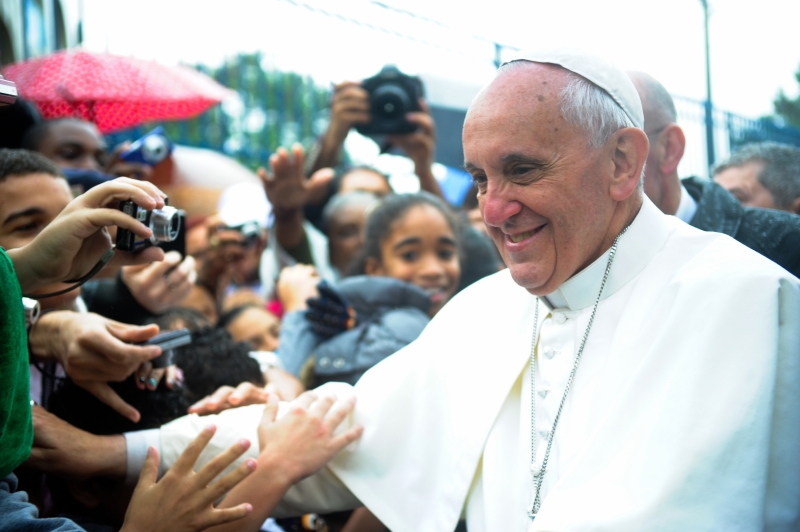 Pope Francis, the first Jesuit pope |
 教皇ベネディクト16世によるイエズス会運営の教皇庁立グレゴリアン大学訪問 2005年4月、イエズス会の週刊誌『America』の編集者トーマス・J・リースは、イエズス会の要請により辞任した。この動きは、HIV/エイズ、 宗教多元主義、同性愛、胎児の生命の権利といった問題に関する記事について、長年にわたって信仰教理省から批判を受けていたことが、バチカンの圧力による ものとして広くメディアで報道された。辞任後、リースはサンタクララ大学で1年間の研究休暇を過ごし、その後ワシントンD.C.のウッドストック神学セン ターの研究員、さらに『ナショナル・カトリック・レポーター』誌の上級アナリストに任命された。 2014年、バラク・オバマ大統領は彼を米国国際宗教自由委員会に任命し、2016年にも再任した。[144] 2006年2月2日、ペーター・ハンス・コルベンバッハは、イエズス会の会員たちに、ベネディクト16世の同意を得て、80歳になる2008年に総長を退くつもりであると伝えた。 2006年4月22日、イエズス会の聖母の祝日、ローマを巡礼する何千人ものイエズス会士たちを前に、教皇ベネディクト16世は「聖イグナチオ・ロヨラ、 聖フランシス・ザビエル、福者ペトロ・ファヴェルといった、並外れた聖性と卓越した使徒的熱意を備えた人々を貴会に与えてくださったこと」を神に感謝し た。「聖イグナチオ・ロヨラは、何よりも神の人であり、神に人生の第一の場所を捧げ、神のより大きな栄光とより大きな奉仕に献身した。彼は深い祈りの人で あり、その中心と頂点は日々の聖体礼儀にあった」と述べた。[145] 2006年5月、ベネディクト16世は、教皇ピウス12世の回勅『Haurietis aquas』の発表50周年を記念して、イエズス会が「この本質的な信心の促進に極めて積極的に取り組んできた」ことから、聖心への信心についてコルベン バッハに書簡を送った。[146] 2006年11月3日、ベネディクト16世は教皇庁立グレゴリアン大学を訪問し、 同大学を「イエズス会が全世界の教会に対して行う最大の奉仕の一つ」と述べた。[147] 2008年1月5日、イエズス会の第35回総会が召集され、2008年1月19日、アドルフォ・ニコラスが新総長に選出された。ベネディクト16世はイエズス会に宛てた書簡の中で次のように述べた。[148] 私の前任者たちがさまざまな機会にあなた方に語ってきたように、教会はあなた方を必要とし、あなた方を頼りにし、あなた方を信頼して頼り続ける。特に、他 の人々が到達できない、あるいは到達するのが困難な物理的・精神的な場所に到達するために。あなた方の心には、パウロ6世の言葉が刻み込まれている。「教 会のどこであろうと、最も困難で極端な分野であろうと、イデオロギーの交差点であろうと、社会の戦場であろうと、人間の切迫した要求と福音の永遠のメッ セージとの対立は常に存在し、これからも存在し続ける。そして、イエズス会も常に存在し、これからも存在し続けるだろう」 — 1974年12月3日、イエズス会第32回総会での演説、ORE、12月12日、第2号、4ページ。  イエズス会出身の初の教皇、フランシスコ |
| In 2013, the Jesuit cardinal
Jorge Bergoglio became Pope Francis. Before he became pope, he had been
appointed a bishop when he was in "virtual estrangement from the
Jesuits" since he was seen as "an enemy of liberation theology" and
viewed by others as "still far too orthodox". He was criticised for
colluding with the Argentine junta, while biographers characterised him
as working to save the lives of other Jesuits.[149][150][151] As a
Jesuit pope, he has stressed discernment over following rules, changing
the culture of the clergy to steer away from clericalism and to move
toward an ethic of service, i.e. to have the "smell of sheep", staying
close to the people.[152] After his papal election, Superior General
Adolfo Nicolás praised Pope Francis as a "brother among brothers".[149] On 2 October 2016, General Congregation 36 convened in Rome, convoked by Nicolás, who had announced his intention to resign at age 80.[153][154][155] On 14 October, the 36th General Congregation of the Society of Jesus elected Arturo Sosa, a Venezuelan, as its thirty-first superior general.[156] The General Congregation that elected Arturo Sosa in 2016 asked him to bring to completion the process of discerning Jesuit priorities for the time ahead. Sosa devised a plan that enlisted all Jesuits and their lay collaborators in the process of discernment over a 16-month period. Then in February 2019 he presented the results of the discernment, a list of four priorities for Jesuit ministries for the next ten years.[157] 1. To show the way to God through discernment and the Spiritual Exercises of Ignatius of Loyola; 2. To walk with the poor, the outcasts of the world, those whose dignity has been violated, in a mission of reconciliation and justice; 3. To accompany young people in the creation of a hope-filled future; 4. To collaborate in the care of our Common Home. Pope Francis gave his approval to these priorities, saying that they were in harmony with the church's present priorities and with the programmatic letter of his pontificate, Evangelii gaudium.[158] |
2013年、イエズス会の枢機卿ホルヘ・ベルゴリオは教皇フランシスコ
となった。教皇になる前、彼は「解放の神学の敵」と見なされ、また「依然として正統派すぎる」と見られていたため、「イエズス会から事実上の疎外状態」に
あった時に司教に任命されていた。アルゼンチン軍事政権と共謀したとして批判されたが、伝記作家たちは彼を他のイエズス会の命を救うために働いた人物と評
している。[149][150][151]
イエズス会の出身の教皇として、彼は規則に従うことよりも識別力を重視し、聖職者の文化を変え、聖職者主義から離れ、奉仕の倫理に向かって進むよう、すな
わち「羊の臭い」を持ち、人々に寄り添うよう促している。[152] 教皇選出後、アドルフォ・ニコラス総長は、フランシスコ教皇を「兄弟の中の兄弟」と称賛した。[149] 2016年10月2日、ニコラスが召集した第36回総会がローマで開かれ、ニコラスは80歳で辞任する意向を表明していた。[153][154][155] 10月14日、イエズス会の第36回総会は、ベネズエラ人のアルトゥロ・ソサを第31代総長に選出した。 2016年にアルトゥロ・ソサを選出した総会は、ソサに今後数年のイエズス会の優先事項を明確にするプロセスを完了させるよう要請した。ソサは、16か月 間にわたってイエズス会の全会員と彼らの平信徒協力者を識別のプロセスに参加させる計画を考案した。そして2019年2月、彼は識別の結果を発表し、今後 10年間のイエズス会の宣教における4つの優先事項のリストを示した。 1. 識別とイグナチオ・デ・ロヨラの霊操を通して神への道を示すこと。 2. 貧しい人々、世界ののけ者、尊厳を傷つけられた人々と和解と正義の使命を共に歩むこと。 3. 希望に満ちた未来を築くために若者たちに寄り添うこと。 4. 私たちの共通の家である地球の保護に協力すること。 教皇フランシスコは、これらの優先事項を承認し、それらは教会の現在の優先事項と教皇の教皇職のプログラム的な手紙『エヴァンジェリ・ガウディウム』と調和していると述べた。[158] |
| Ignatian spirituality Main article: Ignatian spirituality The spirituality practiced by the Jesuits, called Ignatian spirituality, ultimately based on the Catholic faith and the gospels, is drawn from the Constitutions, The Letters, and Autobiography, and most specially from Ignatius' Spiritual Exercises, whose purpose is "to conquer oneself and to regulate one's life in such a way that no decision is made under the influence of any inordinate attachment". The Exercises culminate in a contemplation whereby one develops a facility to "find God in all things". |
イグナチオ会の霊性 詳細は「イグナチオ会の霊性」を参照 イエズス会士たちが実践する霊性は、イグナチオ会の霊性と呼ばれ、最終的にはカトリックの信仰と福音書に基づいている。それは会則、書簡、自伝から導き出 されたものであり、特に『イグナチオの霊操』から導き出されたものである。その目的は「自分自身を克服し、いかなる過剰な執着の影響下でも決定が下されな いように、自らの生活を律すること」である。この鍛錬は、最終的には「あらゆるものの中に神を見出す」能力を開発する瞑想に到達する。 |
| Formation Main article: Jesuit formation The formation (training) of Jesuits seeks to prepare men spiritually, academically, and practically for the ministries they will be called to offer the church and world. Ignatius was strongly influenced by the Renaissance, and he wanted Jesuits to be able to offer whatever ministries were most needed at any given moment and, especially, to be ready to respond to missions (assignments) from the pope. Formation for priesthood normally takes between eight and fourteen years, depending on the man's background and previous education, and final vows are taken several years after that, making Jesuit formation among the longest of any of the religious orders. |
修練 詳細は「イエズス会の修練」を参照 イエズス会の修練(訓練)は、教会や世界に対して奉仕するよう求められる男性たちを、精神面、学問面、実践面で準備させることを目的としている。イグナチ オはルネサンスから強い影響を受けており、イエズス会士には、その時々に最も必要とされる奉仕を何でも提供できる能力を身につけさせたいと考えていた。特 に、教皇からの任務(任命)にいつでも対応できるよう備えておくことを望んでいた。司祭になるための修練は通常、その人物の経歴やこれまでの教育によって 異なるが、8年から14年を要し、最終的な誓願はそれから数年後に立てられる。そのため、イエズス会の修練は、宗教的修道会の中でも最も長い期間である。 |
| Governance of the society The society is headed by a Superior General with the formal title Praepositus Generalis, Latin for "provost-general", more commonly called Father General. He is elected by the General Congregation for life or until he resigns; he is confirmed by the pope and has absolute authority in running the Society. The current Superior General of the Jesuits is the Venezuelan Arturo Sosa who was elected on 14 October 2016.[159] The Father General is assisted by "assistants", four of whom are "assistants for provident care" and serve as general advisors and a sort of inner council, and several other regional assistants, each of whom heads an "assistancy", which is either a geographic area (for instance the North American Assistancy) or an area of ministry (for instance higher education). The assistants normally reside with Father General in Rome and along with others form an advisory council to the General. A vicar general and secretary of the society run day-to-day administration. The General is also required to have an admonitor, a confidential advisor whose task is to warn the General honestly and confidentially when he might be acting imprudently or contrary to the church's magisterium. The central staff of the General is known as the Curia.[159] The society is divided into geographic areas called provinces, each of which is headed by a Provincial Superior, formally called Father Provincial, chosen by the Superior General. He has authority over all Jesuits and ministries in his area, and is assisted by a socius who acts as a sort of secretary and chief of staff. With the approval of the Superior General, the Provincial Superior appoints a novice master and a master of tertians to oversee formation, and rectors of local communities of Jesuits.[160] For better cooperation and apostolic efficacy in each continent, the Jesuit provinces are grouped into six Jesuit Conferences worldwide. Each Jesuit community within a province is normally headed by a rector who is assisted by a "minister", from the Latin word for "servant", a priest who helps oversee the community's day-to-day needs.[161] The General Congregation is a meeting of all of the assistants, provincials, and additional representatives who are elected by the professed Jesuits of each province. It meets irregularly and rarely, normally to elect a new superior general and/or to take up some major policy issues for the order. The Superior General meets more regularly with smaller councils composed of just the provincials.[162] |
社会の統治 イエズス会は、正式名称を「総長」、ラテン語では「総長」を意味する「Praepositus Generalis」という称号を持つ総長が統括する。総長は、終身または辞任するまで、総会によって選出される。教皇によって任命され、イエズス会の運 営に関する絶対的な権限を持つ。現在のイエズス会総長は、2016年10月14日に選出されたベネズエラ出身のアルトゥロ・ソサである。 総長は「アシスタント」と呼ばれる補佐役によって補佐される。アシスタントは4人の「予見的ケア担当アシスタント」と、一般顧問および一種の内部評議会と して機能する者たち、および複数の地域別アシスタントからなり、それぞれが「アシスタンス」と呼ばれる、地理的地域(例えば北米アシスタンス)または宣教 分野(例えば高等教育)を統括する。アシスタントは通常、ローマの総長のもとに居住し、他の者たちとともに総長への諮問評議会を構成する。また、日常的な 管理業務は、総代理と書記が担当している。総長にはアドモニクター(admonitor)と呼ばれる秘密の顧問も必要であり、その任務は、総長が軽率な行 動を取ったり、教会の教権に反する行動を取ったりしそうになった場合に、正直かつ秘密裏に総長に警告することである。総長の中央スタッフは「教皇庁」とし て知られている。[159] この会は、それぞれが管区長(正式には「神父管区長」と呼ばれる)によって統括される、地方と呼ばれる地理的地域に分けられている。彼は、その管轄地域内 のすべてのイエズス会士と部署に対して権限を持ち、書記および参謀のような役割を果たすソシウス(socius)の補佐を受ける。管区長は、総長の承認を 得て、修練長とテルチアン(tertians)の修練長を任命し、イエズス会の地域共同体(local communities)の院長を監督する。各大陸におけるより良い協力と使徒的効果を目的として、イエズス会の管区は世界で6つのイエズス会会議にグ ループ分けされている。 通常、各管区内のイエズス会コミュニティは、助祭(「しもべ」を意味するラテン語)である司祭が日常的なニーズの監督を助ける「助祭」によって補佐される院長によって統括されている。 総会は、各管区の誓願を立てたイエズス会士によって選出されたすべての補佐役、管区長、追加代表者による会議である。総会は不定期に開催され、通常は新総 長の選出や、修道会の主要な政策課題の討議を目的としている。総長は、管区長のみで構成される小規模な協議会に、より定期的に出席する。[162] |
| Statistics As of 2012, the Jesuits formed the largest single religious order of priests and brothers in the Catholic Church.[166] The Jesuits have experienced a decline in numbers in recent decades. As of 2022, the society had 14,439 members (10,432 priests, 837 brothers, 2,587 scholastics, and 583 novices).[163] This represents a 59% percent decline since the Second Vatican Council (1965), when the society had a total membership of 36,038, of which 20,301 were priests.[167] This decline is most pronounced in Europe and the Americas, with relatively modest membership gains occurring in Asia and Africa.[168][169] According to Patrick Reilly of the National Catholic Register, there seems to be no "Pope Francis effect" in counteracting the fall of vocations among the Jesuits.[170] Twenty-eight novices took first vows in the Jesuits in the United States and Haiti in 2019.[171] In September 2019, the superior general of the Jesuits, Arturo Sosa, estimated that by 2034 the number would decrease to about 10,000 Jesuits, with a much younger average age than in 2019, and with a shift away from Europe and into Latin America, Africa, and India.[172] In 2008, their average age was 57.3 years: 63.4 years for priests, 29.9 years for scholastics, and 65.5 years for brothers.[20] The current Superior General of the Jesuits is Arturo Sosa. The society is characterized by its ministries in the fields of missionary work, human rights, social justice and, most notably, higher education. It operates colleges and universities in various countries around the world and is particularly active in the Philippines and India. In the United States the Jesuits have historical ties to 27 colleges and universities and 61 high schools. The degree to which the Jesuits are involved in the administration of each institution varies. As of September 2018, 15 of the 27 Jesuit universities in the US had non-Jesuit lay presidents.[173] According to a 2014 article in The Atlantic, "the number of Jesuit priests who are active in everyday operations at the schools isn't nearly as high as it once was".[174] Worldwide it runs 322 secondary schools and 172 colleges and universities. A typical conception of the mission of a Jesuit school will often contain such concepts as proposing Christ as the model of human life, the pursuit of excellence in teaching and learning, lifelong spiritual and intellectual growth,[175] and training men and women for others.[176] 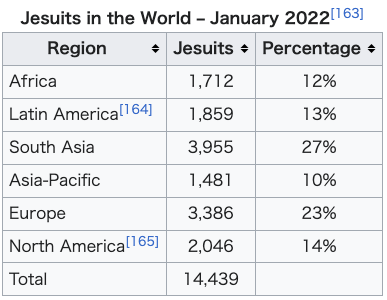 |
統計 2012年現在、イエズス会はカトリック教会における司祭と修道士の最大の単一修道会である。[166] イエズス会はここ数十年で会員数が減少している。2022年現在、会員数は14,439人(司祭10,432人、修道士837人、学究会員2,587人、 修練会員583人)である。[163] これは、第二バチカン公会議(1965年)以降、59%の減少を意味する。公会議当時の会員総数は36,038人であり、そのうち司祭は20,3 01人が司祭であった。[167] この減少はヨーロッパとアメリカ大陸で最も顕著であり、アジアとアフリカでは比較的緩やかな会員増加が見られた。[168][169] 『ナショナル・カトリック・レジスター』のパトリック・ライリーによると、イエズス会士の職業志願者の減少に歯止めをかける「フランシスコ教皇効果」は見 られないようだ。[170] 2019年には、アメリカ合衆国とハイチで28人の修練者がイエズス会で最初の誓いを立てた 。2019年9月、イエズス会のアルトゥロ・ソサ総長は、2034年までにイエズス会の数は約1万人に減少すると推定し、2019年よりも平均年齢が大幅 に若くなり、ヨーロッパからラテンアメリカ、アフリカ、インドへとシフトすると述べた。 7.3歳:司祭は63.4歳、修道士は29.9歳、兄弟は65.5歳であった。 [20] 現在のイエズス会総長はアルトゥロ・ソサである。イエズス会は、宣教活動、人権、社会正義、そして特に高等教育の分野における奉仕活動で知られている。世 界中のさまざまな国で大学を運営しており、特にフィリピンとインドで活発に活動している。米国ではイエズス会は27の大学と61の高校と歴史的なつながり がある。イエズス会が各教育機関の運営にどの程度関与しているかは様々である。2018年9月現在、米国のイエズス会系大学27校のうち15校では、イエ ズス会以外の一般人が学長を務めている。[173] 2014年の『アトランティック』誌の記事によると、「学校の日常業務に携わるイエズス会の司祭の数は、かつてほど多くはない」という。[174] 世界全体では、322の高等学校と172の大学・短大を運営している。イエズス会の学校の使命に関する一般的な考え方には、キリストを人間生活の模範とし て提案すること、教育と学習における卓越性の追求、生涯にわたる精神面と知性の成長、[175] 他者のために働く男女の育成[176] といった概念が含まれることが多い。  |
| Habit and dress Jesuits do not have an official habit. The society's Constitutions gives the following instructions: "The clothing too should have three characteristics: first, it should be proper; second, conformed to the usage of the country of residence; and third, not contradictory to the poverty we profess." (Const. 577) The traditional Jesuit-style cassock, called a "soutane" is similar to a robe which is wrapped around the body and was tied with a cincture, rather than the customary buttoned front cassock worn by diocesan priests.[177] A tuftless biretta (only diocesan clergy wore tufts) and a ferraiolo (cape) completed the look.[178] Today, most Jesuits in the United States wear the clerical collar and black clothing of diocesan priests[179] while most Jesuits in Europe are dressed in civilian clothes. |
習慣と服装 イエズス会には公式の修道服はない。会の憲章には次のように指示されている。「服装にも3つの特徴があるべきである。第一に、適切なものであること。第二に、居住国の慣習に適合していること。第三に、私たちが公言する貧しさに矛盾しないこと。」(憲章577) 「スータン」と呼ばれる伝統的なイエズス会式のカソックは、教区司祭が着用するボタン留めの一般的なカソックではなく、体に巻きつけて帯で締めるローブに似ている。房飾りのないビレッタ(房飾りは教区司祭のみ着用)とフェリオロ(ケープ)が外観を完成させる。 現在、米国のイエズス会のほとんどは教区司祭の聖職者用カラーと黒服を着用しているが[179]、ヨーロッパのイエズス会のほとんどは私服を着用している。 |
| Controversies Slavery Jesuit scholar Andrew Dial has calculated that the Jesuits owned more than 20,000 slaves worldwide in 1760, the great majority of them in the Americas.[180] The Jesuits in some places protected the indigenous people of the Americas from slavers, notably the Guaraní in South America, but in other places they enslaved indigenous people after "just wars" in which indigenous people who resisted European colonization were defeated. The Jesuits also participated in the Atlantic slave trade, working thousands of African slaves on their large plantations scattered throughout the Americas. Antoine Lavalette, a slave-owning French Jesuit in Martinique, accumulated large debts which he was unable to pay which led to the banning of the Jesuits in France in 1764. In the United States, tobacco plantations utilizing African-American slave labor in Maryland and other states supported Jesuit institutions such as Georgetown University, from which were infamously sold 272 slaves in 1838. In the 16th century, Jesuits were also complicit in the Portuguese trade in enslaved East Asians. In other parts of Europe, slaves were probably employed in Jesuit schools and institutions. The Jesuits justified their ownership of slaves and participation in the slave trade as a means of converting slaves to Catholicism. "Enslaved people...were a captive audience for evangelization."[181][182] |
論争 奴隷制度 イエズス会の学者であるアンドリュー・ダイヤルは、1760年当時、イエズス会は全世界で2万人以上の奴隷を所有しており、その大半はアメリカ大陸にいた と計算している。[180] イエズス会は、いくつかの地域ではアメリカ大陸の先住民を奴隷商人から守り、特に南アメリカのグアラニー族を守ったが、他の地域では、ヨーロッパの植民地 化に抵抗した先住民を打ち負かした「正義の戦争」の後、先住民を奴隷にした。 イエズス会は大西洋奴隷貿易にも参加し、アメリカ大陸各地に広大な農園を所有して、数千人のアフリカ人奴隷を働かせていた。マルティニクの奴隷所有者であ るフランス人イエズス会員のアントワーヌ・ラヴァレットは、支払うことのできない多額の負債を積み重ね、これが原因で1764年にフランスでイエズス会が 禁止されることとなった。 米国では、メリーランド州やその他の州でアフリカ系アメリカ人の奴隷労働力を利用したタバコ農園が、ジョージタウン大学などのイエズス会の教育機関を支えていたが、同大学では1838年に272人の奴隷が売られたことで悪名高い。 16世紀には、イエズス会はポルトガルによる東アジア人の奴隷貿易にも加担していた。ヨーロッパの他の地域では、イエズス会の学校や施設で奴隷が雇用されていた可能性が高い。 イエズス会は、奴隷を所有し奴隷貿易に参加することを、奴隷をカトリックに改宗させるための手段として正当化した。「奴隷の人々は...福音伝道のための捕虜のような存在であった」[181][182] |
| Power-seeking The Monita Secreta (Secret Instructions of the Jesuits), published in 1612 and in 1614 in Kraków, is alleged to have been written by Claudio Acquaviva, the fifth general of the society, but was probably written by former Jesuit Jerome Zahorowski. It purports to describe the methods to be adopted by Jesuits for the acquisition of greater power and influence for the society and for the Catholic Church. The Catholic Encyclopedia states the book is a forgery, fabricated to ascribe a sinister reputation to the Society of Jesus.[183] |
権力追求 1612年と1614年にクラクフで出版された『モニタ・シークレタ(イエズス会の秘密指令)』は、同会の第5代総長クラウディオ・アクアヴィヴァが著し たとされているが、おそらくは元イエズス会員のジェローム・ザホロフスキによるものと思われる。この本は、イエズス会が同会およびカトリック教会により大 きな権力と影響力を得るために採用すべき方法を説明しているとされる。カトリック百科事典は、この本はイエズス会に悪評を着せるためにでっちあげられた偽 書であると述べている。[183] |
| Political intrigue The Jesuits were temporarily banished from France in 1594 after a man named Jean Châtel tried to assassinate the king of France, Henri IV. Under questioning, Châtel revealed that he had been educated by the Jesuits of the Collège de Clermont. The Jesuits were accused of inspiring Châtel's attack. Two of his former teachers were exiled and a third was hanged.[184] The Collège de Clermont was closed, and the building was confiscated. The Jesuits were banned from France, although this ban was quickly lifted and the school eventually reopened.[185] In England, Henry Garnet, one of the leading English Jesuits, was hanged for misprision of treason because of his knowledge of the Gunpowder Plot (1605). The Plot was the attempted assassination of James VI and I, his family, and most of the Protestant aristocracy in a single attack, by exploding the Houses of Parliament. Another Jesuit, Oswald Tesimond, managed to escape arrest for his involvement in this plot.[186] |
政治的陰謀 1594年、ジャン・シャテルという男がフランス王アンリ4世を暗殺しようとした事件の後、イエズス会はフランスから一時追放された。尋問を受けたシャテ ルは、クレルモン・カレッジのイエズス会で教育を受けたことを明かした。イエズス会はシャテルの襲撃を扇動したとして非難された。シャテルの元教師2名は 追放され、3人目は絞首刑となった。[184] クレルモン・カレッジは閉鎖され、建物は没収された。イエズス会はフランスから追放されたが、この追放はすぐに解除され、学校は最終的に再開された。 [185] イングランドでは、イギリス人イエズス会の指導者の一人であったヘンリー・ガーネットが、火薬陰謀(1605年)に関する知識を理由に、反逆罪の不告発の 罪で絞首刑にされた。この陰謀は、ジェームズ6世と1世、その家族、そしてプロテスタントの貴族のほとんどを、議会を爆破することで一度に暗殺しようとし たものであった。この陰謀に関与したことで逮捕を免れたのは、イエズス会の修道士オズワルド・テシモンドであった。[186] |
| Casuistic justification Jesuits have been accused of using casuistry to obtain justifications for unjustifiable actions (cf. formulary controversy and Lettres Provinciales, by Blaise Pascal).[187] Hence, the Concise Oxford Dictionary of the English language lists "equivocating" as a secondary denotation of the word "Jesuit". Modern critics of the Society of Jesus include Avro Manhattan, Alberto Rivera, and Malachi Martin, the latter being the author of The Jesuits: The Society of Jesus and the Betrayal of the Roman Catholic Church (1987).[188] |
詭弁的な正当化 イエズス会は、正当化できない行動を正当化するために詭弁を用いていると非難されてきた(参照:処方論争およびブレーズ・パスカル著『地方書簡』)。 [187] そのため、英語のオックスフォード簡明辞典では、「イエズス会」という単語の副次的な意味として「あいまいな」という意味が挙げられている。イエズス会に 対する現代の批判者には、アヴロ・マンハッタン、アルベルト・リベラ、マラカイ・マーティンなどがいる。後者は『イエズス会:イエズス会とローマ・カト リック教会の裏切り』(1987年)の著者である。[188] |
| Exclusion of those of Jewish or Muslim ancestry Although in the first 30 years of the existence of the Society of Jesus there were many Jesuits who were conversos (Catholic-convert Jews and Muslims and their descendants), an anti-converso faction led to the Decree de genere (1593) which proclaimed that either Jewish or Muslim ancestry, no matter how distant, was an insurmountable impediment for admission to the Society of Jesus.[189] This new rule was contrary to the original wishes of Ignatius who "said that he would take it as a special grace from our Lord to come from Jewish lineage".[190] The 16th-century Decree de genere was repealed in 1946.[b] Bylaws requiring "blood purity" became common across Early Modern Spain and Portugal. |
ユダヤ教またはイスラム教の家系である者の排除 イエズス会の創設から30年間は、コンベルソ(改宗したユダヤ教徒やイスラム教徒、およびその子孫)のイエズス会員も多かったが、コンベルソ排斥派の動き により、1593年の「種姓令(Decree de genere)」が発令され、ユダヤ教やイスラム教の血筋は、それがどれほど遠い先祖のものであっても、イエズス会への入会を妨げる乗り越えられない障害 であると宣言された。[189] この新しい規則は、イグナティウスが当初抱いていた希望に反するものであった。 「ユダヤ人の血筋であることは、主からの特別な恩寵である」と述べていた。[190] 16世紀の「種族令」は1946年に廃止された。[b] 「純粋な血統」を求める規則は、近世のスペインとポルトガルで一般的となった。 |
| Theological debates Within the Catholic Church, there has existed a sometimes tense relationship between Jesuits and the Holy See, due to questioning of official church teaching and papal directives, such as those on abortion,[irrelevant citation][193][194] birth control,[195][196][197][198] women deacons,[199] homosexuality, and liberation theology.[200][201] At the same time, Jesuits have been appointed to prominent doctrinal and theological positions in the church; under Pope Benedict XVI, Archbishop Luis Ladaria Ferrer was Secretary and later, under Pope Francis, Prefect of the Congregation for the Doctrine of the Faith.[202][203] |
神学上の論争 カトリック教会内では、教会の公式教えや教皇の指令に疑問を呈したため、イエズス会と聖座との間に緊張関係が生じることもあった。例えば、中絶[193] [194]、避妊[195][196][197][198]、女性助祭[199]、同性愛、解放の神学[200][201]などである。同時に、イエズス 会士は 教会の主要な教義および神学上の役職に任命されている。教皇ベネディクト16世のもとではルイス・ラダリア・フェレール大司教が教理省長官を務め、その 後、教皇フランシスコのもとでは信仰教理省長官を務めている。[202][203] |
| Religious persecution In the quest to evangelize, Jesuits persecuted people of other religions, including Hindus, Muslims and other Christians. The Goan Inquisition was one among various persecutions that Jesuits were involved in. Voltaire wrote that:[204][205] Goa is sadly famous for its inquisition, equally contrary to humanity and commerce. The Portuguese monks made us believe that the people worshipped the devil, and it is they who have served him. |
宗教迫害 布教活動の一環として、イエズス会はヒンズー教徒、イスラム教徒、その他のキリスト教徒を含む他宗教の信者を迫害した。ゴア異端審問は、イエズス会が関与した数々の迫害事件のひとつである。ヴォルテールは次のように書いている。 ゴアは、その異端審問で悲しいほど有名である。それは人道と商業に反するものでもある。ポルトガルの修道士たちは、人々が悪魔を崇拝し、悪魔に仕えていると信じ込ませた。 |
| Nazi persecution Main article: Jesuits and Nazi Germany The Catholic Church faced persecution in Nazi Germany. Hitler was anticlerical and had particular disdain for the Jesuits. According to John Pollard, the Jesuits' "ethos represented the most intransigent opposition to the philosophy of Nazism",[206] and so the Nazis considered them as one of their most dangerous enemies. A Jesuit college in the city of Innsbruck served as a center for anti-Nazi resistance and was closed down by the Nazis in 1938.[207] Jesuits were a target for Gestapo persecution, and many Jesuit priests were deported to death camps.[208] Jesuits made up the largest contingent of clergy imprisoned in the Priest Barracks of Dachau Concentration Camp.[209] Vincent Lapomarda lists some 30 Jesuits as having died at Dachau.[210] Of the total of 152 Jesuits murdered by the Nazis across Europe, 43 died in the death camps and an additional 27 died from captivity or its results.[211] The Superior General of Jesuits at the outbreak of war was Wlodzimierz Ledóchowski, a Pole. The Nazi persecution of the Catholic Church in Poland was particularly severe. Lapomarda wrote that Ledóchowski helped "stiffen the general attitude of the Jesuits against the Nazis" and that he permitted Vatican Radio to carry on its campaign against the Nazis in Poland. Vatican Radio was run by the Jesuit Filippo Soccorsi and spoke out against Nazi oppression, particularly with regard to Poland and to Vichy-French antisemitism.[212] 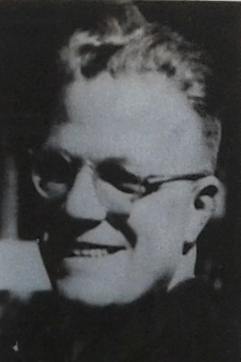 Jesuit Alfred Delp, member of the Kreisau Circle that operated within Nazi Germany was executed in February 1945[213] Several Jesuits were prominent in the small German Resistance.[214] Among the central membership of the Kreisau Circle of the Resistance were the Jesuit priests Augustin Rösch, Alfred Delp, and Lothar König.[215] The Bavarian Jesuit Provincial, Augustin Rösch, ended the war on death row for his role in the July Plot to overthrow Hitler. Another non-military German Resistance group, dubbed the "Frau Solf Tea Party" by the Gestapo, included the Jesuit priest Friedrich Erxleben.[216] The German Jesuit Robert Leiber acted as intermediary between Pius XII and the German Resistance.[217][218] Among the Jesuit victims of the Nazis, Germany's Rupert Mayer has been beatified. Mayer was a Bavarian Jesuit who clashed with the Nazis as early as 1923. Continuing his critique following Hitler's rise to power, Mayer was imprisoned in 1939 and sent to Sachsenhausen death camp. As his health declined, the Nazis feared the creation of a martyr and sent him to the Abbey of Ettal in 1940. There he continued to give sermons and lectures against the evils of the Nazi régime, until his death in 1945.[219][220] |
ナチスの迫害 詳細は「イエズス会とナチス・ドイツ」を参照 カトリック教会はナチス・ドイツにおいて迫害を受けた。ヒトラーは反教権主義者であり、特にイエズス会に対して強い嫌悪感を抱いていた。ジョン・ポラード によると、イエズス会の「エートスはナチズムの哲学に対する最も強硬な反対を象徴するものであった」ため[206]、ナチスは彼らを最も危険な敵の1つと みなした。インスブルック市のイエズス会系大学は反ナチ抵抗運動の拠点となっていたが、1938年にナチスによって閉鎖された。[207] イエズス会士はゲシュタポの迫害の対象となり、多くのイエズス会司祭が強制収容所に送られた。[208] イエズス会士はダッハウ強制収容所の司祭用バラックに収容された聖職者の中で最も多い割合を占めていた。[209] ヴィンセント・ラポマルダは、ダッハウで死亡したイエズス会士を約30人挙げている ダッハウで死亡したとされている。[210] ヨーロッパ全土でナチスによって殺害されたイエズス会士152人のうち、43人が強制収容所で死亡し、さらに27人が捕虜生活またはその影響で死亡した。 [211] 開戦時のイエズス会総長はポーランド人のヴワディスワフ・レドホフスキであった。ナチスによるポーランドのカトリック教会への迫害は特に厳しかった。ラポ マルダは、レドホフスキが「イエズス会のナチスに対する一般的な態度を強化する」のに役立ったと記し、また、彼はバチカン放送がポーランドにおけるナチス に対するキャンペーンを継続することを許可したと述べた。バチカン放送はイエズス会のフィリッポ・ソッコルシが運営し、ナチスの弾圧、特にポーランドと ヴィシー政権下のフランスの反ユダヤ主義に対して声を上げた。  ナチス・ドイツ国内で活動していたクライザウ・サークルのメンバーであったイエズス会のアルフレッド・デルプは、1945年2月に処刑された。 ドイツのレジスタンス運動では、何人かのイエズス会士が中心的な役割を果たした。[214] レジスタンス運動のクライザウ・サークルの中心メンバーには、イエズス会のアウグスティン・ロッシュ、アルフレッド・デルプ、ローター・ケーニヒの神父た ちがいた。[215] バイエルン管区のイエズス会士アウグスティン・ロッシュは、ヒトラー打倒を企てた7月謀議に関与したとして死刑囚として終戦を迎えた。ゲシュタポに「ソル フ夫人茶話会」とあだ名された非軍事的なドイツのレジスタンスグループには、イエズス会の神父フリードリヒ・エルクスレーベンも含まれていた。[216] ドイツ人のイエズス会士ロベルト・ライバーは、教皇ピウス12世とドイツのレジスタンスの間の仲介者として活動した。[217][218] ナチスによるイエズス会の犠牲者のうち、ドイツのルパート・マイヤーは列福されている。マイヤーはバイエルン出身のイエズス会士で、1923年には早くも ナチスと衝突していた。ヒトラーが政権を握ってからも批判を続け、1939年に投獄されザクセンハウゼン強制収容所に送られた。健康状態が悪化するにつ れ、ナチスは殉教者の誕生を恐れ、1940年にエタール修道院に送った。そこで彼は、1945年に亡くなるまで、ナチス政権の悪に対する説教や講義を続け た。[219][220] |
| Rescue efforts during the Holocaust Further information: Rescue of Jews by Catholics during the Holocaust In his history of the heroes of the Holocaust, the Jewish historian Martin Gilbert notes that in every country under German occupation, priests played a major part in rescuing Jews, and that the Jesuits were one of the Catholic Orders that hid Jewish children in monasteries and schools to protect them from the Nazis.[221][222] Fourteen Jesuit priests have been formally recognized by Yad Vashem, the Holocaust Martyrs' and Heroes' Remembrance Authority in Jerusalem, for risking their lives to save Jews during the Holocaust of World War II: Roger Braun (1910–1981) of France,[223] Pierre Chaillet (1900–1972) of France,[224] Jean-Baptist De Coster (1896–1968) of Belgium,[225] Jean Fleury (1905–1982) of France,[226] Emile Gessler (1891–1958) of Belgium, Jean-Baptiste Janssens (1889–1964) of Belgium, Alphonse Lambrette (1884–1970) of Belgium, Emile Planckaert (1906–2006) of France, Jacob Raile (1894–1949) of Hungary, Henri Revol (1904–1992) of France, Adam Sztark (1907–1942) of Poland, Henri Van Oostayen (1906–1945) of Belgium, Ioannes Marangas (1901–1989) of Greece, and Raffaele de Chantuz Cubbe (1904–1983) of Italy.[227] Several other Jesuits are known to have rescued or given refuge to Jews during that period.[228] A plaque commemorating the 152 Jesuit priests who gave their lives during the Holocaust was installed in April 2007 at the Jesuits' Rockhurst University in Kansas City, Missouri, United States. |
ホロコーストにおける救出活動 詳細情報:ホロコーストにおけるカトリック教徒によるユダヤ人の救出 ホロコーストの英雄の歴史を著したユダヤ人歴史家のマーティン・ギルバートは、ドイツ占領下のすべての国において、司祭がユダヤ人の救出に大きな役割を果 たしたと指摘している。また、イエズス会は、ナチスからユダヤ人の子供たちを守るために修道院や学校に子供たちをかくまったカトリック修道会のひとつで あった。[221][222] 14人のイエズス会の司祭は、 第二次世界大戦中のホロコーストの際に、命を懸けてユダヤ人を救ったとして、 ロジャー・ブラウン(1910年~1981年)フランス[223]、ピエール・シャイエ(1900年~1972年)フランス[224]、ジャン・バティス ト・ド・コスター(1896年~1968年)ベルギー[225]、ジャン・フルーリ(1905年~1982年)フランス[226]、エミール・ゲスラー (1891年~19 1891年-1958年)ベルギー、ジャン・フルーリ(1905年-1982年)フランス、エミール・ゲスラー(1891年-1958年)ベルギー、ジャ ン・バティスト・ヤンセン(1889年-1964年)ベルギー、アルフォンス・ランブレット(1884年-1970年)ベルギー、エミール・プランカール (1906年-2006年)フランス、ヤコブ・ライレ(1894年-1949年)ハンガリー、アンリ・レボル(1904年-1992年)フランス、アダ ム・シュタルク(1 1907年-1942年)ポーランド、アンリ・ヴァン・オーステン(1906年-1945年)ベルギー、ヨアンネス・マラングス(1901年-1989 年)ギリシャ、ラファエル・ド・シャンツ・クッベ(1904年-1983年)イタリア。 この時代に、ユダヤ人を救ったり、匿ったりしたイエズス会士は他にも数人知られている。[228] ホロコーストの際に命を落とした152人のイエズス会士を追悼する銘板が、2007年4月に米国ミズーリ州カンザスシティのイエズス会ロックハート大学に設置された。 |
| In science See also: List of Jesuit scientists 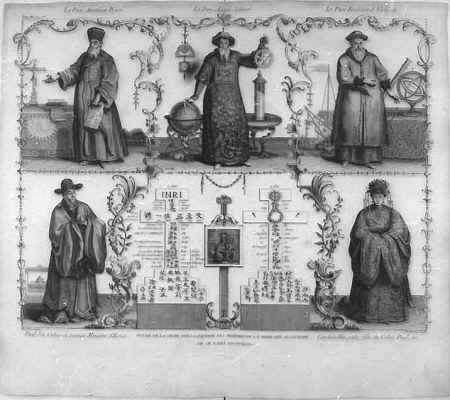 Jesuit scholars in China. Top: Matteo Ricci, Adam Schall and Ferdinand Verbiest (1623–88); Bottom: Paul Siu (Xu Guangqi), Colao or Prime Minister of State, and his granddaughter Candide Hiu. Between the sixteenth and eighteenth centuries, the teaching of science in Jesuit schools, as laid down in the Ratio atque Institutio Studiorum Societatis Iesu ("The Official Plan of studies for the Society of Jesus") of 1599,[229] was almost entirely based on the works of Aristotle. The Jesuits, nevertheless, have made numerous significant contributions to the development of science.[21] For example, the Jesuits have dedicated significant study to fields from cosmology to seismology, the latter of which has been described as "the Jesuit science".[230] The Jesuits have been described as "the single most important contributor to experimental physics in the seventeenth century".[231] According to Jonathan Wright in his book God's Soldiers, by the eighteenth century the Jesuits had "contributed to the development of pendulum clocks, pantographs, barometers, reflecting telescopes and microscopes – to scientific fields as various as magnetism, optics, and electricity. They observed, in some cases before anyone else, the colored bands on Jupiter's surface, the Andromeda nebula, and Saturn's rings. They theorized about the circulation of the blood (independently of Harvey), the theoretical possibility of flight, the way the moon affected the tides, and the wave-like nature of light."[232] The Jesuit China missions of the 16th and 17th centuries introduced Western science and astronomy. One modern historian writes that in late Ming courts, the Jesuits were "regarded as impressive especially for their knowledge of astronomy, calendar-making, mathematics, hydraulics, and geography".[233] The Society of Jesus introduced, according to Thomas Woods, "a substantial body of scientific knowledge and a vast array of mental tools for understanding the physical universe, including the Euclidean geometry that made planetary motion comprehensible".[234] |
科学 関連項目:イエズス会の科学者一覧  中国におけるイエズス会の学者。上段:マテオ・リッチ、アダム・シャル、フェルディナンド・ヴェルビスト(1623年~1688年);下段:ポール・シウ(徐光啓)、コラオまたは国務大臣、および孫娘のカンディド・ヒウ。 16世紀から18世紀にかけて、イエズス会の学校における科学の教育は、1599年の『イエズス会における研究の公式計画』(「The Official Plan of studies for the Society of Jesus」)に定められたように、ほぼ完全にアリストテレスの著作に基づいたものだった。 それでもイエズス会は、科学の発展に多大な貢献をしてきた。[21] 例えば、イエズス会は宇宙論から地震学まで、幅広い分野に多大な研究を捧げており、後者は「イエズス会の科学」と表現されている。[230] イエズス会は「17世紀の実験物理学に最も貢献した団体」と表現されている。[231] ジョナサン・ライトの著書『神の兵士たち』によると、 イエズス会は18世紀までに「振り子時計、パンタグラフ、晴雨計、反射望遠鏡、顕微鏡など、磁気、光学、電気などさまざまな科学分野の発展に貢献した。彼 らは、木星の表面の色の帯、アンドロメダ星雲、土星の環を、時には他の誰よりも早く発見した。彼らは血液の循環(ハーヴェイとは独立して)、飛行の理論的 可能性、月が潮汐に与える影響、光の波動性などについて理論を立てた。」[232] 16世紀と17世紀のイエズス会の中国宣教団は西洋の科学と天文学を伝えた。ある現代の歴史家は、明の宮廷ではイエズス会士は「特に天文学、暦作成、数 学、水力学、地理学の知識で印象的であった」と記している。[233] トマス・ウッズによると、イエズス会は「惑星の運動を理解できるユークリッド幾何学を含む、物理的な宇宙を理解するための膨大な科学的知識と精神的なツー ル」を導入した。[234] |
| Notable members Main article: List of Jesuits See also: List of Jesuit theologians and List of Jesuit scientists Notable Jesuits include missionaries, educators, scientists, artists, philosophers, and a pope. Among many distinguished early Jesuits was Francis Xavier, a missionary to Asia who converted more people to Catholicism than anyone before, and Robert Bellarmine, a Doctor of the Church. José de Anchieta and Manuel da Nóbrega, founders of the city of São Paulo, Brazil, were Jesuit priests. Another famous Jesuit was Jean de Brébeuf, a French missionary who was martyred during the 17th century in what was once New France (in the portion of which, is now Ontario) in Canada. In Spanish America, José de Acosta wrote a major work on early Peru and New Spain with important material on indigenous peoples. In South America, Peter Claver was notable for his mission to African slaves, building on the work of Alonso de Sandoval. Francisco Javier Clavijero was expelled from New Spain during the Suppression of the Society of Jesus in 1767 and wrote an important history of Mexico during his exile in Italy. Eusebio Kino is renowned in the southwestern United States and northern Mexico (an area then called the Pimería Alta). He founded numerous missions and served as the peace-bringer between the tribes and the government of New Spain. Antonio Ruiz de Montoya was an important missionary in the Jesuit reductions of Paraguay. Baltasar Gracián was a 17th-century Spanish Jesuit and baroque prose writer and philosopher. He was born in Belmonte, near Calatayud (Aragon). His writings, particularly El Criticón (1651–57) and Oráculo Manual y Arte de Prudencia ("The Art of Prudence", 1647) were lauded by Schopenhauer and Nietzsche. In Scotland, John Ogilvie, a Jesuit, is the nation's only post-Reformation saint. Gerard Manley Hopkins was one of the first English poets to use sprung verse. Anthony de Mello was a Jesuit priest and psychotherapist who became widely known for his books which introduced Westerners to the East Indian traditions of spirituality. Dorothy Lawson was a recusant and patroness of the Society of Jesus,[235] who met yearly at her home to discuss the mission in England after the English Reformation.[236] Cardinal Jorge Bergoglio of Argentina was elected by conclave as Pope Francis on March 13th 2013 and is the first Jesuit to be elected pope.[237] The Feast of All Jesuit Saints and Blesseds is celebrated on 5 November.[238] |
著名な会員 詳細は「イエズス会の一覧」を参照 イエズス会の神学者一覧」、「イエズス会の科学者一覧」も参照 著名なイエズス会員には宣教師、教育者、科学者、芸術家、哲学者、教皇などがいる。初期の著名なイエズス会員には、アジアへの宣教師であり、それ以前の誰 よりも多くの人々をカトリックに改宗させたフランシスコ・ザビエルや、教会博士のロベルト・ベルアミーノなどがいる。ブラジルのサンパウロ市の創設者であ るホセ・デ・アンシェッタとマヌエル・ダ・ノブレガはイエズス会の司祭であった。 また、17世紀にカナダのニューフランス(現在のオンタリオ州)で殉教したフランス人宣教師ジャン・ド・ブレブーフも有名なイエズス会士であった。 スペイン領アメリカでは、ホセ・デ・アコスタが先住民に関する重要な資料を盛り込んだ初期のペルーとヌエバ・エスパーニャに関する主要な著作を著した。南 アメリカでは、ペドロ・クラヴェールが、アロンソ・デ・サンドヴァルの業績を基に、アフリカ人奴隷への布教活動で知られた。フランシスコ・ハビエル・クラ ヴィエロは、1767年のイエズス会解散の際にヌエバ・エスパーニャから追放され、イタリアへの亡命中にメキシコの重要な歴史を著した。エウセビオ・キノ は、アメリカ南西部およびメキシコ北部(当時ピメリャ・アルタと呼ばれていた地域)で名高い。彼は多数の伝道所を設立し、部族とヌエバ・エスパーニャ政府 の間の平和の使者として活躍した。アントニオ・ルイス・デ・モンタヤは、パラグアイのイエズス会伝道所における重要な宣教師であった。 バルタサル・グラシアンは、17世紀のスペインのイエズス会士であり、バロック時代の散文作家、哲学者である。アラゴン州カラタユド近郊のベルモンテで生 まれた。彼の著作、特に『クリティコン』(1651年~1657年)と『オラクル・マヌアル・イ・アルテ・デ・プルーデンシア』(『思慮分別大全』、 1647年)は、ショーペンハウアーやニーチェに賞賛された。 スコットランドでは、イエズス会のジョン・オグルヴィが国民唯一の宗教改革後の聖人である。 ジェラード・マンリー・ホプキンスは、跳躍詩を用いた最初の英国詩人の一人である。アンソニー・デ・メロは、イエズス会の司祭であり心理療法家であったが、西洋人に東インドの精神性の伝統を紹介した著書で広く知られるようになった。 ドロシー・ローソンは、イエズス会の信奉者であり後援者でもあった[235]。彼女は、英国の宗教改革後、イングランドにおけるミッションについて話し合うために、毎年自宅で会合を開いていた[236]。 アルゼンチンのホルヘ・ベルゴリオ枢機卿は、2013年3月13日にコンクラーベによってフランシスコ教皇に選出され、教皇に選出された初のイエズス会員となった[237]。 イエズス会の聖人および福者の祝祭は11月5日に祝われる。[238] |
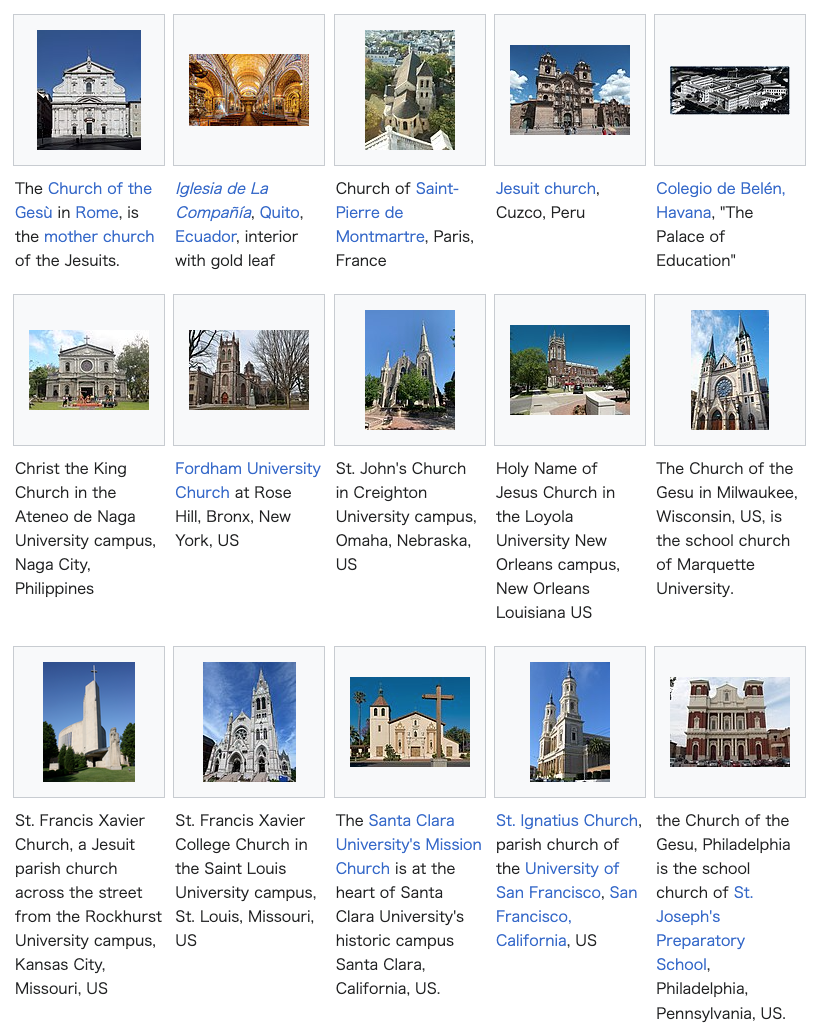 |
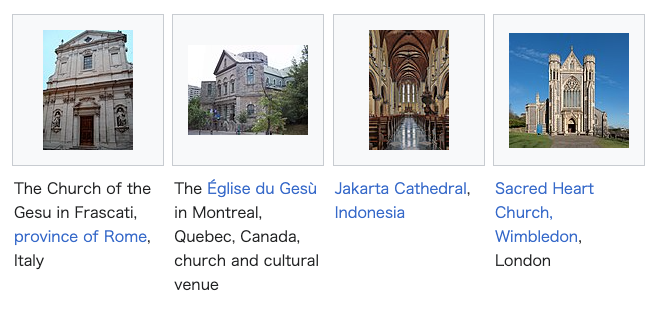 |
| Institutions Educational institutions See also: List of Jesuit educational institutions Although the work of the Jesuits today embraces a wide variety of apostolates, ministries, and civil occupations, they are probably most well known for their educational work, on all continents. Since the inception of the order, Jesuits have been teachers. Besides serving on the faculty of Catholic and secular schools, the Jesuits are the Catholic religious order with the second highest number of schools which they run: 168 tertiary institutions in 40 countries and 324 secondary schools in 55 countries. (The Brothers of the Christian Schools have over 560 Lasallian educational institutions.) They also run elementary schools at which they are less likely to teach. Many of the schools are named after Francis Xavier and other prominent Jesuits. After the Second Vatican Council, Jesuit schools had become a very controversial place of instruction as they abandoned teaching traditional Catholic education with things such as the mastery of Latin and the Baltimore Catechism. Jesuit schools replaced classic theological instruction from people like Thomas Aquinas and Bonaventure to people like Karl Rahner and Pierre Teilhard de Chardin which was a very controversial move at the time.[239][240] Jesuit educational institutions aim to promote the values of Eloquentia Perfecta. This is a Jesuit tradition that focuses on cultivating a person as a whole, as one learns to speak and write for the common good. Social and development institutions Jesuits have become increasingly involved in works directed primarily toward social and economic development for the poor and marginalized.[241] Included in this would be research, training, advocacy, and action for human development, as well as direct services. Most Jesuit schools have an office that fosters social awareness and social service in the classroom and through extracurricular programs, usually detailed on their websites. The Jesuits also run over 500 notable or stand-alone social or economic development centres in 56 countries around the world. |
教育機関 教育機関 関連情報:イエズス会の教育機関一覧 今日、イエズス会の活動は、使徒職、聖職、民間職業など多岐にわたるが、おそらく最もよく知られているのは、教育活動であろう。イエズス会は、その設立以 来、教師として活動してきた。イエズス会は、カトリック系および世俗系の学校の教員として教鞭をとっているほか、運営する学校の数ではカトリックの修道会 の中で2番目に多い。40カ国に168の高等教育機関、55カ国に324の中等教育機関を運営している。(キリスト教学校のブラザーは、560以上のラ サール教育機関を運営している。)また、小学校も運営しているが、そこでは教えることは少ない。多くの学校は、フランシスコ・ザビエルやその他の著名なイ エズス会士にちなんで名付けられている。 第二バチカン公会議の後、イエズス会の学校はラテン語の習得やボルティモア・カテキズムなどの伝統的なカトリック教育を放棄したため、非常に物議を醸す教 育の場となった。イエズス会の学校は、トマス・アクィナスやボナヴェントゥラのような古典的神学の指導者を、カール・ラーナーやピエール・テイヤール・ ド・シャルダンといった人物に置き換えたが、これは当時非常に物議を醸す動きであった。 イエズス会の教育機関は、エロクエンティア・ペルフェクタの価値観の促進を目指している。これは、共通善のために話し、書くことを学ぶ中で、人格の全体的な育成に焦点を当てるイエズス会の伝統である。 社会開発機関 イエズス会は、貧困層や社会から疎外された人々を対象とした社会経済開発事業にますます深く関わるようになってきている。[241] これには、人間開発のための研究、訓練、提唱、行動、および直接的なサービスが含まれる。ほとんどのイエズス会系の学校には、社会問題への意識を高め、課 外プログラムを通じて社会奉仕を促進する部署があり、通常、そのウェブサイトに詳細が記載されている。イエズス会はまた、世界56カ国で500以上の著名 な、あるいは独立した社会・経済開発センターを運営している。 |
| Publications The Sanctuary of Loyola in Azpeitia, Basque Country, Spain, the main Jesuit shrine in the birthplace of Ignatius of Loyola Jesuits are also known for their involvement in publications. Most Jesuit colleges and universities have their own presses which produce a variety of books, book series, textbooks, and academic publications. La Civiltà Cattolica, a periodical produced in Rome by the Jesuits, has often been used as a semi-official platform for popes and officials of the Roman Curia to float ideas for discussion or hint at future statements or positions, though authorship is limited to Jesuits.[242] The Way is an international journal of contemporary Christian spirituality published by the British Jesuits.[243] In the United States of America, America magazine has long had a prominent place in Catholic intellectual circles[244] Ignatius Press, founded by a Jesuit, is an independent publisher of Catholic books, most of which are of the popular academic or lay-intellectual variety.[245] Manresa is a review of Ignatian spirituality published in Madrid, Spain.[246] In Australia, the Jesuits produce a number of magazines, including Eureka Street, Madonna, Australian Catholics, and Province Express. In Germany, the Jesuits publish the journal Geist und Leben and the related publication Weltweit[247] that describes their international work (the Jesuitenmission) In Sweden the Catholic cultural magazine Signum, edited by the Newman Institute, covers a broad spectrum of issues concerning faith, culture, research, and society. The printed version of Signum is published eight times per year.[248] |
出版物 スペイン、バスク地方アスペイティアにあるロヨラ聖堂は、イグナティウス・ロヨラの生誕地にあるイエズス会の主要な聖堂である。 イエズス会は出版活動でも知られている。イエズス会のほとんどの大学には独自の印刷所があり、さまざまな書籍、書籍シリーズ、教科書、学術出版物を刊行している。 イエズス会士によってローマで発行された定期刊行物『ラ・チヴィタ・カトリカ』は、しばしば教皇やローマ教皇庁の役人たちが議論のためのアイデアを提示し たり、将来の声明や立場を暗示したりするための半公式のプラットフォームとして利用されてきたが、執筆者はイエズス会士に限られている。[242] ザ・ウェイ』は、現代のキリスト教精神に関する国際的な学術誌であり、英国のイエズス会士によって発行されている。[243] アメリカ合衆国では、雑誌『America』は長年にわたりカトリックの知識人の間で重要な位置を占めてきた[244]。イエズス会士によって設立された イグナティウス・プレスは、カトリック関連書籍の独立系出版社であり、そのほとんどは一般向けの学術書や一般知識人のための書籍である[245]。 マニレサは、スペインのマドリードで発行されているイグナチオ会の霊性に関するレビューである[246]。 オーストラリアでは、イエズス会は『Eureka Street』、『Madonna』、『Australian Catholics』、『Province Express』を含む多くの雑誌を発行している。 ドイツでは、イエズス会は『Geist und Leben』誌と、その国際的な活動(イエズス会宣教)を伝える関連出版物『Weltweit』を発行している。 スウェーデンでは、ニューマン研究所が編集するカトリック文化誌『Signum』が、信仰、文化、研究、社会に関する幅広い問題を取り上げている。Signum』の印刷版は年8回発行されている。[248] |
| Ad maiorem Dei gloriam Apostleship of Prayer Blas Valera Bollandist Canadian Indian residential school system Jesuit conspiracy theories Jesuit Ivy Jesuit missions among the Guaraní Jesuit Missions of Chiquitos Jesuit Refugee Service List of Jesuit sites List of saints of the Society of Jesus Misiones Province Missionaries Monumenta Historica Societatis Iesu Igreja de São Roque Sexual abuse scandal in the Society of Jesus Thomas Weld (of Lulworth) |
神の栄光のために 祈りの使徒職 ブラス・バレラ ボランド協会 カナダのインディアン寄宿学校制度 イエズス会陰謀論 イエズス会アイビー グアラニー族に対するイエズス会の宣教 チキトスのイエズス会伝道所 イエズス会難民奉仕 イエズス会関連サイト一覧 イエズス会聖人一覧 ミシオネス管区 宣教師 イエズス会史料集 サン・ロッケ教会 イエズス会における性的虐待スキャンダル トマス・ウェルド(ルルワースの) |
| Sources Adelaar, Willem F.H. (2004). "Review of Kaskaskia Illinois-to-French Dictionary edited by Carl Masthay". International Journal of Lexicography. 17 (3): 325–327. doi:10.1093/ijl/17.3.325. ISSN 1477-4577. Ashworth, William B. (1986). "Catholicism and Early Modern Science". In Lindberg, David C.; Numbers, Ronald L. (eds.). God and Nature: Historical Essays on the Encounter between Christianity and Science. Berkeley: University of California Press. ISBN 978-0-520-05538-4. Bailey, Gauvin Alexander (1999). Art on the Jesuit Missions in Asia and Latin America, 1542–1773. Toronto: University of Toronto Press. ISBN 0-8020-4688-6. Bailey, Gauvin Alexander (2003). Between Renaissance and Baroque: Jesuit Art in Rome, 1565–1610. Toronto: University of Toronto Press. ISBN 0-8020-3721-6. Brading, D. A. (1991). The First America: Spanish Monarchs, Creole Patriots, and the Liberal State, 1492–1867. Cambridge: Cambridge University Press. ISBN 978-0-521-39130-6. Campbell, Thomas J. (1921). The Jesuits, 1534–1921: A History of the Society of Jesus from Its Foundation to the Present Time. New York: The Encyclopedia Press. ISBN 978-0878210183. Retrieved 19 June 2017. Carpenter, Roger M. (2004). The Renewed, The Destroyed, and the Remade: The Three Thought Worlds of the Iroquois and the Huron, 1609–1650. East Lansing: Michigan State University Press. ISBN 978-0-87013-728-0. Cline, Sarah L. (1997). "Church and State: Habsburg New Spain". In Werner, Michael S. (ed.). Encyclopedia of Mexico: History, Society & Culture. Vol. 1. Chicago: Fitzroy Dearborn Publishers. ISBN 978-1-884964-31-2. Coyle, Henry (1908). Our church, her Children and Institutions. Vol. 2. Boston: Angel Guardian Press. Curran, Robert Emmett (1993). The Bicentennial History of Georgetown University. Washington, D.C.: Georgetown University Press. ISBN 978-0-87840-485-8. Delaney, Paul J.; Nicholls, Andrew D. (1989). After The Fire: Sainte-Marie Among the Hurons Since 1649. Elmvale, Ontario: East Georgian Bay Company. Devine, E. J. (1925). The Jesuit Martyrs of Canada. Toronto: The Canadian Messenger. Durant, Will; Durant, Ariel (1961). The Age of Reason Begins: A History of European Civilization in the Period of Shakespeare, Bacon, Montaigne, Rembrandt, Galileo, and Descartes, 1558–1648. The Story of Civilization. Vol. 7. New York: Simon & Schuster. ISBN 978-0-671-01320-2. Ebrey, Patricia Buckley (2010). The Cambridge Illustrated History of China. Cambridge: Cambridge University Press. ISBN 978-0-521-12433-1. Fraser, Antonia (2005) [1996]. The Gunpowder Plot: Terror and Faith in 1605. London: Phoenix. ISBN 978-0-7538-1401-7. Gerard, John (1911). "Monita Secreta". In Herbermann, Charles (ed.). Catholic Encyclopedia. Vol. 10. New York: Robert Appleton Company. Gonzalez, Justo L. (1985). The Story of Christianity: The Early Church to the Present Day. Hobson, John M. (2004). The Eastern Origins of Western Civilisation. Cambridge: Cambridge University Press. Höpfl, Harro (2004). Jesuit Political Thought: The Society of Jesus and the State, c. 1540–1630. Cambridge: Cambridge University Press. ISBN 978-0-521-83779-8. Hough, Susan Elizabeth (2007). Richter's Scale: Measure of an Earthquake, Measure of a Man. Princeton, New Jersey: Princeton University Press. ISBN 978-0-691-12807-8. Ivereigh, Austen (2014). The Great Reformer: Francis and the Making of a Radical Pope. New York: Henry Holt and Co. ISBN 978-1-62779-157-1. Kennedy, J. H. (1950). Jesuit and Savage in New France. New Haven, CN: Yale University Press. Konrad, Herman W. (1980). A Jesuit Hacienda in Colonial Mexico: Santa Lucía, 1576–1767. Stanford, CA: Stanford University Press. ISBN 978-0-8047-1050-3. Lapomarda, Vincent A. (2005). The Jesuits and the Third Reich (2nd ed.). Lewiston, New York: Edwin Mellen Press. ISBN 978-0-7734-6265-6. Mahoney, Kathleen A. (2003). Catholic Higher Education in Protestant America: The Jesuits and Harvard in the Age of the University. Baltimore, Maryland: Johns Hopkins University Press. ISBN 978-0-8018-7340-9. Maryks, Robert Aleksander (2010). The Jesuit Order As a Synagogue of Jews: Jesuits of Jewish Ancestry and Purity-of-Blood Laws in the Early Society of Jesus. Studies in Medieval and Reformation Traditions. Vol. 146. Leiden, Netherlands: Brill. ISBN 978-90-04-17981-3. Mecham, J. Lloyd (1966). Church and State in Latin America: A History of Politico-Ecclesiastical Relations (2nd ed.). Chapel Hill: University of North Carolina Press. Müller, Andreas; Tausch, Arno; Zulehner, Paul M.; Wickens, Henry, eds. (2000). Global Capitalism, Liberation Theology, and the Social Sciences: An Analysis of the Contradictions of Modernity at the Turn of the Millennium. Hauppauge, New York: Nova Science Publishers. ISBN 978-1-56072-679-1. Mungello, David E., ed. (1994). The Chinese Rites Controversy: Its History and Meaning. Monumenta Serica Monograph Series. Vol. 33. Nettetal, Germany: Steyler Verlag. ISBN 978-3-8050-0348-3. Nelson, Robert J. (1981). Pascal: Adversary and Advocate. Cambridge, Massachusetts. O'Malley, John W. (1993). The First Jesuits. Cambridge, Massachusetts: Harvard University Press. ISBN 978-06-7430-313-3. ——— (2006). "Introduction". In O'Malley, John W.; Bailey, Gauvin Alexander; Harris, Steven J.; Kennedy, T. Frank (eds.). The Jesuits II: Cultures, Sciences, and the Arts, 1540–1773. University of Toronto Press. ISBN 978-0-8020-3861-6. Padberg, John W. (1994). For Matters of Greater Moment:The First Thirty Jesuit General Congregations. St. Louis, Missouri: Institute of Jesuit Sources. ISBN 978-1-880810-06-4. Painter, F. V. N. (1903). A History of Education. International Education Series. Vol. 2. New York: D. Appleton and Co. Paquin, Julien (1932). The Tragedy of Old Huron. Sault Ste. Marie, Ontario: The Martyrs' Shrine. Parker, John (1978). Windows into China: The Jesuits and their Books, 1580–1730. Maury A. Bromsen Lecture in Humanistic Bibliography. Vol. 5. Boston: Trustees of the Public Library of the City of Boston. ISBN 978-0-89073-050-8. Retrieved 18 June 2017. Perrin, Pat (1970). Crime and Punishment: The Colonial Period to the New Frontier. Discovery Enterprises. Pollard, John (2006). "Jesuits, The". In Blamires, Cyprian P. (ed.). World Fascism: A Historical Encyclopedia. Vol. 1. Santa Barbara, California: ABC-CLIO. pp. 356–357. ISBN 978-1-57607-940-9. Pollen, John Hungerford (1912). "Society of Jesus". In Herbermann, Charles (ed.). Catholic Encyclopedia. Vol. 14. New York: Robert Appleton Company. Reites, James W. (1981). "St. Ignatius of Loyola and the Jews". Studies in the Spirituality of Jesuits. 13 (4). St. Louis, Missouri: American Assistancy Seminar on Jesuit Spirituality. ISSN 2328-5575. Archived from the original on 6 May 2017. Retrieved 18 June 2017. Sacks, Richard S. (1990). "Historical Setting" (PDF). In Hanratty, Dennis M.; Meditz, Sandra (eds.). Paraguay: A Country Study. Area Handbook Series (2nd ed.). Washington, D.C.: U.S. Government Printing Office. pp. 1–49. Archived (PDF) from the original on 26 September 2020. Retrieved 18 June 2017. Sandoval, Alonso de (2008). Von Germeten, Nicole (ed.). Treatise on Slavery: Selections from De Instauranda Aethiopum Salute. Translated by von Germeten, Nicole. Indianapolis, Indiana: Hackett Publishing Co. ISBN 978-0-87220-929-9. Shirer, William L. (1960). The Rise and Fall of the Third Reich. London: Secker & Warburg. Udías, Agustín (2003). Searching the Heavens and the Earth: The History of Jesuit Observatories. Astrophysics and Space Science Library. Berlin: Springer. ISBN 978-1-4020-1189-4. Vacalebre, Natale (2016). Come Le Armadure e L'Armi. Per una storia delle antiche biblioteche della Compagnia di Gesù. Con il caso di Perugia. Biblioteca di bibliografia – Documents and Studies in Book and Library History, vol. 205. Florence: Olschki. ISBN 978-8822-26480-0. Warren, J. Benedict (1973). "An Introductory Survey of Secular Writings in the European Tradition on Colonial Middle America, 1503–1818". In Cline, Howard F. (ed.). Handbook of Middle American Indians. Vol. 13: Guide to Ethnohistorical Sources, Part Two. Austin: University of Texas Press (published 2015). pp. 42–137. ISBN 978-1-4773-0683-3. Van Handel, Robert Michael (1991). The Jesuit and Franciscan Missions in Baja California (MA thesis). University of California, Santa Barbara. Woods, Thomas E. (2005). How The Catholic Church Built Western Civilization. Washington, D.C.: Regnery Publishing (published 2012). ISBN 978-1-59698-328-1. Wright, Jonathan (2004). God's Soldiers: Adventure, Politics, Intrigue, and Power: A History of the Jesuits. New York: Doubleday Religious Publishing Group (published 2005). ISBN 978-0-385-50080-7. |
出典 Adelaar, Willem F.H. (2004). 「Review of Kaskaskia Illinois-to-French Dictionary edited by Carl Masthay」. International Journal of Lexicography. 17 (3): 325–327. doi:10.1093/ijl/17.3.325. ISSN 1477-4577. Ashworth, William B. (1986). 「Catholicism and Early Modern Science」. In Lindberg, David C.; Numbers, Ronald L. (eds.). God and Nature: Historical Essays on the Encounter between Christianity and Science. Berkeley: University of California Press. ISBN 978-0-520-05538-4. ベイリー、ガウヴィン・アレクサンダー(1999年)。アジアとラテンアメリカにおけるイエズス会伝道地の芸術、1542年~1773年。トロント:トロント大学出版。ISBN 0-8020-4688-6。 ベイリー、ガウヴィン・アレクサンダー(2003年)。ルネサンスとバロックの間:ローマにおけるイエズス会の芸術、1565年~1610年。トロント:トロント大学出版局。ISBN 0-8020-3721-6。 Brading, D. A. (1991). 『最初のアメリカ:スペイン君主、クレオール愛国者、そして自由主義国家、1492年~1867年』ケンブリッジ:ケンブリッジ大学出版局。ISBN 978-0-521-39130-6。 キャンベル、トーマス・J. (1921年). 『イエズス会、1534年~1921年:イエズス会の歴史、創設から現代まで』。ニューヨーク:エンサイクロペディア・プレス。ISBN 978-0878210183。2017年6月19日取得。 Carpenter, Roger M. (2004). The Renewed, The Destroyed, and the Remade: The Three Thought Worlds of the Iroquois and the Huron, 1609–1650. East Lansing: Michigan State University Press. ISBN 978-0-87013-728-0. Cline, Sarah L. (1997). 「Church and State: Habsburg New Spain」. In Werner, Michael S. (ed.). Encyclopedia of Mexico: History, Society & Culture. Vol. 1. Chicago: Fitzroy Dearborn Publishers. ISBN 978-1-884964-31-2. Coyle, Henry (1908). Our church, her Children and Institutions. Vol. 2. Boston: Angel Guardian Press. Curran, Robert Emmett (1993). The Bicentennial History of Georgetown University. Washington, D.C.: Georgetown University Press. ISBN 978-0-87840-485-8. デリー、ポール J.; ニコルズ、アンドリュー D. (1989年). 火災の後: 1649年以降のヒューロン族のサント・マリー. エルムベール、オンタリオ州: イースト・ジョージアン・ベイ・カンパニー. デバイン、E. J. (1925年). カナダのイエズス会殉教者. トロント: カナディアン・メッセンジャー. デュラント、ウィル、デュラント、アリエル(1961年)。『理性の時代が始まる:シェイクスピア、ベーコン、モンテーニュ、レンブラント、ガリレオ、デ カルトの時代におけるヨーロッパ文明の歴史、1558年~1648年。文明の歴史。第7巻。ニューヨーク:サイモン&シュスター。ISBN 978-0-671-01320-2。 エブリー、パトリシア・バックリー(2010年)。『ケンブリッジ図説中国史』ケンブリッジ:ケンブリッジ大学出版局。ISBN 978-0-521-12433-1。 フレイザー、アントニア(2005年)[1996年]。『火薬陰謀事件:1605年の恐怖と信仰』ロンドン: フェニックス. ISBN 978-0-7538-1401-7. ジェラルド、ジョン(1911年)。「Monita Secreta」。ハーバマン、チャールズ(編)『カトリック百科事典』第10巻。ニューヨーク:ロバート・アップルトン・カンパニー。 ゴンザレス、フスト・L.(1985年)。『キリスト教の歴史:初期の教会から現代まで』。 ホブソン、ジョン・M. (2004年)。『西洋文明の東方的起源』ケンブリッジ:ケンブリッジ大学出版局。 ヘップル、ハロ (2004年)。『イエズス会の政治思想:イエズス会と国家、1540年~1630年』ケンブリッジ:ケンブリッジ大学出版局。ISBN 978-0-521-83779-8。 Hough, Susan Elizabeth (2007). Richter's Scale: Measure of an Earthquake, Measure of a Man. Princeton, New Jersey: Princeton University Press. ISBN 978-0-691-12807-8. Ivereigh, Austen (2014). The Great Reformer: Francis and the Making of a Radical Pope. New York: Henry Holt and Co. ISBN 978-1-62779-157-1. Kennedy, J. H. (1950). Jesuit and Savage in New France. New Haven, CN: Yale University Press. コンラッド、ハーマン・W. (1980年). 植民地時代のメキシコにおけるイエズス会の農園:サンタルシア、1576年~1767年. スタンフォード、カリフォルニア州: スタンフォード大学出版局. ISBN 978-0-8047-1050-3. ラポマルダ、ヴィンセント A. (2005年). 『イエズス会と第三帝国』(第2版). ニューヨーク州ルイストン: エドウィン・メレン出版. ISBN 978-0-7734-6265-6. マホーニー、キャスリーン・A. (2003年). プロテスタントのアメリカにおけるカトリック系高等教育:大学時代のイエズス会とハーバード大学. メリーランド州ボルチモア:ジョンズ・ホプキンス大学出版局. ISBN 978-0-8018-7340-9. Maryks, Robert Aleksander (2010). ユダヤ人のシナゴーグとしてのイエズス会:ユダヤ系イエズス会員とイエズス会初期の純血法。中世および宗教改革の伝統に関する研究。第146巻。オラン ダ、ライデン:ブリル。ISBN 978-90-04-17981-3。 Mecham, J. Lloyd (1966). 教会と国家のラテンアメリカ:政治と教会の関係の歴史(第2版)。チャペルヒル:ノースカロライナ大学出版。 Müller, Andreas; Tausch, Arno; Zulehner, Paul M.; Wickens, Henry, eds. (2000). Global Capitalism, Liberation Theology, and the Social Sciences: An Analysis of the Contradictions of Modernity at the Turn of the Millennium. Hauppauge, New York: Nova Science Publishers. ISBN 978-1-56072-679-1. Mungello, David E., ed. (1994). The Chinese Rites Controversy: Its History and Meaning. Monumenta Serica Monograph Series. Vol. 33. Nettetal, Germany: Steyler Verlag. ISBN 978-3-8050-0348-3. ネルソン、ロバート・J. (1981年). 『パスカル:敵対者と擁護者』. マサチューセッツ州ケンブリッジ. オマリー、ジョン・W. (1993年). 『最初のイエズス会』. マサチューセッツ州ケンブリッジ: ハーバード大学出版局. ISBN 978-06-7430-313-3. —— (2006). 「序論」. In O'Malley, John W.; Bailey, Gauvin Alexander; Harris, Steven J.; Kennedy, T. Frank (eds.). The Jesuits II: Cultures, Sciences, and the Arts, 1540–1773. University of Toronto Press. ISBN 978-0-8020-3861-6. ジョン・W・パドバーグ著(1994年)。重大な事柄のために:最初の30回イエズス会総会。ミズーリ州セントルイス:イエズス会資料研究所。ISBN 978-1-880810-06-4。 ペインター、F. V. N. (1903年). 教育の歴史。国際教育シリーズ。第2巻。ニューヨーク:D. アプルトン・アンド・カンパニー。 パキン、ジュリアン (1932年). オールド・ヒューロン神父の悲劇。オンタリオ州ソール・セント・マリー:殉教者聖堂。 パーカー、ジョン(1978年)。中国への窓:イエズス会とその著書、1580年~1730年。人文主義的文献学モーリー・A・ブロムセン講座。第5巻。ボストン:ボストン市立図書館理事。ISBN 978-0-89073-050-8。2017年6月18日取得。 ペリン、パット(1970年)。『罪と罰:植民地時代から新フロンティアまで』ディスカバリー・エンタープライズ。 ポラード、ジョン(2006年)。「イエズス会」。ブラミレス、シプリアン・P.(編)『世界ファシズム:歴史事典』第1巻。カリフォルニア州サンタバーバラ:ABC-CLIO。356–357. ISBN 978-1-57607-940-9. Pollen, John Hungerford (1912). 「Society of Jesus」. In Herbermann, Charles (ed.). Catholic Encyclopedia. Vol. 14. New York: Robert Appleton Company. Reites, James W. (1981). 「St. Ignatius of Loyola and the Jews」. Studies in the Spirituality of Jesuits. 13 (4). St. Louis, Missouri: American Assistancy Seminar on Jesuit Spirituality. ISSN 2328-5575. 2017年5月6日オリジナルよりアーカイブ。2017年6月18日閲覧。 Sacks, Richard S. (1990). 「Historical Setting」 (PDF). In Hanratty, Dennis M.; Meditz, Sandra (eds.). Paraguay: A Country Study. Area Handbook Series (2nd ed.). Washington, D.C.: U.S. Government Printing Office. pp. 1–49. Archived (PDF) from the original on 26 September 2020. Retrieved 18 June 2017. サンドヴァル、アロンゾ・デ(2008年)。 フォン・ジャーマテン、ニコル(編)。奴隷制に関する論文:『デ・インスタウランダ・エチオポゥム・サルテ』からの抜粋。フォン・ジャーマテン、ニコル 訳。インディアナ州インディアナポリス:ハケット出版。ISBN 978-0-87220-929-9。 Shirer, William L. (1960). The Rise and Fall of the Third Reich. London: Secker & Warburg. Udías, Agustín (2003). Searching the Heavens and the Earth: The History of Jesuit Observatories. Astrophysics and Space Science Library. Berlin: Springer. ISBN 978-1-4020-1189-4. Vacalebre, Natale (2016). Come Le Armadure e L'Armi. Per una storia delle antiche biblioteche della Compagnia di Gesù. Con il caso di Perugia. Biblioteca di bibliografia – Documents and Studies in Book and Library History, vol. 205. Florence: Olschki. ISBN 978-8822-26480-0. ウォーレン、J. ベネディクト(1973年)。「ヨーロッパの伝統における植民地時代の中部アメリカに関する世俗的な著作の入門的概観、1503年~1818年」。 編者:ハワード・F・クライン。『中部アメリカ・インディアン事典』第13巻:民族誌的情報源ガイド、第2部。オースティン: テキサス大学出版局 (2015年出版). pp. 42–137. ISBN 978-1-4773-0683-3. ヴァン・ハンデル、ロバート・マイケル (1991年). バハ・カリフォルニアにおけるイエズス会とフランシスコ会の宣教活動 (修士論文). カリフォルニア大学、サンタバーバラ校. ウッズ、トーマス・E. (2005年). 『カトリック教会が西洋文明をいかに築いたか』. ワシントンD.C.: Regnery Publishing (2012年出版). ISBN 978-1-59698-328-1. ライト、ジョナサン(2004年)。『神の兵士たち:冒険、政治、陰謀、そして権力:イエズス会の歴史』。ニューヨーク:ダブルデイ・リリジオス・パブリッシング・グループ(2005年発行)。ISBN 978-0-385-50080-7。 |
| Further reading Surveys  History of the Jesuit missions in India, China and Japan (Luis de Guzmán, 1601). Bangert, William V. A History of the Society of Jesus (2nd ed. 1958) 552 pp. Barthel, Manfred. Jesuits: History & Legend of the Society of Jesus (1984) 347 pp. online free Chapple, Christopher. Jesuit Tradition in Education & Missions: A 450-Year Perspective (1993), 290 pp. Mitchell, David. Jesuits: A History (1981) 320 pp. Molina, J. Michelle. To Overcome Oneself: The Jesuit Ethic and Spirit of Global Expansion, 1520–1767 (2013) online Archived 18 May 2018 at the Wayback Machine O'Malley, John W. The Jesuits: A History from Ignatius to the Present (2014), 138 pp Worcester, Thomas. ed. The Cambridge Companion to the Jesuits (2008), to 1773 Wright, Jonathan. God's Soldiers: Adventure, Politics, Intrigue & Power: A History of the Jesuits (2004) 368 pp online free Specialized studies Alden, Dauril. Making of an Enterprise: The Society of Jesus in Portugal, Its Empire & Beyond, 1540–1750 (1996). Brockey, Liam Matthew. Journey to the East: The Jesuit Mission to China, 1579–1724 (2007). Brodrick James (1940). The Origin of the Jesuits. Originally Published Longmans Green. ISBN 9780829409307., Special Edition Published 1997 by Loyola University Press, US. ISBN 0829409300. Brodrick, James. Saint Francis Xavier (1506–1552) (1952). Brodrick, James. Saint Ignatius Loyola: The Pilgrim Years 1491–1538 (1998). Burson, Jeffrey D. and Jonathan Wright, eds. The Jesuit Suppression in Global Context: Causes, Events, and Consequences (Cambridge UP, 2015). Bygott, Ursula M. L. With Pen & Tongue: The Jesuits in Australia, 1865–1939 (1980). Comerford, Kathleen M. Jesuit Libraries. Brill, 2023. [ISBN missing] Dalmases, Cándido de. Ignatius of Loyola, Founder of the Jesuits: His Life & Work (1985). [ISBN missing] Caraman, Philip. Ignatius Loyola: A Biography of the Founder of the Jesuits (1990). Edwards, Francis. Jesuits in England from 1580 to the Present Day (1985). Grendler, Paul F. "Jesuit Schools and Universities in Europe 1548–1773." Brill Research Perspectives in Jesuit Studies 1.1 (2019): 1–118. online Archived 23 January 2022 at the Wayback Machine Healy, Róisin. Jesuit Specter in Imperial Germany (2003). [ISBN missing] Höpfl, Harro. Jesuit Political Thought: The Society of Jesus & the State, c. 1540–1640 (2004). Hsia, Ronnie Po-chia. "Jesuit Foreign Missions. A Historiographical Essay." Journal of Jesuit Studies (2014) 1#1, pp. 47–65. Kaiser, Robert Blair. Inside the Jesuits: How Pope Francis is Changing the Church and the World (Rowman & Littlefield, 2014) Klaiber, Jeffrey. The Jesuits in Latin America: 1549–2000:: 450 Years of Inculturation, Defense of Human Rights, and Prophetic Witness. St Louis, MO: Institute of Jesuit Sources 2009. Lapomarda, Vincent A., The Catholic Bishops of Europe and the Nazi Persecutions of Catholics and Jews, Lewiston, New York: Edwin Mellen Press (2012) McCoog, Thomas M., ed. Mercurian Project: Forming Jesuit Culture: 1573–1580 (2004) (30 advanced essays by scholars). Martin, A. Lynn. Jesuit Mind. The Mentality of an Elite in Early Modern France (1988). O'Malley, John. "The Society of Jesus." in R. Po-chia Hsia, ed., A Companion to the Reformation World (2004), pp. 223–236. O'Malley, John W. ed. Saints or Devils Incarnate? Studies in Jesuit History (2013). Parkman, Francis (1867). The Jesuits in North America in the Seventeenth Century (PDF). p. 637. Archived from the original (PDF) on 9 May 2012. Retrieved 25 April 2012. Pomplun, Trent. Jesuit on the Roof of the World: Ippolito Desideri's Mission to Tibet. Oxford University Press (2010). Roberts, Ian D. Harvest of Hope: Jesuit Collegiate Education in England, 1794–1914 (1996). Ronan, Charles E. and Bonnie B. C. Oh, eds. East Meets West: The Jesuits in China, 1582–1773 (1988). Ross, Andrew C. Vision Betrayed: The Jesuits in Japan & China, 1542–1742 (1994). Santich, Jan Joseph. Missio Moscovitica: The Role of the Jesuits in the Westernization of Russia, 1582–1689 (1995). Schmiedl, Joachim (2011). Religious Orders as Transnational Networks of the Catholic Church Archived 24 September 2021 at the Wayback Machine, EGO – European History Online Archived 8 February 2013 at the Wayback Machine, Mainz: Institute of European History Archived 19 February 2016 at the Wayback Machine, retrieved: 25 March 2021 (pdf Archived 17 January 2022 at the Wayback Machine). Wright, Jonathan. "From Immolation to Restoration: The Jesuits, 1773–1814." Theological Studies (2014) 75#4 pp. 729–745. Zhang, Qiong. Making the New World their own: Chinese encounters with Jesuit science in the age of discovery (Brill, 2015). United States Cushner, Nicholas P. Soldiers of God: The Jesuits in Colonial America, 1565–1767 (2002) 402 pp. Garraghan, Gilbert J. The Jesuits Of The Middle United States (3 vol 1938) covers Midwest from 1800 to 1919 vol 1 online; vol 2; vol 3 McDonough, Peter. Men astutely trained : a history of the Jesuits in the American century (1994), covers 1900 to 1960s; online free Schroth, Raymond A. The American Jesuits: A History (2009) Primary sources Desideri, Ippolito. "Mission to Tibet: The Extraordinary Eighteenth-Century Account of Father Ippolito Desideri." Translated by Michael J. Sweet. Edited by Leonard Zwilling. Boston: Wisdom Publications, 2010. Donnelly, John Patrick, ed. Jesuit Writings of the Early Modern Period: 1540–1640 (2006) In German Klaus Schatz. Geschichte der deutschen Jesuiten: Bd. 1: 1814–1872 Münster: Aschendorff Verlag, 2013. XXX, 274 S. ISBN 978-3-402-12964-7. online review Schatz. Geschichte der deutschen Jesuiten: Bd. 2: 1872–1917 Schatz. Geschichte der deutschen Jesuiten: Bd. 3: 1917–1945 Schatz. Geschichte der deutschen Jesuiten: Bd. 4: 1945–1983 Schatz. Geschichte der deutschen Jesuiten: Bd. 5: Quellen, Glossar, Biogramme, Gesamtregister |
さらに詳しく 調査  インド、中国、日本におけるイエズス会の宣教の歴史(ルイス・デ・グスマン、1601年)。 バンガート、ウィリアム・V. イエズス会の歴史(第2版、1958年)552ページ。 バートル、マンフレッド。イエズス会:イエズス会の歴史と伝説(1984年)347ページ。オンラインで無料公開 チャップル、クリストファー著『教育と宣教におけるイエズス会の伝統:450年の視点』(1993年)、290ページ。 ミッチェル、デビッド著『イエズス会:その歴史』(1981年)320ページ モリーナ、J. ミシェル著『自己を克服するために:イエズス会の倫理とグローバルな拡大の精神、1520年~1767年』(2013年)オンライン 2018年5月18日アーカイブ分 オマリー、ジョン・W. 『イエズス会:イグナティウスから現代までの歴史』(2014年)、138ページ ウスター、トーマス編 『ケンブリッジ・イエズス会事典』(2008年)、1773年まで ライト、ジョナサン 『神の兵士たち:冒険、政治、陰謀、権力:イエズス会の歴史』(2004年)、368ページ、オンラインで無料公開中 専門研究 Alden, Dauril. Making of an Enterprise: The Society of Jesus in Portugal, Its Empire & Beyond, 1540–1750 (1996). Brockey, Liam Matthew. Journey to the East: The Jesuit Mission to China, 1579–1724 (2007). Brodrick James (1940). 『イエズス会の起源』。初版はLongmans Greenより刊行。ISBN 9780829409307.、特別版は1997年にLoyola University Press(米国)より刊行。ISBN 0829409300. Brodrick, James. 『聖フランシスコ・ザビエル(1506–1552)』 (1952). ブロドリック、ジェームズ著。聖イグナチオ・ロヨラ:巡礼時代 1491年~1538年(1998年)。 バーソン、ジェフリー・D.およびジョナサン・ライト編著。グローバルな文脈におけるイエズス会の弾圧:原因、出来事、および結果(ケンブリッジ大学出版、2015年)。 Bygott, Ursula M. L. 『With Pen & Tongue: The Jesuits in Australia, 1865–1939』(1980年) Comerford, Kathleen M. 『Jesuit Libraries』(ブリル、2023年) [ISBN 欠落] Dalmases, Cándido de. 『Ignatius of Loyola, Founder of the Jesuits: His Life & Work』(1985年) [ISBN 欠落] カラマン、フィリップ。イグナティウス・ロヨラ:イエズス会創設者の伝記(1990年)。 エドワーズ、フランシス。1580年から現代までのイングランドにおけるイエズス会(1985年)。 Grendler, Paul F. 「Jesuit Schools and Universities in Europe 1548–1773.」 Brill Research Perspectives in Jesuit Studies 1.1 (2019): 1–118. online Archived 23 January 2022 at the Wayback Machine Healy, Róisin. Jesuit Specter in Imperial Germany (2003). [ISBN missing] Höpfl, Harro. 『イエズス会の政治思想:イエズス会と国家、1540年頃~1640年』(2004年)。 Hsia, Ronnie Po-chia. 「イエズス会の海外宣教。史学論考」。『イエズス会研究ジャーナル』(2014年)1#1、47~65ページ。 カイザー、ロバート・ブレア著『イエズス会内部:教皇フランシスコが教会と世界をいかに変革しているか』(ロウマン&リトルフィールド、2014年) クライベ、ジェフリー著『ラテンアメリカにおけるイエズス会:1549年~2000年:450年にわたる文化への同化、人権擁護、預言者的証言』(ミズーリ州セントルイス:イエズス会資料研究所、2009年) ラポマルダ、ヴィンセント・A著『ヨーロッパのカトリック司教とナチスによるカトリック教徒とユダヤ人への迫害』、ニューヨーク州ルイストン:エドウィン・メレン・プレス(2012年) マククーグ、トーマス・M編『メルクリウス・プロジェクト:イエズス会文化の形成:1573年~1580年』(2004年)(学者による高度な30の論文)。 マーティン、A・リン著『 『イエズス会の精神』。近世フランスにおけるエリートの精神性(1988年)。 オマリー、ジョン。「イエズス会」R. ポ-チア・シア編『宗教改革の世界』(2004年)223-236ページ。 オマリー、ジョン・W. 編『聖人か悪魔の化身か?イエズス会史研究』(2013年)。 パークマン、フランシス(1867年)。17世紀の北米におけるイエズス会(PDF)。637ページ。2012年5月9日オリジナル(PDF)よりアーカイブ。2012年4月25日取得。 ポムプラン、トレント。世界の屋根の上のイエズス会士:イッポリト・デシデリのチベットへのミッション。オックスフォード大学出版(2010年)。 ロバーツ、イアン・D. 『希望の収穫:イギリスにおけるイエズス会の大学教育、1794年~1914年』(1996年)。 ローナン、チャールズ・E.、ボニー・B. C. オー編 『東と西の出会い:中国におけるイエズス会、1582年~1773年』(1988年)。 ロス、アンドリュー C. 『裏切られたビジョン:日本と中国におけるイエズス会、1542年~1742年』(1994年)。 サニッチ、ヤン・ジョセフ。『モスクワ宣教:ロシアの西洋化におけるイエズス会の役割、1582年~1689年』(1995年)。 シュミードル、ヨアヒム(2011年)。「カトリック教会のトランスナショナル・ネットワークとしての修道会」『ヨーロッパ史オンライン』2021年9月 24日アーカイブ(PDF)2013年2月8日アーカイブ(PDF)マインツ:ヨーロッパ史研究所、2016年2月19日アーカイブ(PDF)2021年 3月25日取得。 ライト、ジョナサン。「犠牲から復興へ:イエズス会、1773年から1814年」。『神学研究』(2014年)75巻4号、729-745ページ。 チャン、チオン。『新世界を自分たちのものにする:大航海時代における中国人とイエズス会の科学』(ブリル、2015年)。 アメリカ合衆国 クシュナー、ニコラス・P. 『神の兵士たち:植民地時代のアメリカにおけるイエズス会、1565年~1767年』(2002年)402ページ ギャラガン、ギルバート・J. 『アメリカ中部のイエズス会』(全3巻、1938年)は、1800年から1919年までの中西部をカバー。第1巻オンライン版、第2巻、第3巻 マクドナー、ピーター著『賢く訓練された男たち:アメリカン・センチュリーにおけるイエズス会の歴史』(1994年)は、1900年から1960年代までをカバーしている。オンラインで無料公開中 シュロス、レイモンド・A著『アメリカン・イエズス会:その歴史』(2009年) 一次資料 デシデリ、イッポリト。「チベットへの宣教:イッポリト・デシデリ神父による18世紀の驚くべき記録」。マイケル・J・スウィート訳。レナード・ズヴィリング編。ボストン:ウィズダム・パブリケーションズ、2010年。 ドネリー、ジョン・パトリック編。近現代のイエズス会文書:1540年~1640年(2006年) ドイツ語では Klaus Schatz. Geschichte der deutschen Jesuiten: Bd. 1: 1814–1872 Münster: Aschendorff Verlag, 2013. XXX, 274 S. ISBN 978-3-402-12964-7. online review Schatz. Geschichte der deutschen Jesuiten: Bd. 2: 1872–1917 シャッツ著『ドイツ人イエズス会の歴史』第3巻:1917年~1945年 シャッツ著『ドイツ人イエズス会の歴史』第4巻:1945年~1983年 シャッツ著『ドイツ人イエズス会の歴史』第5巻:資料、用語集、人物伝、総索引 |
| https://en.wikipedia.org/wiki/Jesuits |
|
リ ンク
文 献
そ の他の情報
CC
Copyleft,
CC, Mitzub'ixi Quq Chi'j, 1996-2099